Introduction: Hybrid Culture in a Changing World
Remember 2020? With the Covid pandemic in full swing, cultural organizations were forced to re-evaluate their workflows, business models, and the types of events they organized. How to deal with the temporary breaks in on-site programming along with financial losses? Out of this extreme condition, a new attitude emerged regarding digital exhibition formats, live broadcasting, and the overall online presence of cultural actors. A newer, shinier format loomed at the horizon: the hybrid event.
We’ve seen videolive streams set up on a spacestage, with performancespeakers giving a lecture and no audience except the viewers at home behind their computer; clunky live events with pre-recorded interviews that pixelate with every hesitation of the WiFi; videoInstagram Lives that nobody watches or that everyone is watching; countless videoZoom live streams with break-out rooms and tens of people on audiomute, fighting the Zoom fatigue or their clingy cat. Already in November 2020, Geert Lovink wrote about the phenomenon of Zoom fatigue: Geert Lovink, ‘The Anatomy of Zoom Fatique’, Eurozine, 21 November 2020, https://networkcultures.org/geert/2020/11/21/anatomy-of-zoom-fatigue. And we’ve also seen marvelous experiments: objecta big screen on a spacelive stage that shows a lively, textonline chat which is actually integrated into the conversation; performancea buddy system where an offline visitor takes their online friend by the hand (meaning, on their phone) and guides them through an spaceexhibition, event, Q&A’s with speakers live on stage.
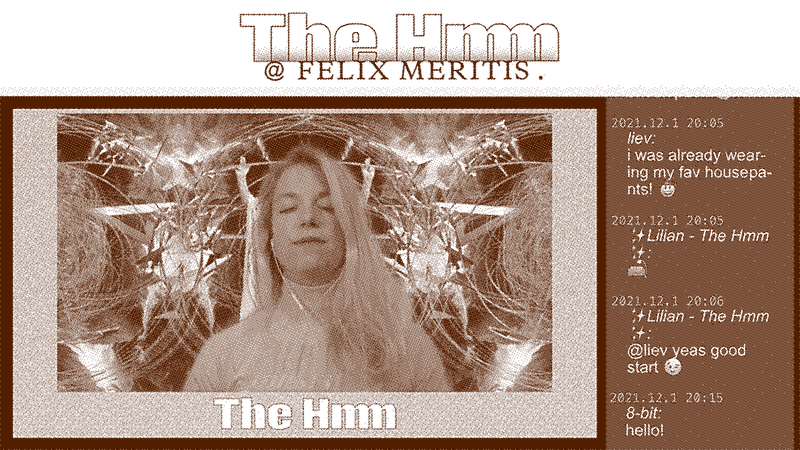
Many exciting, experimental formats were tested by platform for internet culture The Hmm. You can read a report on these experiments in The Hmm’s dossier ‘Hybrid Events’: https://thehmm.nl/the-hybrid-formats-we-tested.
We’ve witnessed performanceTravis Scott playing a concert in the game websiteFortnite, for a whopping 27 million viewers—and he wasn’t the only one. Roel Vergauwen, ‘Will Games Become the New Concert Temples?’, Boekman, https://catalogus.boekman.nl/pub/P21-0355.pdf. Cultural institutions, usually relying on their audience having to travel to an offline destination to attend an event, found that they could reach a bigger and more international audience, and on top of that, speakers didn’t need to travel which saves both time and costs. Also, the common use of videolivestreams and textcaptions created new accessibility features for audience groups with different needs. It became possible to be sick and participate in culture, to be cooking dinner for your children and participate in culture, to have hearing impairments and participate in culture. These needs existed before the pandemic and will exist in the future too. It remains important not to forget the issue of accessibility now that on-site programming is the norm once again.
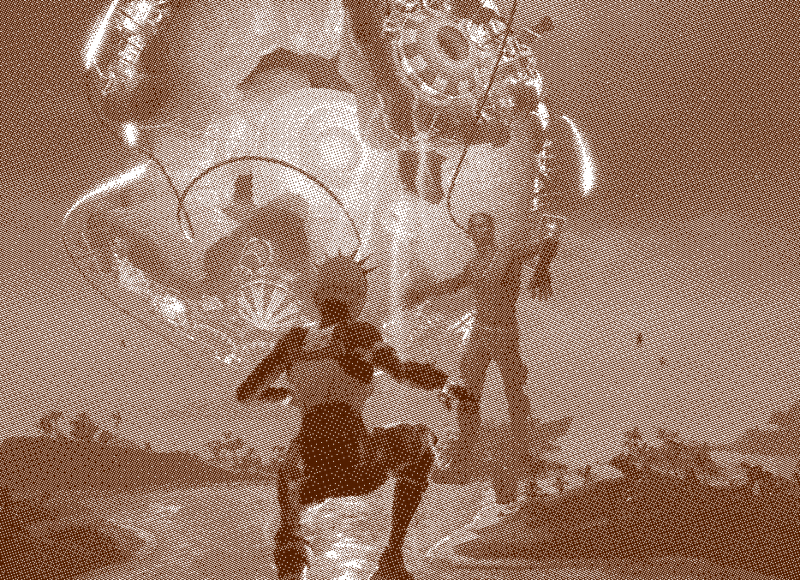
A lockdown concert by Travis Scott in Fortnite with a live audience of 27 million.
These are only some of the many advantages hybrid events can offer, and it doesn’t stop there: hybridity gives way to exciting new experiments in publishing, or the development of ‘living archives’ that share these beautiful hybrid experiments in an interactive, dynamic way. Because of course, a truly fun hybrid event is hard to translate into a videotwo-hour video registration put on YouTube, however much we want to share the experience with the people who couldn’t make it. This, interestingly, is mostly because the hybrid event incorporates a live experience found formerly in the offline event: it has transformed itself into a whole new kind of experience. Two worlds that once seemed so far apart now smoothly (or not so smoothly) collided and merged into new, hybrid constellations.
About the Going Hybrid Research Project
This book brings together the insights from two years of hands-on, state-of the art research in hybrid cultural programs: Going Hybrid. Going Hybrid was supported with a RAAK-Mkb grant from Regieorgaan SIA. You can read more about the project here: https://networkcultures.org/goinghybrid/about. For this project, the Institute of Network cultures partnered up with cultural institutions (Framer Framed, IMPAKT, MU) and self-organizing collectives (Hackers & Designers, The Hmm, Varia members Simon Browne and Artemis Gryllaki) to explore how covid innovations in cultural programming could be turned into durable, culturally valuable formats. Our central question was: How can program providers in the cultural and creative industries connect new and existing audiences to a hybrid, high-quality cultural program in a sustainable and technologically independent manner?
The research consisted of three parts. One was about hybrid events. How to create interesting new forms of hybrid interaction? How do they ensure that both groups have an equal experience at these videolivecasts? And how to give both on-site and online audiences a sense of agency in an event? The other two parts were about what happens after the event: the publication, and ultimately the archiving of the outcomes. How to translate a hybrid cultural experience into something visitors can videowatch, textread, follow afterward? Is it possible to capture the essence, the interactive essence, of a hybrid event and reproduce it? And how do they harness the potential of this recorded material for publication and lasting audience interaction in their websitedigital (web) archive? Three groups, corresponding with the three main questions, set out research (the use of) existing platforms, to gather expertise, and ultimately to develop a prototype tool for hybrid culture.
The events group created Emoji Proxis & Ghost Messengers, a tool for interaction between on-line and on-site audiences, giving online audience direct agency over things that happen in space. For instance, by typing a command in the livestream chat, online audience members can performanceactivate an on-site scentscent objectdispenser, or performancephysically move objectthe camera. A version of this tool was presented during the Going Hybrid conference. Read more about this tool and the workshop here: https://networkcultures.org/goinghybrid/2023/03/29/workshop-emoji-proxies-ghost-messengers-conference-report-day-2.
The publications group developed Etherport: a tool for cultural organisations to make more experimental and exciting. In Etherport, event reports including texttext, videovideo, still imageimage, and audiosound are connected by a web of tags, drawing non-linear connections between different parts of the event report, and between different reports. The tool helps to standardize the event reporting workflow, reducing production workload and clarifying the role division between authors and editors. But, most importantly, it allows for event-reports to connect different levels of knowledge and observations, to create a web of meaning between reports, and thereby – hopefully – to provide a more exciting, explorative reading experience. You can read more about this tool and how to use it in the intermission ‘Introducing Etherport’.
The research of the archives group resulted in MUMORIES, an audioaudio spaceinstallation where visitors are invited to share their memories of cultural institution MU Hybrid Art House. These memories are collected and form a websiteliving digital audio archive that can eventually be listened to on site but also online. The growing collection of MUMORIES made possible by this interface literally gives voice to the immaterial impact a cultural practice like MU’s has on visitors. You can explore and interact with MUMORIES online here: https://mumories.hackersanddesigners.nl/Welcome.
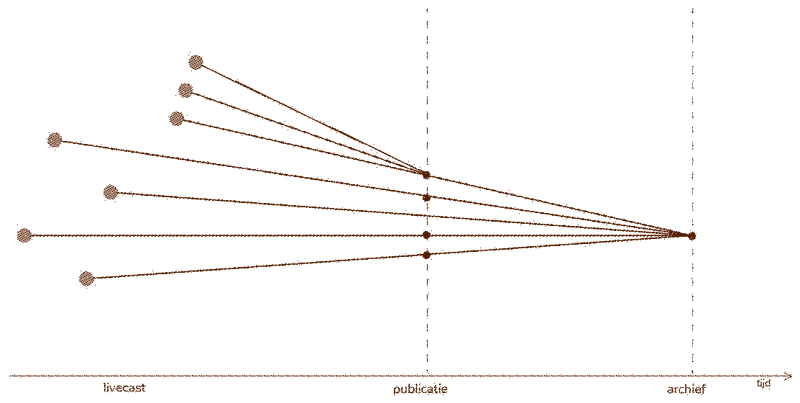
The workflow of multiple hybrid events, converging a few hybrid publications, and, finally, into one living archive. This graph was created in 2020 for the project appplication by Marijn Bril.
We’re proud and happy to put these prototype tools out into the public domain. But they are not three separate experiments. Together, the three parts of Going Hybrid encompass the entire workflow of hybrid cultural programming: via participatory livecasting of events, the coherent reporting of these through publications that eventually enter living archives. This integral approach reflects a broader urgency that was shared between all members of the consortium. We all wanted to go beyond the misery that comes to mind when someone says ‘hybrid meeting’.
Yes, the physical and digital have mixed and merged in hybrid new realities, but we yearned to explore hybridity beyond that: across media and spaces, challenging conceptions of hierarchy, access, time, and voices, that often come with different cultural experiences. How does hybridity shift the reading, writing, and publishing process? How can an archive become alive? And how can an audience interact in hybrid events? It was by confronting the first initial questions with deeper ones that we found meaning in this collective endeavour. We believed that the integral redefinition of hybridity can be the basis for a long-term, shared vision of high-quality hybrid cultural programing that serves new and existing audiences beyond the covid era.
Multiplying Urgencies
Already within the duration of Going Hybrid, our belief in the relevance of new hybrid culture was put to the test, as the ‘beyond Covid’-urgency we anticipated arrived much sooner than we expected. On the 24th of February 2022, Russia launched a full-scale invasion of Ukraine. While many artists, journalists, and researchers fled the country, the desire for a shared cultural life remained, creating the need being together with culture across borders and distances.
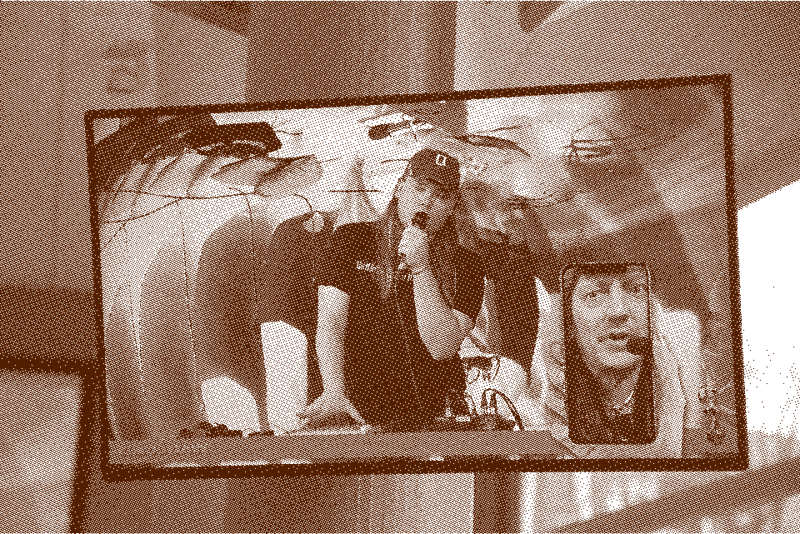
UKRAiNATV contributing to ‘In-between Media: Hybrid Tactics in the Crisis Era’, 9 March 2023 at Spui 25, Amsterdam.
The Institute of Network Cultures set up a Tactical Media Room to give space to underrepresented voices: artists, researchers, and journalists from Ukraine, as well as dissidents from Russia and Belarus. Tactical Media Room can be found on the website of the Institute of Network Cultures: https://networkcultures.org/tactical-media-room. Since then, the Tactical Media Room has developed, and TMR Palestine was opened when the Gaza war broke out in October 2023. We embrace the slogan ‘Unity in Urgency’. Soon, the Tactical Media Room started to collaborate with UKRAiNATV, a collective based in Krakow, Poland, which hosts videoweekly webcasts that function as a cultural bridge between Lviv, Krakow, and Amsterdam. Read more about UKRAiNATV and watch back its livecasts here: https://ukrainatv.streamart.studio.
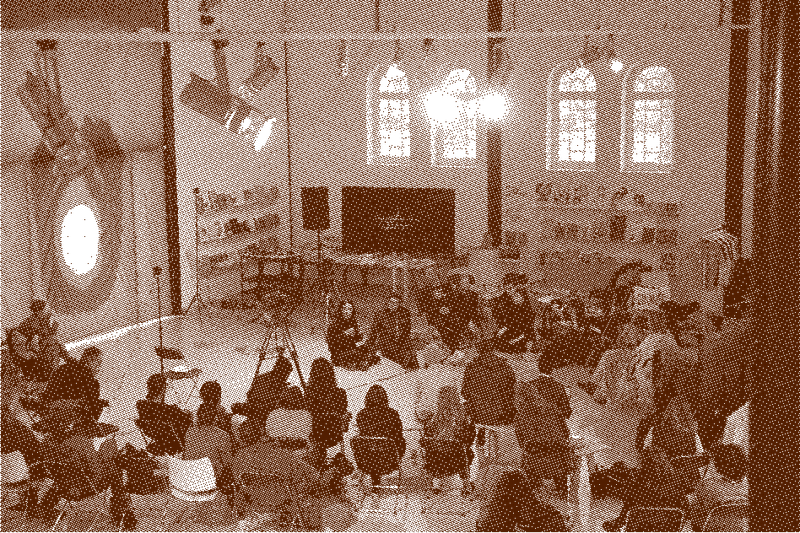
The closing session of ‘In-between Media: Hybrid Tactics in the Crisis Era’, 10 March 2023 at Framer Framed, Amsterdam.
The Tactical Media Room experience and the collaboration with UKRAiNATV were an important inspirations, which shaped the second year of Going Hybrid in multiple ways. Our mid-project conference was organized on 9 and 10 March 2023 in Amsterdam under the title ‘In-Between Media: Hybrid Tactics in the Crisis Era’, reflecting our dedication to acknowledge the simultaneity of urgencies for tactical, hybrid culture. Read the conference program and reports or watch recordings here: https://networkcultures.org/goinghybrid/in-between-media-conference. The collaboration also led us to take videolivecasting as an act of ‘expanded’ publishing more seriously and, in terms of technical approach and format, set us onto the path towards the live-publication.
This Is a Live-Publication
You may hold this objectbook in your hands, read it from your websitescreen, or encounter it as a recorded videolivestream. That’s because we practice what we preach: this book is an experiment in hybrid publishing; the first time the Institute of Network Cultures has produced an event as a book. We started with an event, which took place on the 10th of November 2023 on the websitelivestream platform of The Hmm, and then used the recording to start forking and expanding. You can watch back the full recording of Screentime Airtime Facetime on the website of The Hmm: https://live.thehmm.nl/screentimeairtimefacetime. The recording was made in the audiovisual studio of the Amsterdam University of Applied Science. Rethinking the book as starting from a videolivestream, we composed a program of elements that can exist in both an event and a book: live textchapter-performanceconversations, videopre-recorded intermissions, textchatroom annotation, and a audiospoken colophon.
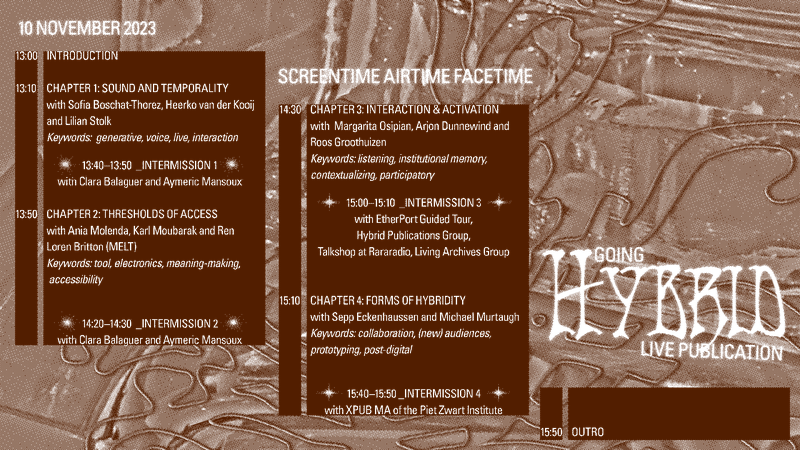
The timetable of the livestream event Screentime Airtime Facetime: A Live-Publication, which was broadcast on 11 December 2023. Design by Frédérique Gagnon.
The core of this publication consists of the conversation-chapters. These live, on-stage conversations put in conversation, quite literally, the working groups that have explored different aspects of hybridity and its outcomes in cultural settings. Chapters as presented in the written variations of this book are direct, lightly edited transcriptions of the spoken conversations. Each chapter features representatives of two research groups, joining in conversation about shared concerns or points of interest. The real outcomes of our research are therefore not entirely straightforward, fully functional ‘solutions’, but the red threads that we found to be essential in creatingmore inclusive, critical and sustainable hybrid culture - across livestreams, publications or archiving.
The first chapter, titled ‘audioSound and Temporality’, connects the Living Archives group with the Participatory Livecasting group. In both these clusters, the concepts of what it means to be present and hybrid across temporalities of past, present and future were key in developing their research and experiments.
‘Thresholds of Access’, the second chapter, reflects on what kind of mediation is necessitated by performancelive events to provide both human and technological access. In this chapter, the Participatory Livecasting group and the Hybrid Publications group joined in conversation.
The speakers in the third chapter, including people from the Living Archives group and IMPAKT, discussed ‘Interaction and Activation’. They question how relations between online and offline audiences and materials are formed, maintained and given space to become meaningful.
The next chapter involves the Hybrid Publications group and the Experimental Publishing masters of Piet Zwart to discuss different ‘Forms of Hybridity’ and what kind of axes, attitudes and approaches to hybridity overlap in their research.
The three final chapters are republished blogposts. These were not created during the live event but preceded it, and were made public on the research blog of Going Hybrid. On this research blog, the process and outcomes of each group are documented. See: https://networkcultures.org/goinghybrid. Each post elaborates on the more theoretical dimensions of one of the research groups (events, publications, archives).
Between the chapters, a series of intermissions is inserted. These contributions were prepared the research groups to give a closer insight into the glitches, awkwardness, and interruptions of hybrid cultural practices. Some function as cautionary tales of hybridity, others introduce new tools or the outcomes of experiments. Each, in its own way, is a reflection on the hands-on work done during the project.
Unfortunately, the space of a single publication – however hybrid and expanded – cannot cover all the work done within to the Going Hybrid project. Providing context and suggestions for further reading, two overviews are included at the end of this publication: a list of all events that took place in the context of Going Hybrid, and a list of all publications put out by affiliated researchers and practitioners.
The linear succession of chapters, intermissions, and appendixes allows you enjoy the content in the same order that it appeared in during the live event. But if you’re feeling more adventurous, you can pay attention to the spacemargins of this publication, which are portals to non-linear reading experiences. In the inner margins (print) or on the right-hand side of the page (digital), you will find the ‘textlive annotations’: a direct reproduction of the chat during the live event, in which a team of reporters has commented on both the contents of the program and their own experiences. Also in the inner margins (print) or on the left-hand side of the page (digital), you will find textmedium-based tags (e.g., ‘still image’, ‘audio’), indicating the kind of media and hybrids discussed. In the digital version, you can click on these tags to discover other paragraphs with the same tag, making Screentime Airtime Facetime navigable by medium as well as by linear progression. In the print version, you’ll find a more traditional index in the back of the book, showing the numbers of each page the tag appears on. Both functionalities are features of the Etherport tool, which was used to create this publication.
Exploring Hybrid Futures Together
The title Screentime Airtime Facetime hints at our shifting relation to technology. The notorious term screentime gestures towards the recent tendency to develop extremely intimate one-on-one relationships with objectour screens. Airtime gives a nod to older forms of hybrids events; the times of families gathering to audiolisten to the radio or videowatch TV. Facetime emphasises the immediate connections we foster with one another through, for instance, videothe use of video calls. With the gradual succession of these terms, we want to think through the public’s relation to technology, to collective bodies and to each other (with technology as a mediator). What can we learn from a history of different hybrid interactions and take with us as seeds for the future?
Sound and Temporality
00:02 For chapter one, we’re welcoming Carolina Valente Pinto. She’s a researcher at the Institute of Network Cultures. Carolina was the co-leader of the Living Archives group of Going Hybrid. And from the Participatory Livecasting group, we’re welcoming Lilian Stolk, the director of The Hmm, a platform for internet culture and an emoji expert. a small background information link about the living archive group here: https://networkcultures.org/goinghybrid/2022/09/21/a-living-archive-is-also-a-dying-archive She cares about understanding the internet and has a special focus on internet languages and the rise of image-based communication. Furthermore, we have Heerko van der Kooij with us on stage. He is a creative technologist working with Hackers & Designers. He gives workshops on the development of hardware and software. Welcome everybody! Fun fact, everyone participating in the event as a speaker is present today on-site, a kind of mini audience. We’re all trying to be super silent not to disturb the recording!

00:43 When we started this research project, one of the starting points was my research on liveness. Esther Hammelburg’s PhD thesis was published as a book titled Being There Live!, which you can find on her website: https://www.estherhammelburg.nl At the time, I had just finished my PhD research into what ‘liveness’ means in a cultural setting. When we discuss livenesss, people tend to focus on the present, the ‘now’, and how everything is evolving at this moment. But when you look a bit more closely, it’s not only about the ‘now’. Liveness in fact bridges both temporalities and spaces. For intance, in live experiences we often experience a ‘now’ which was anticipated beforehand. what about non-real time and non-real space? Our minds thrive in those We look forward to an experience of liveness, we think about this live event that’s coming up. Also, we tend to make videovideos and still imagephotos of performancelive events, because we want to actively create future memories in the ‘now’. In other words, we’re creating a future past in the present. A habit researched by Hammelburg is how visitors post pictures and videos of concerts and festival on Instagram to fulfil the ‘liveness’ of being here, now. Continuing to exist online, these photos and videos extend the liveness in both spatial and temporal senses. The experience of liveness is also profoundly tied to issues of memory and remembering. How do we keep our memories? How do we share our memories? How do we archive them, and what do we do with these archives? These are some elements for the discussion in this chapter. This brings me to my first question: How do you look at hybridity as a phenomenon in the here and now, and how does it relate to the ‘afterlife’? The hybrid happens ‘now’, but does it need to be recorded? Also, I am curious about the connection between time and audioaudio. Who would like to comment?
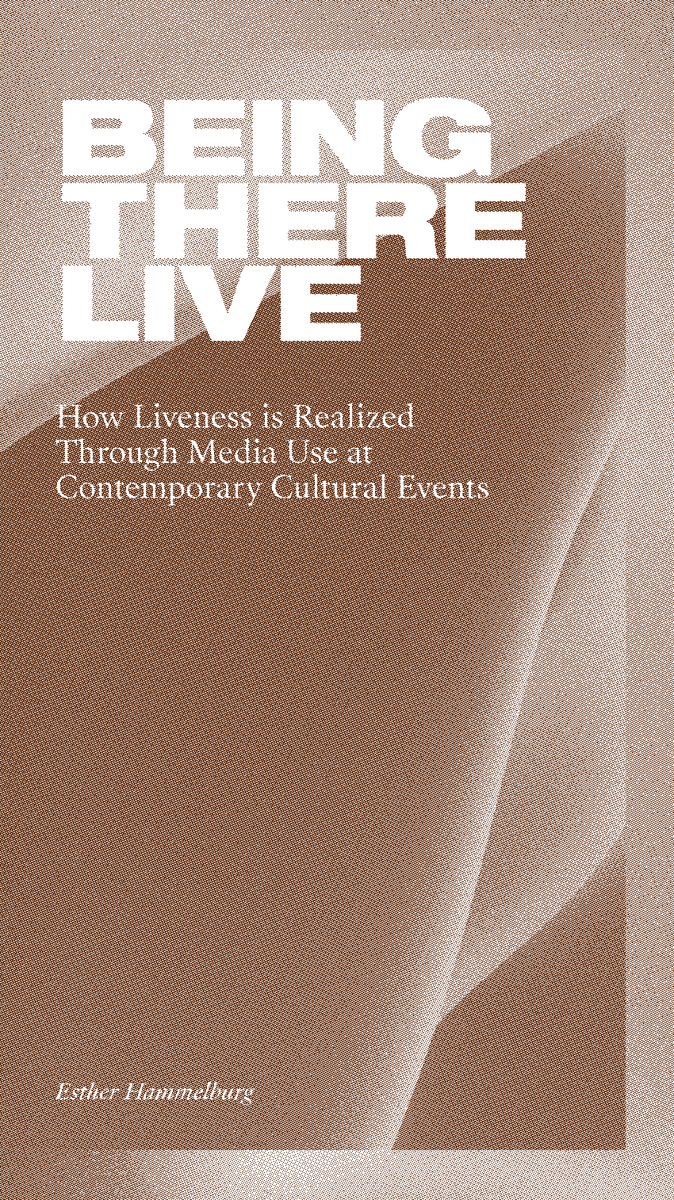
Esther Hammelburg, Being There Live! (2021).
Here, There and Everytime
03:05 Thank you for that introduction. I’m here representing the Living Archives group and our project MUMORIES. link to the MUMORIES project here: https://mumories.hackersanddesigners.nl/Listening The aspects of time and hybridity came up in Living Archives most clearly when we collected people’s memories of MU Hybrid House in Eindhoven. We tried to find out what people get from experiencing an exhibition or an event, and what they remember. Interestingly, it turned out that remembering cultural events often brings back memories from before the event itself. Hybridity is exactly this: mixing different elements into one. The Living Archive is a way to reflect on the past, present, and future, and even translating the past into possible futures. So, yes, questions of the role of the present in this afterlife is particularly present when ‘going hybrid’. In the ‘now’ of events, we have something in common: we’re all in the same space. But in what remains after, different key moments come up.
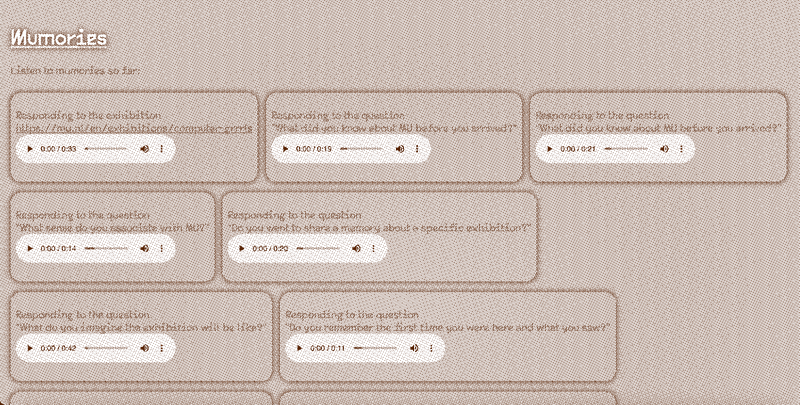
Screenshot of MUMORIES, the prototype developed by the Living Archives research group of Going Hybrid. MUMORIES is a website and it was also presented as an interactive installation at MU Hybrid Art House in the Summer of 2023.
05:12 In the Participatory Livecasting group, our research was very much focused on real-time. Specifically, we tried to give the online audience agency or presence in the on-site space. We were thinking about the ‘in the moment’ agency, which is fundamentally not something you can recreate or play back. We were not too concerned about that aspect.
05:50 But I do think we can reflect on the double notion of ‘time and space’. Space was a prominent element in our research. In a hybrid event, as we saw it, you have spacethe physical space, and many online spaces or people joining online from their own house. In the livecasting group, we built ‘Emoji Proxies & Ghost Messengers’, a tool that could make the online audience more present on-site during an event. Using commands in the livestream chat, online audiences can influence something in the space, like triggering an on-site objectlight or scenta scent diffuser in a spacespace. We aimed to make the relationship between offline and on-site audiences a bit more equal. This is difficult to achieve, especially when there is a main stage, which is the objectphysical stage. As long as we think of on-site programming as primary, it’s very difficult to give online audiences a more equal type of agency. So we tried to decenter the main stage. the virtual space is merging in the background, can it be considered non-real space? For instance, we tested the scent diffuser during an event that was focused on audioaudio. alexa this is not FaceTime app how did I get here So there was a main stage, but there were no visuals on a beamer. It was a listening event. Ultra hyper-focus on the present moment, years of preparation and research leading up to the current moment, with weeks of post-production dealing with the now. How authentic is this now then? This worked well. I think you’re in the right place, welcome!
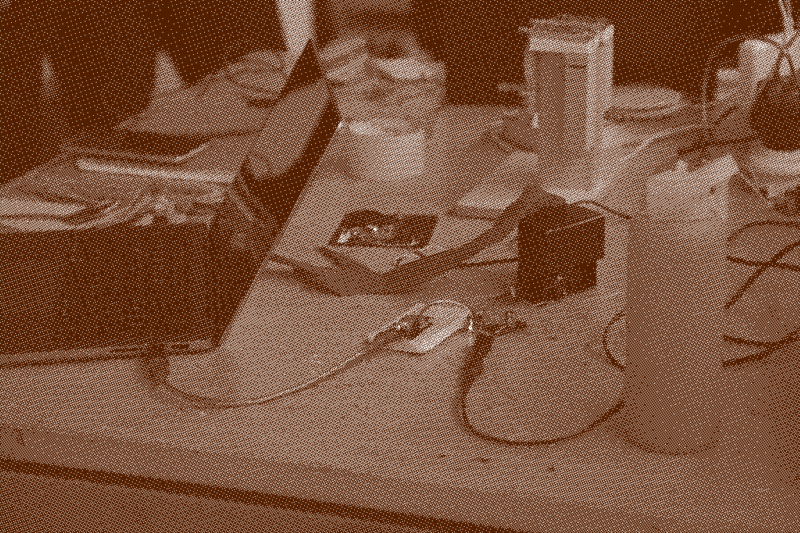
An action shot of an interactive livestreaming prototype during the Going Hybrid conference ‘In-between Media’ (March 2023).
Hybrid Senses
08:53 I have a follow-up question for Lilian. I guess so mushy, it is a background made of numbers rather than actual landscapes Your event was focused on audio as opposed to a screen and a physical space. welcome Madame Bertha Do you think that matters?
09:17 I think so. In this case, it was equalizing the relationship between online and on-site audiences. Maybe because there is one more prominent sense.
09:55 I want to continue with the topic of audioaudio. Maybe, to make audiences online and on site more equal, we also need to change the affordances and the space in which the on-site event is taking place. We cannot continue doing the same kind of offline events if we really want to change access and agency, right? And I feel there’s something about privileging hearing over vision, that challenges how we do events now. Carolina, can you tell us more about the importance of listening and how to work with the audience and audio, from the experience of the MUMORIES experiment?
10:48 MUORIES is a website and it was also presented as an interactive installation at MU during the exhibition time this summer, in which we were celebrating their 25th anniversary. Even though it was about this specific institutional history, we wanted to open it up to people who had never been there before and therefore didn’t have memories of MU. This led us to play with the idea of speculative memories. What do you think it’s going to be like? What do you think it’s going to smell like? Speculative memories were a bridge to connect practices of audiooral history to these institutional memories.
11:37 With everything that’s going on, like the war in Gaza, I think it’s important to reflect on the act of listening. Who is listening to whom? In that sense, MUMORIES which was developed in the context of an art exhibition space, opened up wider possibilities of archiving different types of records (other types of knowledge beond textfacts or numbers) in a way that’s less procedural. the camera on the left is being moved to make a better focus in the physical space Fun fact 2: this chat is not just a live chat, but also the annotation tool of Going Hybrid’s final publication. It will be included in the margins of the print book Screentime Airtime Facetime. Chatting today is co-authoring the book! As you can maybe tell, in our group, we shared a feminist understanding of memory and archiving with oral histories. We have included in this publication a part of the audioradio show ‘Talkshop’ that our group did last month in Screentime Airtime Facetime. See the intermission ‘Talkshop Mumories: Living Archives’. The program reflects on MUMORIES and the memories, on listening to each other, on the privilege that comes with speaking and listening.
13:05 Audio was not a prominent aspect of the research in the Participatory Livecasting group, but it is present. As The Hmm, we’ve been updating our websitelivestream website, moving it away from the primary focus on videomoving image and introducing alternate viewing modes. It’s possible to get different video qualities, with or without live captions. It’s also possible to select and audio only mode.
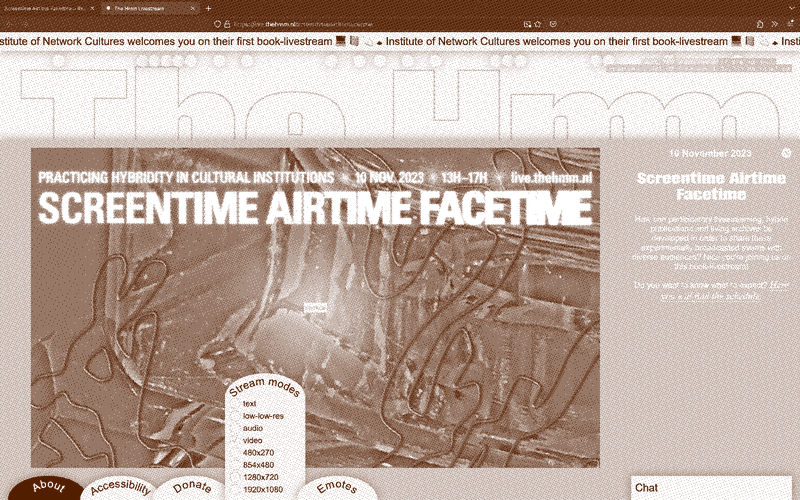
Screentime Airtime Facetime as an online live event on the livestream platform of The Hmm.
13:58 Watching implies a power structure. Some people can watch something and some people can take the stage and be watched. Is this different when giving more attention to audiolistening?
14:18 It can be more equal. I also remember that we had an event taking place at four locations. See: https://thehmm.nl/event/the-hmm-4-locations. You inspired us to do that, Esther, when you said that a good example of a hybrid experience is a football game that people watch together on a screen but also in a spacestadium. Read the interview with Esther Hammelburg by Lilian Stolk, ‘“We’re Here Together Now” Is the Crux of Every Event‘, The Hmm, 9 August 2021, https://thehmm.nl/we-are-here-together-now. Even though they’re watching a screen, they’re dressed up and watching together, which gives the feeling that they’re part of this live game. We tried to translate that into a cultural event that took place in four different places at the same time. There were two on-site speakers at every location. The rest of us watched a livestream. There was no single, big stage, because the whole event was decentralized. But then, we got feedback from the online audience saying that they missed seeing who was on-site in the different locations.
Decentering Attention
16:16 As an organizer, you have the power to make people visible or invisible, and you need to be aware of this. I’m also interested in the archives part. Did you focus only audioaudio-related or did you also play with the layering of physical and virtual spaces?
16:42 Already early on we had the idea of making a website, which is accessible at home, and an exhibition intallation with a tablet. It’s still possible to browse MUMORIES and even to contribute. Go to: https://mumories.hackersanddesigners.nl/Interaction But it wasn’t easy to integrate our multimedia experiment into an exhibition. During the opening of the exhibition, we tried to create a comfortable setting, like a spaceliving room. a living archive obviously needs a living room We had a sofa with 25 years of MU catalogs on it, inviting memories to be triggered. We also created a layered audioscape. People on-site could audiolisten to what was happening around them live, but at the same time, recorded memories were being played on the speakers. front camera is being moved too, we want some good close-ups for our hosts :)

Screenshot of the MUMORIES website.
18:18 For some years already, seeing a rise of the audiopodcast: a medium that is focused solely on audio. But, lately, we’ve come to realize that the podcast is a perfect hybrid medium because you’re always listening to podcasts while doing something else.
18:49 I was thinking exactly the same. This automatically decenters the main stage. When you have a audiopodcast or maybe a videoYouTube video that you don’t necessarily need to watch, you’re able to do a bunch of other things and suddenly spaceyour house becomes your own stage. It’s funny because, in the physical space of MU, you wanted to recreate a living room, right? Fellow audience, how are you feeling? Are we blasting into your living rooms? Do you want/have agency? But for me, since I’ve never been to MU, the experience of MUMORIES was the other way around. I was in my living room listening to memories that were created in this space I’ve never been to, and I don’t know what it looks like. It was like a dream or something from the distant past, suddenly acquiring a presence in my living room. The point of decentering the stage, of course, is to give agency to the audience, wherever they are. My next question is about this. I am enjoying sitting but being there at the same time we live in the future darlings full stop no i meant . Do you have any other examples, comments, reflections, or thoughts about audience agency?
20:08 It starts in the tool development. We didn’t develop the ideas for this toolkit by ourselves, but we organized two workshops where we asked people: what could be the ways of an online audience to have agency in this event, in spacephysical space? Then, we developed the camera that we were playing with just now and the scent diffuser we descussed before. So, from a development point of view, these tools are not made by us as prescriptive solutions to a problem, but rather by the audience itself or by the organizers of events. On-site, it does feel like a living room a little bit. It’s warm in this space, people are tip-toeing around behind the camera They aim not a grand ‘solution’, but a tiny intervention that gives the online audience some sort of presence on-site.
21:18 It was difficult to determine what kind of meaningful contributions an online audience can have in a spacespace. We often experience that it became a bit gimmicky. How to avoid audience participation and participatory events being gimmicky is a big question for sure… They could turn on a light, but how is it affecting the physical event? We also did experiments where we did it the other way around, so that the on-site audience could influence the videolivestream. For instance, by pressing a button they could let the livestream screen turn around. But that didn’t really work because it was enabling the online audience even less because the live stream view became worse. Together with MU and Affect Lab, The Hmm has been collecting many practices of hybrid culture beyond the gimmick into a publicly available repository called ‘Toolkit for the In-Between’: https://networkcultures.org/goinghybrid/2023/10/21/the-hmm-mu-and-affect-lab-launch-toolkit-for-the-in-between
22:28 We did these workshops twice, and especially the second time we really consciously took a lot of objectcraft materials and really made it hands-on, where people could invent little objectweird puppets that could be moved by the online audience. Back to listening to: I feel that if we focus on listening we shift the attention from the people who have something to say to the people who decide whether or not to pay attention. Listening involves goodwill and perhaps a form of power. It wasn’t so serious. I always say that there hasn’t been a big solution, but more playful paths. It reminded me of the early web where you could assemble your website using copy/paste, and here you could copy/paste little weird interactions.
Moving through Stories
24:18 There is one question from the chat: what about non-real-time and non-real spacespace?
24:39 I guess this question is about imagination, speculation, and fiction. Hybridity can be a mix of real and fictional. In the Living Archives group, we tried to get people to imagine ‘how it would be like’. When we think about the different temporalities and especially the afterlife, there’s a lot you can add to the experience that happened during the program. For instance, this particular publication we’re experiencing now will then become a websiteweb and textprint publication. We can add things to it. We can tell a different story. Different mediums can add different elements.
25:36 We tend to think of events as limited in time and certain. But in living archives and growing publications, we’re continuing to develop storylines or stories. The event is not the end point of a story, it’s one of the elements within a story development that could continue further with a audiopodcast or with online comments afterward… At INC, we’re experimenting with an audio-visual podcast & pop-up event format called The Void. I think it’s very interesting to explore these hybridities: https://networkcultures.org/void. Indeed, people can engage more on their own terms - whether that’s on the bike, while cooking, or in high concentration
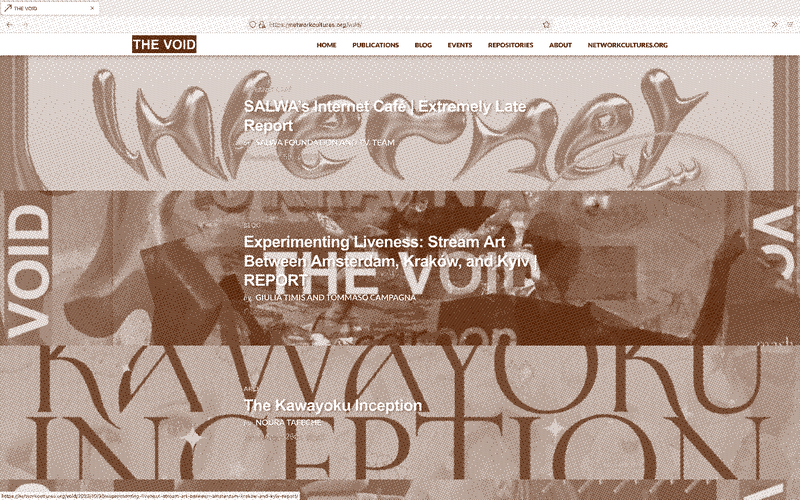
The homepage of The Void, an audiovisual podcast and platform for artistic research by the Institute of Network Cultures.
26:15 Two months ago we organized a data center tour with The Hmm. You can find the program of the Data Center Tour here: https://thehmm.nl/event/the-hmms-data-centre-tour This one was a five-hour trip, and we didn’t like the idea of such a long livestream. We instead invited podcast makers to be there and record all the speakers They also spoke with some visitors and recorded audiosounds of the data center and combined it all into a podcast episode. This different format really added value, that could not have been created if it was just a videolivestream, because it was also adding the layer of the participation of the visitors and the space with the sounds of the spacedata center. We have to remember that a livestream recording is not really recording the event… This audio report, because it also included the audience and also included the space, was a way better translation of the event. Listen back to the Data Center Tour here: https://live.thehmm.nl/the-hmm-s-data-centre-tour
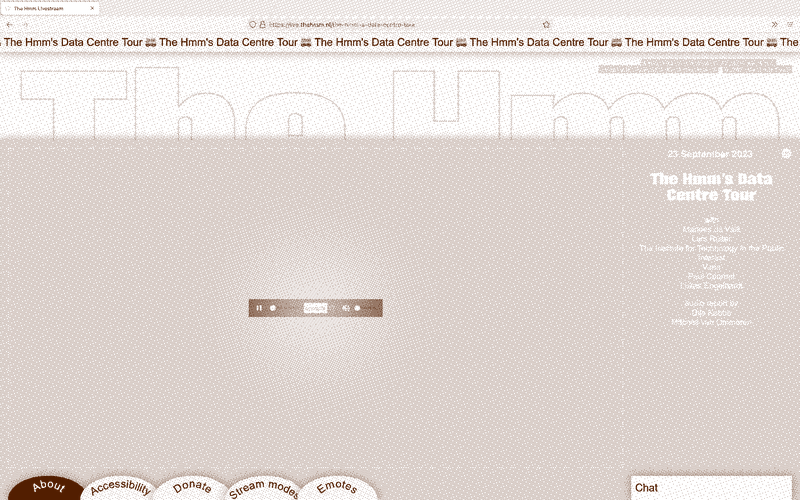
The audio-only livestream of The Hmm’s Data Center Tour.
27:38 Last question from the audience. When is a hybrid experience successful or good?
27:53 Good question. I would say when there’s interaction, especially interaction between online and on-site audiences. During Going Hybrid, Lilian wrote about the interaction between on-site and online audiences in a blog-post called ‘Participatory Livecasting’: https://networkcultures.org/goinghybrid/2022/11/17/participatory-livecasting
28:18 I would also say, winking to the next chapter, when it is accessible to both audiences and spaces. Here the interaction was made: they took my comment on non-real-time and non-real space seriously (I am not confident on the existence of these non-real realities) Success!
28:30 A successful hybrid experience includes different times, different spaces, different people. On that note, we’re wrapping up this chapter. Thank you very much.
About this text
Jordi Viader Guerrero (MX/ES) is a practice-based researcher in philosophy of technology and media, currently doing a PhD at TU Delft on the reimagining of algorithmic practices for democratic engagement. His research and practice are chiefly focused on using design and theory to articulate digital technologies within wider cultural, political, and epistemic logics.
Esther Hammelburg is a senior lecturer at the Amsterdam University of Applied Sciences and holds a PhD from the University of Amsterdam. She researched ‘liveness’: a historically evolving practice of establishing instances of ‘now here together’ through media practices which align physical and mediated environments.
Carolina Valente Pinto is a researcher at the Institute of Network Cultures and team member of The Hmm. She was the project coordinator of Going Hybrid, co-leader of the Living Archives group, and co-editor of Screentime Airtime Facetime.
Lilian Stolk is the director of The Hmm, a platform for internet culture, and an emoji expert. She was a participant of the Participatory Livecasting group of Going Hybrid.
Heerko van der Kooij is a creative technologist working with Hackers & Designers. He was also a member of the Participatory Livecasting group.
This chapter-conversation was originally recorded during the a live event Screentime Airtime Facetime, which you can watch back here: https://vimeo.com/908212301.
Hybrid Trains of Thought

Act 1
Trains are great.
You start from point A,
then you arrive at point B,
and in between you can read,
write,
sleep,
chat,
eat,
drink,
play,
even work.
But anyway,
I’m on public transport in the Netherlands,
on a spaceNederlandse Spoorwegen (NS) Intercity Direct train now,
on my way to deliver a talk with Clara at a hybrid
cultural event in Rotterdam.
The event is described as hybrid because some
people can attend on location and some can follow
online.
It sounds fancy,
but in many cases,
it just
means websiteZoom,
a videovideo projector,
objectchairs,
one or several cameras,
and a video mixer (in the best of cases.)
In these events,
awkward interactions and audioaudio/videovideo glitches Oh no :( We cannot hear the sound on-site
come for free, the green is clear now
but (at least for some of us) it also means that we
get to sit together again,
just not too close.
At least for now,
I get to post-pandemically daydream one more time
in the train on the way to point B.
Is it the post-pandemic though?
I like when the water level of the small canals in the
fields is getting so close to the grass that—
Gooooooede morgen, ticket alstublieft. we can hear it well form our decentralized and networked living rooms
Ah, er, ja, sorry.
*Nervously going through pockets to find train card* seppi you just need to unmute
*Manages to make a mess of earbuds wire, phone, and loose coins falling on the floor*
but there’s a big delay
Ah fait chier, sorry, hier.
*Awkward silent-few-seconds moment while maybe there lies the confusion the card is being read by a machine*
Mooi zo, fijn reis!
Ah, bedankt.

Not sure why,
but I am always super stressed during these
checking moments.
As if I had done something wrong,
as if I was traveling guilty — already of something.
Anyway,
what was the other train of thought?
Ah right,
hybrid events
To be honest,
it feels a bit weird that we’re calling the pandemic
and/or post-pandemic turn of technology ‘hybrid’,
as if hybridity were a novelty.
Here—and in many other places blessed by the so-
called digital revolution and the church of
technosolutionism—
it feels as if we have already been in hybrid
systems for a very long time.
See,
this train ride is already a much more
fundamentally hybrid experience than the hybrid
event I’m going to.
When the controller checked my ticket,
it was not so much of a discussion
or exchange between two human beings over the
validity of a ticket.
It was a software—and network—
mediated interaction over digital access control
validation.
My credentials,
all sorts of personal information,
were checked by a worker paid to be a spacemeatspace
bridge.
This bridge’s function is to ensure the data stored
on my card’s chip can travel to an Application
Programming Interface (API) from the NS
computational infrastructure via the wireless
spaceinterface of a objecthandheld device.
To be sure,
the digital record of our courteous ritual is most
likely also used to keep other things on track.
I would love to see the websitemanager dashboard of this
system,
what kind of metrics they employ to assess the
performance of the controller’s work.
Controller.
You could even argue that there are no more train
controllers in a classic sense.
Another human being,
a non-computational thing with some grey
agency in its ability to negotiate nuances and
circumstances.
Instead,
we now have bodies to materialize what has not yet
been fully automated,
with muscles able to literally move the NS API
around,
and enforce,
if necessary,
with these same muscles,
its inner algorithmic logic,
its inner role playing game that erases any
possibility for reconfiguring our identities.
Hybrid.
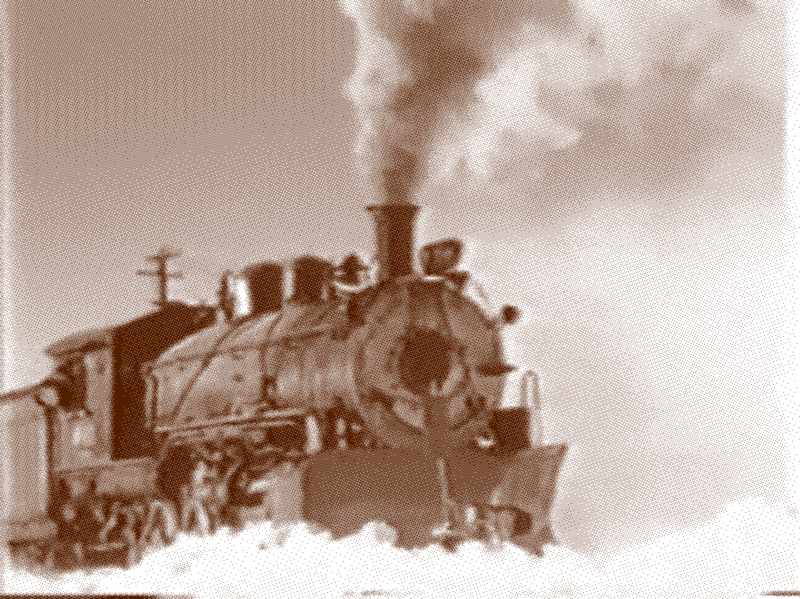
Most of the stuff displayed and announced on the
spacetrain is also pulled from the websitenet,
and in the meantime everyone is glued to their
objectphone, microdosing drops of dopamine,
mindlessly performancedoomscrolling.
Yeah, yeah, yeah…
A boomer cliché, right?
Maybe.
In the meantime,
while we argue over the freshness of this critique, /camera:90
our hyperinterdependence on hybrid systems has
remained unchallenged,
unregulated,
unconditional,
and ultimately underestimated.
Chapters are written,
panels are moderated,
slides are presented,
research is funded,
but radical discourse is not met with radical action,
and thus the hyperinterdependence stays on track
towards an increasingly gloomy destination.
Well, on track, not always.
When the computational infrastructure of NS failed
on 3 April 2022,
the effects were telling.
The whole train infrastructure stopped nationwide,
and NS employees,
without their daily software-generated instructions
and schedules,
simply went back home,
unable to do any kind of task.
Maybe that’s the problem.
The path to the offered destination,
regardless of what or where it could even be,
is so broken that we wouldn’t be able to reach it
before the infrastructure supporting the journey
completely collapsed.
In the meantime:
Let’s write more software.
They say it’s cheap.
LOL.
The meme/tired adage that ‘computation and
storage are cheap’ is not going away,
despite their well-documented extractivism,
resource-heavy labor, and bloated infrastructural
requirements that
(despite being ‘merely’ computational)
demand a recursive amount of even further
investment and resources. Fun fact 3: All dots at the top of the screen represent members of the audience. So there’s about a classroom full of us. Curious to know which dot you are? Use the ‘emote’ function at the bottom of the screen, and you’ll see
But, hey, we need apps.
More apps.
It’s not surprising that the software side of the
NS infrastructure is becoming an increasingly /camera:100
important part of its agenda and financial
investment,
even boasting new performance indicators such as
‘user-friendly travel information’. From the NS annual report ‘Performance on the main rail network and the high-speed line’, 2021, https://www.nsannualreport.nl/annual-report-2021/our-activities-and-achievements-in-the-netherlands/performance-on-the-main-rail-network-and-the-highspeed-line/performance-on-the-main-rail-network-and-the-highspeed-line.
As a traveler whose existence needs to be validated
by take-it-or-leave-it data extraction,
I don’t really feel like a friend of the NS.
More than anything else,
to me,
this clearly shows how operating systems and
software interface language is transforming the
traveler into a computer user or a pawn used by
computers for who knows what purpose.

So yeah,
I think it’s safe to say that there is nothing more
hybrid and cyber than an NS train trip. In comparison,
the hybridity of cultural events feels less pervasive,
more playful and motivated by other urgencies,
artistic,
political,
et cetera.
But still,
something is really off in the discourse.
Sure,
we all know the current pitch:
something something pandemic,
something something lockdowns,
something something online,
something something crisis-as-opportunity,
something something et cetera.
Hybridity is here to stay.
And it’s really driving a lot of initiatives and
projects,
but if we consider that we were already hybrid
before being told to go forth into the hybrid
sunset,
does it mean that these urgencies are simply false?
Do they exist to make sure the pervasive agenda of
hybridity becomes further normalized and…
*Loud default ringtone*
*Rummages to find phone and pick up the call*

Hey there! How ar…
Wait, one sec, I’m in the train in the spacesilent coach thing.
*Quickly stuffs things into bag and finds a place where the noise of human life being lived is tolerated*
OK, hi.
Where you at? I’m still home, waiting for my fucking
groceries! I remeber the days where youngins entertained themselves by reading a book on the train now they watch a Tiktoks, truly deplorable!
I’m on the train. I will be there on time for the
audiosound check. I’m trying to get there early because I
will be using my objectlaptop, and they asked me to send
a PDF a couple of days in advance, but seriously
WTF, like I have time to prepare something for
their workflow. Everyone always works on their
presentation at the last minute anyway…
Yeah, for real. I can barely handle workload at
the moment. I can definitely sympathize with the
producer who needs to chase down deadline
delinquents to submit things on time for their
videoOptimized Video Streaming Set-Up. But still. The
bedside manner on both ends of the symposia-
spectrum leaves much to be desired.
The more I think of it, the more I’m getting
confused about this obsession over hybrid this and
hybrid that, it does not make sense.
What? Your audiosound is breaking up. Are you in a spacetunnel?
Can you hear me?
Yeah I can hear you, can you hear me?
Yeah, I can hear you.
Act 2

Every new product or service is trying to provide a miracle-cure alternative to consolidate workflows that promises more and more yield. People end up with this sort of Frankenstein ❄️❄️❄️ deck of multiple apps where developers tried to combine different productivity tools, mixing systems, storages, providers, services, and so on and so forth, creating this macrobricolage of crap 🐎🐎🐎 with components that don’t talk to each other. Maybe this story can build up towards what you were trying to structure just before we starting this hallway walk-and-talk: the bigger picture of how hybridization discourse is taking over in education.
Yeah, what happens when objectpaper—in essence, a form of presence, materiality, and simultaneity—is no longer an option?
What’s the alternative? We were quite self-congratulatory at the beginning of the pandemic at XPUB Experimental Publishing, or XPUB for short, is a masters’ program at Piet Zwart Institute, Rotterdam, formerly headed by Aymeric. but it didn’t work out too well for us either.
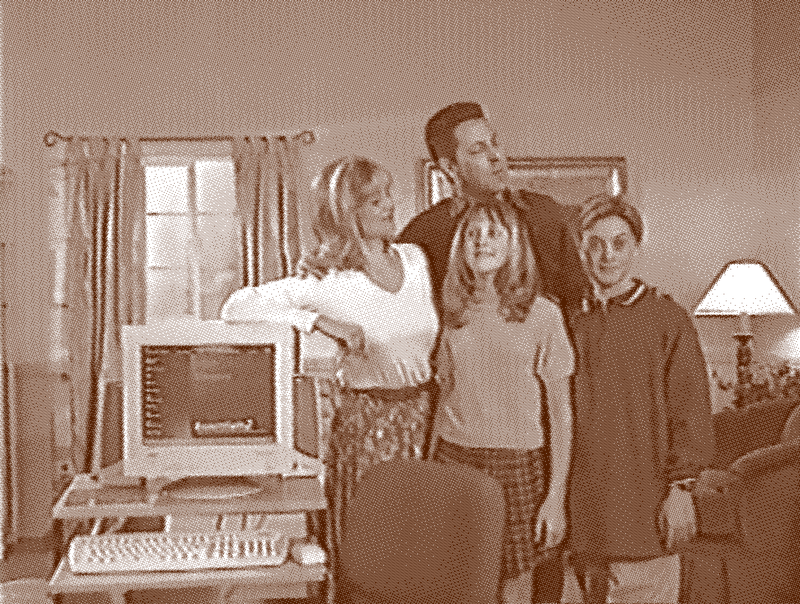
We were the perfect digital doomsday preppers. The content of the course was precisely about creating your own technological infrastructure for collectively making things public and creating publics for issues that mattered to us. We were ready. We embraced the moment. But even for us, the spacehybrid classrooms also failed. Because it’s not just about free software, open-source software, or self-hosting. These software-led forms of organizing life ah I love this video, is there a link to it somewhere to refer to later? are just not working. And as a result this built up slowly towards a line of thinking that I think should be made explicit. Behind the scenes, people are getting relaxed, chatting, laughing. It seems like the collective nerves for this event have loosened a bit COMPUTERS ARE SHIT, SOFTWARE IS SHIT, INTERNET IS SHIT. Like, in all caps. [Snark]
LOL. OK, for the record, note to designer.
In general, I think we collectively failed at organising some sort of meaningful digital solidarity. The amount of virtue signalling, meritocracy, and coolness of running your own X-Y-Z took over eventually. Local solutions, self-hosting became even more ways to brand individualism—or to brand one’s domain—distracting from the tasks of collective organisation and mutual aid.
A great example of this are websiteetherpad installations. On the one hand, you have way too many of Yes I would love to rewatch it too them, it’s like the new ‘hello world’ of server administration. 🐴🐴🐴 On the flip side, there are only a handful of pad instances that are institutionally as someone who did xpub during covid, i concur with this current statement overused and overloaded, with no consideration or Yes Kendal, chapters from this book will be available as video, audio, and text. Win win win! support for the people offering such services often with very limited means. the motto of xpub is ‘has someone made a pad of the day?’
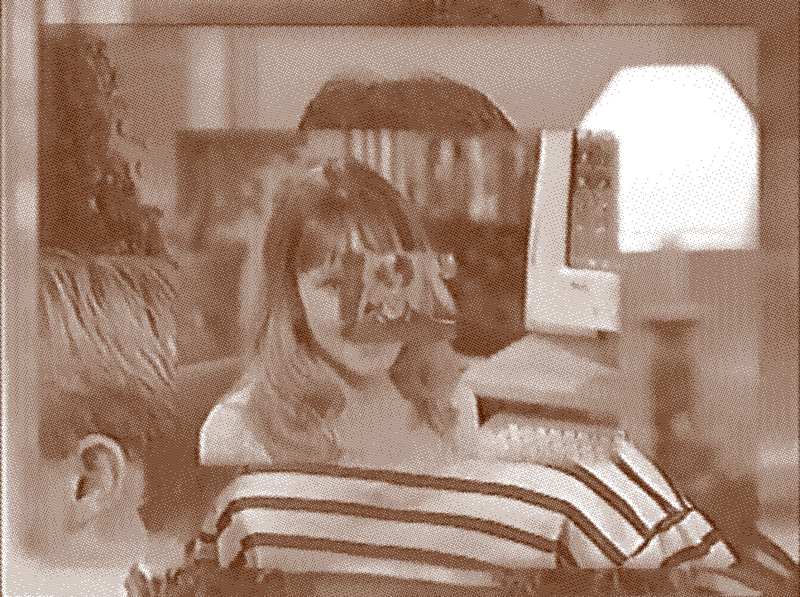
This is the thing we were discussing: over-platforming in the pandemic. <3 Everybody built too many different instances of the same platform or software instead of making consortium efforts to share infrastructure. If we had done that, there would be less shit to maintain, and not just technically speaking. Many of these pandemic-as-crisis infra-experiments have been deserted. It’s a job in itself to keep these new spacevirtual office spaces, servers, online classrooms in active and meaningful use.
Maybe my mind goes in this direction because of what I’ve experienced in citizen-led disaster relief efforts in the Philippines. Having (or lacking) a well-developed disaster muscle conditions what you can imagine in terms of peer-to-peer aid systems. It breeds a collective ability to bootstrap out of desolation, with or without safety nets set in place by our mis-governing institutions.
In the Philippines, the gross lack of functioning public infrastructure and deep mistrust of state governance leaves a large part of the disaster response-ability to the populace itself, aided by civil society and non-governmental organizations. So there is this sort of disaster muscle that, on a street level, has been rehearsed over and over. Crisis response know-how has in trickled between and through NGOs, civil society, the agent populace, sometimes even the state. For example, you see a lot more consortium-making between Big Aid organizations who work and share information with each other to respond more efficiently to massive crises.
The scaling up of the knowledge and efficiency of response-ability in loosely organized groups has been especially noteworthy, but our informal networks were already strong-ish to begin with. Tight neighbourhood bonds and close-knit communities tend to be the default in places where the state fails its citizens on a regular basis. There was already an understanding that we would have to respond to natural disaster on a hyperlocal level instead of waiting for the government to come to the rescue.
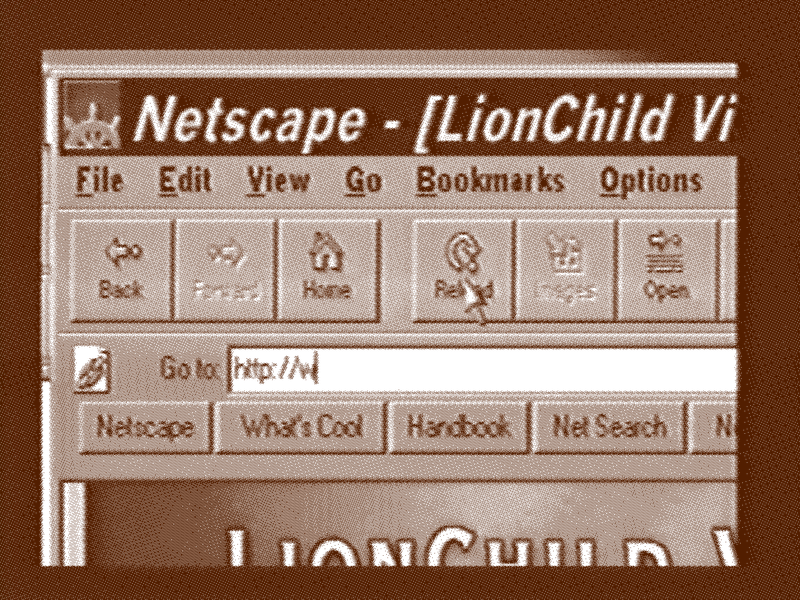
Consortium-oriented neighborhood infrastructures are nothing new either. In many neighbourhoods in Fun fact 5: If you want to filter this chat for references, you can check the box ‘Show only URLs’ at the top the Philippines, even in big cities, there’s a long-standing familiarity with the notion of infrastructure Hell yeah feet being distributed across different households. The Household with the Freezer is where you go buy ice for your cooler chest or your drinks, as not kendal, so for you to know since you pointed out the background, it was made in Unity and then upload on VRChat. If you want the link to the room (or anyone else) i can drop the private world here everyone can afford a fridge, let alone a fridge with a freezer. The Household That Makes Their Own Coal is where you buy your cooking fuel if you can’t afford butane. And of course, you can watch your favorite noontime shows and soap operas by gathering outside the window of The Household with the TV. Found it!!! The techno-neighborhood, or infra-neighborhood, is very much a contemporary reality https://www.youtube.com/watch?v=mfMrVKnGzwg in rural and urban areas alike. oooh yes please The responsibility of maintaining necessary tech/infrastructure is deferred to households, which you could imagine as civic institutions, with the most capacity or entrepreneurial spirit to do so.
Hang on. Is this too much of a thought-detour?
Not at all. Actually this is a super strong point, the thing about distribution of infra, and if we unpack it fully then we get into really interesting territory regarding governance, self-organisation, privileges, appropriation, and dependence of the wealthy on the work of the less privileged (online) communities, especially those on the outskirts of centers of capital.
But after the section about being unable to step out of technosolutionism, we would we need to start to You will still need to have steam installed on your laptop though defining what we mean by infrastructure. This is a good transition to that third part.
I’d also like to explore why this concept of techno-infrastructure has been overlooked in the cultural sector until now. Few people have the adequate vocabulary to articulate ways forward that go beyond expanding a software stack. Technosolutionist thinking that, at its core, proposes infrastructural solutions for hybridity as a silver bullet is flawed. i have steam ;)
Hang on, let’s backtrack before we move into the here you go: https://vrch.at/effseeke third part. The digital doomsday prepping at XPUB failed because…? 🧖🏻
Because software is only just one part of it. Because using the computer to mediate human relationships is just not working, period. Even though we are having so much fun with our objectfancy gadgets and dystopic technological experiments, all this is just generating more detrimental issues than positive social changes. The alternatives that are proposed to classic surveillance capitalism or extractivist approaches to software production are not working thankyou so much :) either. The problems are political, social, economic, cultural, so writing software as a reponse to such complex systemic issues is completely delusional.
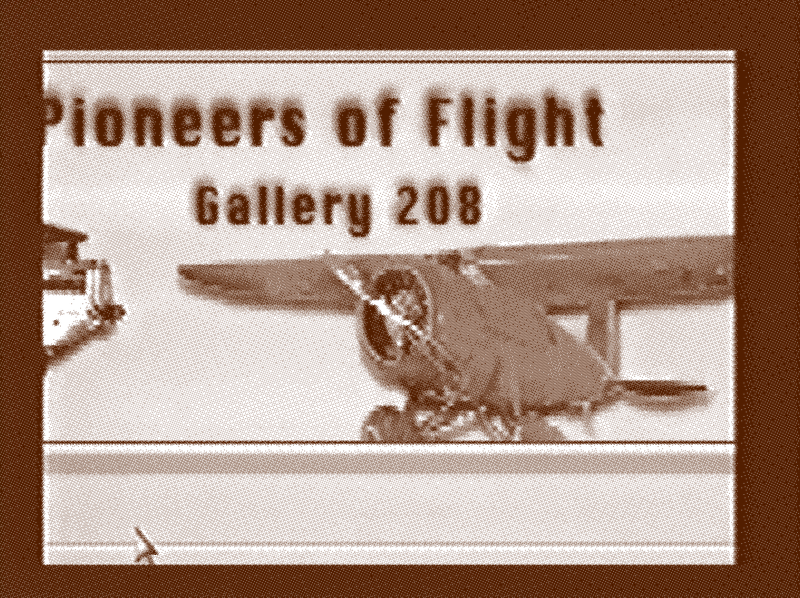
There’s a really good definition of structure and you’re welcome! infrastructure by Lauren Berlant in ‘The Commons: Infrastructures for Troubling Times’. Lauren Berlant, ‘The Commons: Infrastructures for Troubling Times’, Society and Space, vol. 34 no. 3 (2016): 393–419, SAGE Publications, accessed on 16 September 2023 without a paywall at https://deterritorialinvestigations.wordpress.com/2016/08/01/lauren-berlants-the-commons-infrastructures-for-troubling-times. Via other writers, Berlant proposes structure as something defined by circulation and motion. Structure needs to be built around use, and use of a structure is determined by how people or organisms circulate within it. She also differentiates structure from infrastructure. Structure governs circulation, but infrastructure is some of kind of material substrate or construction that binds us to a world in motion. I like this nuance, referring to the infra as something rooted, a solid but responsive ground, and structure being something that allows and organizes motion over that rooted platform. So when an infra/structure is not in use—in the absence of circulation—it is no longer an infra/structure. Fallen into disuse, which is not the same as disrepair, it becomes rubble. For me, it would be important to define infra/structure as such: tied to life, intentional use, activity, circulation. In the absence of an intentional entanglement with life, technology or any other form of mediation or organization becomes pure waste. Sara Ahmed, in her book What’s the Use Sara Ahmed, What’s the Use (Durham and London: Duke University Press, 2019), 7. , says that ‘to be in a relationship of use is to be in an environment with other things. […] Use is thus an intimate as well as a social sphere. Use is distributed between persons and things.’
About this Text
Clara Balaguer is a cultural worker and grey literature circulator. She coordinates the Social Practice course at Willem de Kooning Academy and teaches in the Experimental Publishing MA at Piet Zwart Institute.
Aymeric Mansoux is an artist, musician and media researcher, with a background in economics, fine art, graphic design, and computer programming. He is Lector Commercial Practice at Willem de Kooning Academy.
This text is a short extract from Can You Hear Me? (For the Record), forthcoming 2024, a quasi-fictional but totally plausible train of conversation between Aymeric Mansoux and Clara Balaguer on infrastructures, paradigms, and subjective histories of hybridity. This extract and video essay were specially made as a video contribution to the Screentime Airtime Facetime livestream. The audio in the video was created with the kind help of students, alumni and colleagues at the Willem de Kooning Academy, Rotterdam. You can watch the livestream recording through this link: https://vimeo.com/908218028.
Thresholds of Access
00:49 Welcome to chapter two, ‘Thresholds of Access’. As you can see, there are two new hosts with you, which are me, Chloë, and Senka, who is sitting across from me. We also welcome three new speakers. Ooooh yeah we’re all here First is Karl Moubarak. He’s a designer and a tool-builder and member of Hackers & Designers. See: https://www.hackersanddesigners.nl His practice is rooted in the digital sphere and focuses on research, development, and social activation of experiments or interfaces, infrastructures, and on and offline sites for exchange. Our second speaker is Ren Loren Britton, who works in the art and design studio MELT with Iz Paehr. As MELT, they build worlds along three arts and design research structures: Anti-Ableist Technologies, the Meltionary and Zeitgeber. MELT’s work resources ways of being together that figure in the present and future our flourishing. For more about MELT, see: http://meltionary.com/MELT.html And finally, Ania Molenda, who has been a member of the Hybrid Publications group in Going Hybrid. Senka <3 Ania is an independent researcher, curator, writer, educator, and co-founder of publishing platform Amateur Cities. See: https://amateurcities.com. Her work focuses on the cross-section between spatial practices, technology, ecology, and their socio-cultural impact. Her current project ‘Unfolding the Archive’ at the Nieuwe Instituut, has been supported by the NWO Museum Grant. This project will explore how can the the National Collection for Dutch Architecture and Urban Planning housed and managed by the Nieuwe Instituut use the digital affordances of their born-digital collections to make them accessible in dynamic, networked, multimodal, and multivocal ways.

02:26 In this chapter, we’ll be talking about access on both a human and a technological level with a focus on live cultural events, their structure, and their afterlife. Who is included in live events and who isn’t? How can an audience that was not part of a live cultural event feel included and engaged afterward? Access as a topic influences so many facets of hybridity. From inclusive and customizable design to the mediations that technology can allow for, the interfaces that exist on platforms, but also the considerations and concerns that practitioners come with and bring to the conversation. Equally, access also pertains to knowledge production. Why are there mushrooms and unicorns in the back? How information is built, who it is shared with, how it is communicated? So, indeed, we are looking at access quite broadly. I would like to ask all of the speakers to situate the notion of access within their practice and their research.
Where Does Access Take Place?
03:56 Thank you for the lovely introduction. they were summoned by the magical giulia My work usually takes place in interdisciplinary contexts. In this context, ‘access’ is about bridges between different forms of knowledge - between different academic backgrounds, different domains, or different cultural backgrounds. It’s also very often related to technology, where digital literacy plays a role. In each project, there are different constellations or intersections of access. It can, of course, also relate to different forms of ability or disability, but that axis is not central to my work.
05:05 Thanks for the question and it’s really nice to be here. As was mentioned, I’m here to represent two people. I’m Ren and my collaborator Iz is joining us on the livestream. We work together as MELT, and in our practice, access functions as a creative motor for the way we work through practices and problems. We work with a disability justice and trans-feminist-oriented practice. We’re primarily concerned with making access for disabled people and thinking about the multiplicity of formats that that might require. We also think about multimodal design quite a lot. An example of that is a recent project we have called ‘Counting Feelings’. ‘Counting Feelings’ was a two-day workshop collectively by MELT, exploring how we can use data otherwise. It took place online on 18 and 19 April 2023. See: https://www.extraintra.nl/initiatives/crip-the-curriculum/counting-feelings In that work, we are looking at what would data mean for trans and disabled people, if ableism and anti-queer sentiment were not the organizing factors of our everyday lives. We’re developing other ways of thinking with data practices. We have, for example, a work that’s a objectweighted blanket. And with that weighted blanket, we have it both as something that you can feel, textsomething that you can read like a booklet with all of the information of the data bits inside of it, and also audiosomething you can listen to. We are thinking through multiple layers of access-making through something very much coming out of our community as well. Did someone say mushrooms? and unicorns?
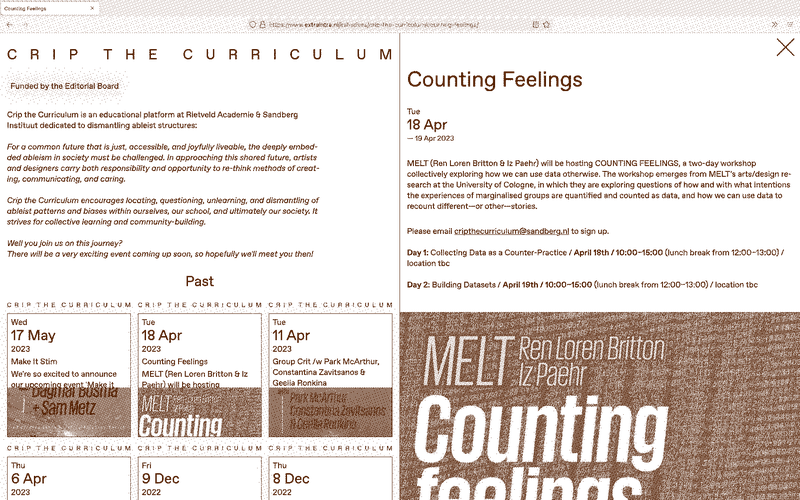
Webpage of the ‘Counting Feelings’ hosted by MELT.
06:26 I’m working with technology and infrastructure and tools, at least in the context of this research consortium and with the work group that I’ve been participating in – through Hackers & Designers and with The Hmm – Participatory Livecasting. We were thinking a lot about access from two axes. One is disability and videomaking livestreams accessible to disabled people in different ways, to cater to different disabilities. The second axis of access is about ecology and computation power, network bandwidth, and this kind of stuff. My main role in the project, from its development until now, has been thinking about the technical ways in which videoa technologically sustainable and light streaming service, for lack of a better word, could work for The Hmm.
07:31 One example was discussed by Lilian Stolk in the first chapter. See ‘1: Sound and Temporarlity’. The Hmm was trying to organize an event around non-visual culture. But for a year or two, they had this websitelivestream platform in which, it turned out, a lot of assumptions were embedded. For now they’re just in the digital background, technology hasn’t progressed enough for now unfortunately For this event, they reached out to me and said: ‘Hey, can we update the livestream so that this one event is presented as audioaudio-first, instead of a videovideo?’ The axes of access, thanks for that Karl, very important videoThe video would be accessible but as a secondary option. Then I was confronted with all of my assumptions of how the audio-visual aspect of a stream was at the forefront and embedded as a default everywhere. From the front-end to the back-end code, to the connection with the streaming service. If nothing is declared about the streaming preference, video is default. This begs the question, why is this visual culture so central? The simple fix was to create an option to pick for each event; what would be the automatic default streaming mode? You can listen back to this event in The Hmm livestreaming and recordings sections, on their livestream platform: https://live.thehmm.nl/n0n-visu4l-1nt3rnet-cultur3
08:58 Thank you so much! Let’s look back. I want to ask you about what has been lost, but also what has been gained during the COVID pandemic. And, based on those lessons, what we can ask for or demand from cultural institutions when we talk about hybrid events? /camera:180
09:25 I reached out to Ren, specifically in context to this question and with your work concerning disability justice and just in general, cultural hybridity. There was a pandemic and with it came state-enforced restrictions on mobility and movement. camera:30 So, access to culture became a problem for able-bodied people. We’re here in this two-year consortium about hybridity, specifically because of access being a problem for able-bodied people. Now, of course, those restrictions on mobility have been lifted. But something important to think about from a disability and crip justice perspective is the immobility of some disabled people – bedridden people, people that cannot leave the spacehouse because of their immunodeficiencies or whatever it is – these immobilities and limitations are also state-enforced. It’s not that it’s in their body, or it’s their choice. This is something that’s imposed on them. They have been demanding a hybrid cultural sector far before the pandemic. ‘The United Nations (UN) Convention on the Rights of People with Disabilities entered into force in 2011. It enshrined, among other rights, the right of people with disabilities to access cultural venues such as theatres, cinemas and museums, and to enjoy cultural materials, books, films and music in an accessible format’ (https://www.ohchr.org/en/instruments-mechanisms/instruments/convention-rights-persons-disabilities). However, this is often an after-thought for institutions. So disabled voices or voices that speak from a disability and crip justice perspective are very important to hear. Now, in post-pandemic, hybridity is a trend. We’re talking about it, and I think an immediate request or demand is to center disabled voices in these developments rather than continue to move forward with our mostly able-bodied realities.
11:18 Maybe I can add that so many disabled activists and folks at the beginning of the pandemic said: ‘We’ve been asking for hybridity forever and now when non-disabled people need it, it happens.’ It shows that these are really important, critical questions for cultural institutions to keep in place, while also keeping hybridity playful. A lot of the work that Iz in I do as MELT is about understanding access as a creative force, as a playful thing, or as something that creates a lot of potential for connection. Seriously questioning visual culture is a red thread between these two conversations already. But it’s a difficult question for the ‘visual arts’ and design and internet culture field. Is what we do still egitimate if we pass on visuals? Rather than seeing it as only a loss of one way of participating, maybe some other ways of joining are made possible through hybridity. This is what I understand you’ve been looking into, which is exciting.
Access as Creative Force
12:07 Do you have some examples of that playfulness? What are ways we can do that?
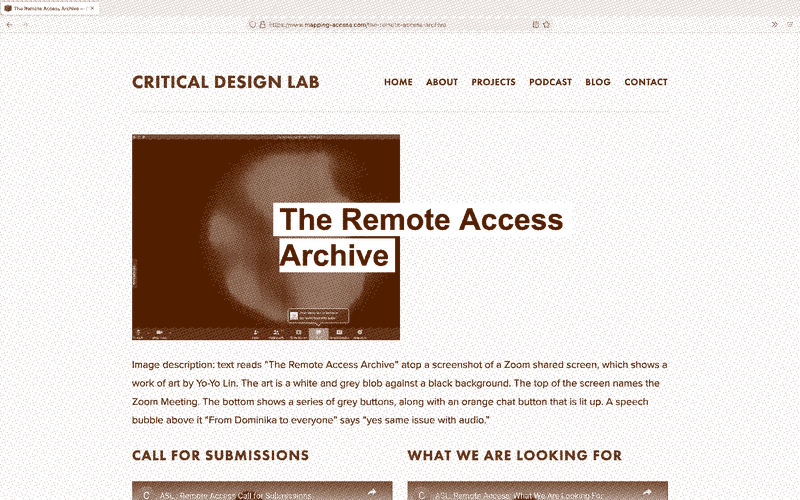
CRITICAL DESIGN LAB webpage of the ‘Remote Access Archive’ project.
12:14 Next week, Iz and I are hosting a Crip Hackathon with Heinrich-Böll-Stiftung. websiteParticipating accessibly at the Hackathon is entirely online because we are making sure that people that are immunodeficient or anyone who’s disabled can also still join. And we’re sending everyone a objectpackage. And in that package is a toolbox of things that you might need to imagine. So that’s one way that we’re still practicing with that. We also like the work of the Critical Design Lab and Aimi Hamraie, especially their project ‘Remote Access Archive’. ‘The Remote Access Archive will gather stories, documents, and other information about how disabled people have used technology to interact remotely’ - https://www.mapping-access.com/the-remote-access-archive It looks at this exact problem: how is access made or lost? It records the moments in which access is no longer possible, which brings up more radical claims and questions that we can ask.
13:16 In the context of our group, one of the starting points was two-fold. On the one hand, we saw that many cultural institutions started to invest in building their digital infrastructure, which before maybe was not on the priority list. nice colors combining Reposting on request: Down with visual culture! this background world is gorgeous We considered that as a gain. But very quickly, we also realized that making available is not the same as making accessible. Certainly sonic over visual lesssgoooo So, you know, the fact that we just had the tools to dump things online, was at first perhaps understood as ‘we’re making it accessible, it’s open, you can join’. But in the end, we all experienced Zoom fatigue. What can we do more radically? Thinking of different forms of access and different needs that go beyond just providing videoa stream or providing an textunreadable report, which was our research topic, is something that we were only starting to think about and experiment with. So poignant and essential this statement that making available is not the same as making accessible Partly, the question of access is one of continuity and keeping on learning by doing, rather than thinking that we’ve gone through this, and now we can return to the status quo from before the pandemic.
15:07 Thank you so much. I think that’s interesting, we can do more than just providing a videolivestream. That resonates with what you said, Ren, that we can do more than the bare minimum. We can be creative. We can see hybridity as an opportunity to do more. That brings me to a question for you, Karl: right now, for the Screentime Airtime Facetime event, we’re using websiteThe Hmm's livestream platform, which you built. This website has a lot of accessibility features. How was the process of building this website over the last two years and did it change your approach to streaming and hosting events?
16:00 Oh, hey, I see Margarita enter the room! As to the websitelivestream platform, I think an important example was this event on non-visual culture. This is one example of an iteration on the existing platform, and a few changes are implemented that address a different need each time. Was your question about how this has changed?
- 16:38 How did the process of developing and redevelopoing a livestreaming website change your perspective on accessibility, and building tools for access?
16:48 My perspective has definitely changed. I first started thinking about accessibility and disability justice a long time ago, when we - as Hackers & Designers - were invited to design websitePlatframe, a platform for a conference organized by TU Delft. You can access the documentation for this platform, ‘Platframe’, here: https://hackersanddesigners.nl/s/Publishing/p/Obfuscation_platframe is the Hmm accessible enough for you Madame Bertha? Out of nowhere, we received this email with a very generous list of points of feedback from Ren and Iz who had done an audit. I say ‘generous’ because it wasn’t ‘this should be that way and this shouldn’t be that way’. Each of their points was followed by a reference, with a question, with an open invitation to have fun and experiment. That platform ended with a guided tour, so one of the results of trying to make that platform accessible was having a very regimented, guided tour of all the parts of it in a way that you could join as a visitor. Then, this whole set of built-up knowledge came to The Hmm. You’re right in saying that it has now been two years of developing and iterating this platform, and it’s still changing. I dont understand much of computer technology I appreciate simplicity and videos of cats I love those Every time there’s a new experiment that is invented by The Hmm or Hackers & Designers around accessibility, there’s a technical question that comes with it. For example, in the Participatory Livecasting group, we’ve developed this toolkit that Lillian and Heerko talked about called ‘Emoji Proxies & Ghost Messengers’,videoand it's what this camera here is doing. This toolkit was explored and presented at a workshop: https://wiki.hackersanddesigners.nl/index.php?title=Emoji_Proxies_%26_Ghost_Messengers. The focus question of that group was: How to give an online audience more agency over the spaceon-site space? Historically, the online audience has mostly been a disabled audience that has to be online, or an audience that cannot get access to that event physically because of transportation, material needs, child care, or whatever it is. In our experiments, we were trying to create a kind of agency for this online audience that the physical audience often takes for granted. that’s totally fine, hope you’re enjoing also this live!

Still image from the third workshop on obfuscation done by Hackers & Designers.
19:21 Thank you so much. Ania, you and the Hybrid Publications group have been thinking about how to lower the threshold of the knowledge that is produced within live cultural events. /camera: 30 You were using event reporting as a tool and thinking about how to make this something that people would not only read but understand and gain something valuable from. So would you like to elaborate on what that process was like, but also what is still to be done with the event report as a tool that brings information closer to people? /camera: 85
20:05 One of our most important starting points was the excessive availability of cultural events. If you prefer, you can listen to the livestream (and reduce carbon footprint) by selecting ‘audio’ under Stream modes, or even just read an automated live transcription by selecting ‘text’ As members of the general audience, on one hand, we wanted to participate and get a sense that we could get something out of them. But, on the other hand, we woud find that our time, attention span, and ability to engage were very limited. And at the same time, we looked critically at what came after. One of the group members, Maria, wrote in an on-point description of what even reports often feel like: ‘they were leftovers of an all-you-can-eat banquet in a patchy and chewed-up reminiscence of something you probably missed for good reasons, to begin with’. Maria van der Togt, ‘Event Report Workout: The Etherport Edition’, Institute of Network Cultures, 29 June 2023, https://networkcultures.org/goinghybrid/2023/06/29/event-report-workout-the-ethertoff-edition. This was our starting question and a frustration that we wanted to answer. How could we not only lower the threshold of access but also diversify the thresholds of access? How could we take out of the events the things that interest us (and those can be very different and personal) and how can we turn this content into something that could be, what we kept referring to throughout the whole project, more of a conversation starter rather than a closure? /camera:130 That also ties into what was discussed in the previous chapter. How can we create a sense of continuity of liveness after an even, in the form of an event report, or, as we called it, a conversation starter? /camera:130
Reading Access
22:34 If I understood the event report research correctly, there was a focus on the authorship of the person reporting and textwriting, and, in other words, on the accessibility of a tool towards the author. I think you were trying to achieve a process in which the author would have to do a bit less filtering, which would leave more space for honesty about how they think and do during the event, right? /camera:50
23:05 That was an important aspect of the collective dimension. We experimented both with individual authorship but also with collective authorship. The provision of that freedom, to choose how you want to move through these options, was key to our project. What you mentioned emerged from the desire to create something that would facilitate the textcreative writing process and the more subjective perception of an event rather than a dry report (‘and then, and then, and then, this happened’). /camera:90 We’re having collective authorship right here, right now! Chat power! For instance, we found that it is important to highlight aspects of an event such as audience moods and atmosphere as essentials parts. /camera:110
24:43 If I may also add to that, having used the event reporting structure developed by the Hybrid Pubs group to report a previous INC event, it triggered me to think: ‘Okay, what will I leave for someone who has not been physically present here? What parts of the atmosphere have I noticed?’ For instance, I was then part of a workshop where it snowed in March, and that became a thing that’s highly subjective and maybe to some might seem like it’s not relevant, but it is.
25:22 In the work that Iz and I do, we often work with textalt-text or still imageimage description. One project we often reference in this context is ‘Alt-text as Poetry’. https://alt-text-as-poetry.net I find the work that they’re doing to be very much about this objective thing: when you look at something, what do you see? Paying attention and trusting the perspective that you describe is also a super interesting part of access-making. I find that the textimage descriptions that I write for the still imageimages are often quite verbose because I like to describe things. That’s my perspective in sharing, I can imagine this event reporting having a similar structure.
26:06 textImage descriptions have an interesting facet to them, because who are we writing the image descriptions for? Is it for the audience or is it for technological reasons like search engine optimization? These are very different purposes, which are definitely not in sync with one another. for sure we need to add snowflakes to the dryness of event reports We need to make a conscious choice, thinking of the audience and who are we addressing.
26:34 Unfortunately, we have to end our conversation here. Thank you all for your time and your perspectives!
About this text
Chloë Arkenbout works as a researcher at the Institute of Network Cultures in Amsterdam. She has a background in both media studies and philosophy and is interested in the tactics marginalized people use to challenge oppressive discourses in the digital public sphere - from social media comment wars to memes.
Senka Milutinović is a researcher, writer, and multimedia designer. They are a research tutor at Willem de Kooning Academy and are a co-editor of Screentime Airtime Facetime.
Karl Moubarak is a designer and a tool-builder, and part of Hackers & Designers. He was a member of the Living Archives group and the Participatory Livecasting group.
Ren Loren Britton, together with Iz Paehr, runs the art and design studio MELT. MELT’s work resources ways of being together that figure in the present and future our flourishing.
Ania Molenda is an independent researcher, curator, writer, and educator on the cross-section between spatial practices, technology, ecology, and their socio-cultural impact. She was a member of the Hybrid Publications group.
This chapter-conversation was originally recorded during the a live event Screentime Airtime Facetime, which you can watch back here: https://vimeo.com/908213218.
Talkshop Mumories: Living Archives
So in March of this year (2023), our group was part of the ‘In-between Media Conference’, which was organized by the Institute Network Cultures. And one of the sessions that we had was called ‘A Living Archive is Also a Dying Archive’. textKate Babin reported on this session Nietzsche said that forgetting is necessary to imagine. Poor large language models that do not forget anything :( in an article that she wrote for INC. Kate Babin, ‘Expert Session: A Living Archive is also a Dying Archive (Conference Report, day 2)’, Institute of Network Cultures, 31 March 2023, https://networkcultures.org/goinghybrid/2023/03/31/expert-session-a-living-archive-is-also-a-dying-archive-conference-report-day-2/. In it, she mentioned the work of Eric Kluitenberg, who was working on the topic of living archives. So textI'm just going to quote Kate here where she writes:
Kluitenberg explores the connection between living memories and digital archives in his essay Captured Alive: on Living Memory and Digital Archives. Due to memory existing in certain cultural contexts and situated in the biological body of those that hold the memories, different elements of an archive will recontextualize those memories. Kuitenberg writes: ‘Memories evolve, mutate, blur, and are continuously recontextualized by new experiences. Sometimes memories are forgotten or apparently forgotten, only to re-emerge at the most unexpected moments.’
I think this also touches on Angelique’s memory as well, audiowith Bjork's song. I think this quote is really fitting for our thinking processes and how we were thinking together when we were imagining the different forms that an exhibition space’s archive could take. So bringing the topic back to life spans and collapse, I wanted to bring in one of our guests who’s joining us online, Michael Murtaugh, and he’s directing the Experimental Publishing Masters at the Willem de Kooning Academy in Rotterdam. i need that link He’s also a member and part-time co-system administrator for Constant VZW in Brussels and works in a cross-disciplinary collective modestly named the Institute for Computational Vandalism (which is a really great name). So, Michael, it would be great if you could maybe speak about your own approach to archives in the work that you do, especially in relation to the dying or the collapsing archive.
Thanks for the intro. What I pulled in may connect to some of the people who are also there. Actually, the question of the life spans made me think a bit about something audioI once heard Spider Alex talk about. And Spider Alex is a system administrator for a kind of feminist server network and in particular works at spaceCalafou, in Barcelona. In fact, actually, this was a quote that I found on Varia’s website from audioa radio broadcast that they did on A Traversal Network of Feminist Servers:
We went for the division between containers that would be hosting living data — data that needs to be available, our wiki, or the WordPress — data that should not be down. And then the transitional container is more for installing services that enable you to produce data that are needed for a while and then can go, like websiteOpenSondage or Framadate, or sending encrypted files and making surveys. It’s for temporal data. And then finally, we have another container that we call the ‘Feminist Necro Cemetery’. That is an archive of feminist and zombie websites. We try to identify interesting communities, websites that are going to be closing soon and try to make a copy of those websites to have them in the archive, in a static form. We have the possibility to have them in zombie form before, meaning that if people give us a copy of the database, we can host it for them. And if one day the other people want to bring those websites alive again, we can put them in contact so they can do it.
Anyway, it’s just kind of interesting. I think a lot about these kinds of different types of living archives — and indeed the fact that it’s not just living and dead, but it’s this whole life cycle of ‘preparing’ for things, then ‘during’ things, and then ‘after’ things. https://alexandria.anarchaserver.org/index.php/Anarcha_section#Anarchaserver_architecture And of course, it intersects with key questions, such as how does a site need to be edited and by whom, and what’s the temporality of that? 🙏
About this Text
This intermission is a snippet from the radio show ‘Talkshop: Living Archives’ on RaRaRadio, hosted by the Living Archives group of Going Hybrid. It was played as an audio clip during the livestream of Screentime Airtime Facetime. You can listen to the full radio show through this link: https://www.mixcloud.com/RARARADIO_EHV/talkshop-living-archives-04102023/, or watch it during the livestream (with visuals by Giulia Timis) here: https://vimeo.com/908218852?.
Interaction and Activation
00:04 This third chapter is about ‘Interaction and Activation’. I’m one of your two hosts, still, Chloë. I moved to this beanbag, which is much more comfortable. And I’m also joined again by our other host, Esther, who will introduce the lovely guests.
00:20 Yes, joining back in! I was here for the chapter-conversation, and now we’re at the third chapter, ‘Interaction and Activation’, with three new guests. From the Living Archives Group, we have Margarita Osipian. She’s an independent curator, researcher, and cultural organizer based in Amsterdam. Margarita is part of The Hmm, a platform for internet culture, and she’s on the curatorial team of Sonic Acts and part of the artistic core of the W139. From IMPAKT, one of the partners in the research project, we have Arjon Dunnewind. He’s the director of IMPAKT - Center for Media Culture in Utrecht, the Netherlands. Also joining us is Roos Groothuizen. Roos is a media artist fighting for digital human rights, researching human and non-human aspects of invisible algorithms, information filters, and unfair distribution. With IMPAKT and Derk Over, she developed ‘Project Stargaze’. To know more about ‘Project Stargaze’, read the blog post report: https://networkcultures.org/goinghybrid/2023/06/22/project-stargaze-report.

Chloë Arkenbout, Arjon Dunnewind, Margarita Osipian, Esther Hammelburg, and Roos Groothuizen discuss interaction and activation in hybrid cultural programs.
01:31 Welcome, everyone! Thank you for being here. In this chapter, we’ll be discussing the pitfalls of hybridity. What sort of interactions and hybridity do we want to foster in our audiences? What sort of artistic interventions and experimentation are currently happening at the forefront of innovating across spaces and media? I’m going to start with a very broad question, and I’m curious to see how you will interpret it. How can online and offline media interact with each other in a meaningful way? Does anyone want to kick off?
Levels of Engagement
02:16 It’s really important to give people in both realms the idea that they are on an equal level. It’s very hard to facilitate that. Both online and on-site audiences are in an awkward situation where it’s difficult to interact because you don’t really know how your input is being received on the other side. I flow in and out of focus, following on real life and also online, switching between these two modes. Unfortunately, the tab of the hmmm is one of many on my computer, and I find myself in the same situation as always when following hybrid events…slightly scattered attention. Our answer to that at IMPAKT has been to try and bring people closer together. But every new format asks for a new approach to make sure that, even if one or both of us are behind a screen, it’s as easy to connect as if we were on-site together. For me, that’s a very important problem to solve. /camera: 40
03:06 At The Hmm, we’ve also tried to create balance. I think that starts with thinking about the hybrid form from the very beginning rather than as an add-on. It connects closely to the access conversation. See ‘Chapter 2: Thresholds of Access’. Something that Ren and Iz really taught me, is that you need to start thinking about access from the beginning. The same is true for hybridity. It really needs to be thought through, taken into account, and budgeted for when you’re conceptualizing an event, rather than putting this hybrid or digital layer on top of it. Ren Loren Britton and Iz Paehr work in an arts/design duo MELT. They interweave themes of: climate change, coalation-building, critical technical practice and access.
03:55 To add to what Arjon already said, within the research and the collaboration we did with IMPAKT, Derk and I were mostly focusing on a hybrid experience that has both online and offline participants. /camera: 20 There you really see where the equality is missing. Sometimes the online audience has more power or more engagement within an experience, and sometimes it’s the other way around. So within the project we did, we were trying to figure out in what ways an offline participant becomes engaged and empowered and in what way an online participant becomes that. Because for both parties, it’s completely different. You can’t treat them in the same way. That doesn’t work. Really important point: start thinking hybridity from the beginning, rather than adding a layer on top
04:48 Do you think it can ever be 50/50 when it comes to equality and when you look at the online and offline? Is that something we should strive for, to begin with?
05:01 So far I’ve noticed it’s super difficult, but it was our goal to kind of figure that out. Can we have this 50/50 engagement by giving the offline and online participants different kinds of tasks and power within our experience? but layering never gets old! But it turns out that you can’t take everything into account when you’re doing this kind of experiment. Along the way, we noticed that the different audiences ran into different barriers.
05:35 With IMPAKT, you hosted some events where there was a collaboration between on-site and online audiences. Could you tell us a bit more about that? What were the responses of the audience to this program?
06:06 When we started to think about hybridity, we thought about activation or involvement. How can you get an equal level of involvement online/offline? But also: How can we activate and make it a collective experience? I’m wondering: is 50/50 participation measurable? Can we not accept differences in modes of participation, while fostering different types of cultural meaning? That’s why we invited Roos, Derk, and Benjamin Pompe, another artist who also made a project and worked with a kind of game situation. So already there’s a set of rules, performanceyou have a role to play, and that makes people become active. Other formats have been ones where we would be eating and drinking together. It’s a very social experience that would make it easy for people to jump into a conversation cause it’s a low-pressure situation. It’s really a situation where you can say something silly like: ‘I like this wine, I don’t like this wine.’ The format of eating and drinking together has been explored by IMPAKT in their event ‘Wine Flows and Other Things’. To find out more about it, check about the blog post: https://networkcultures.org/goinghybrid/2023/06/20/ihwat-2022-the-event-wine-flows-and-other-things. https://networkcultures.org/goinghybrid/2023/06/22/project-stargaze-report That’s a very easy thing to say. And with Roos and Derk’s project, you enter a game situation and that makes it easy for people to engage with the environment that they’re being put in.
07:13 It’s the reason why we chose the game experience. We were treating this collaboration with IMPAKT as an experiment, but also as a way to research how far can you go with this online/offline interaction. And I think the research question Derk and I made for ourselves came out of the ‘COVID time’ when there was a new influx of all these livestreams and online events, like the one we’re doing now. ^ Ray took part in one of these events and wrote a little report on it. What a conversation-starter! There you saw that both audiences are not treated in the same way, so we asked how we can experiment with that. Derk studied Game Design, I’m more of an autodidact, but both of us are insane game fanatics. So it was clear to us what the urgency of this is when it comes to hosting online events or hybrid events. And why it is needed. We thought it was good to focus on how can you make an interaction work. When it comes to games and puzzle design or interaction design, there’s this element of needing it to work. Otherwise, if it doesn’t work, you get frustration, fatigue… The things that were mentioned in ‘COVID time’. So we thought, okay, can we maybe figure out where the frustration is when it comes to this very static event: a hybrid stream? We thought it was videothe static position of the camera for a live audience. And what if we place it in the most unsuspecting location? objectFor us that was placing the camera on the butt of another participant.
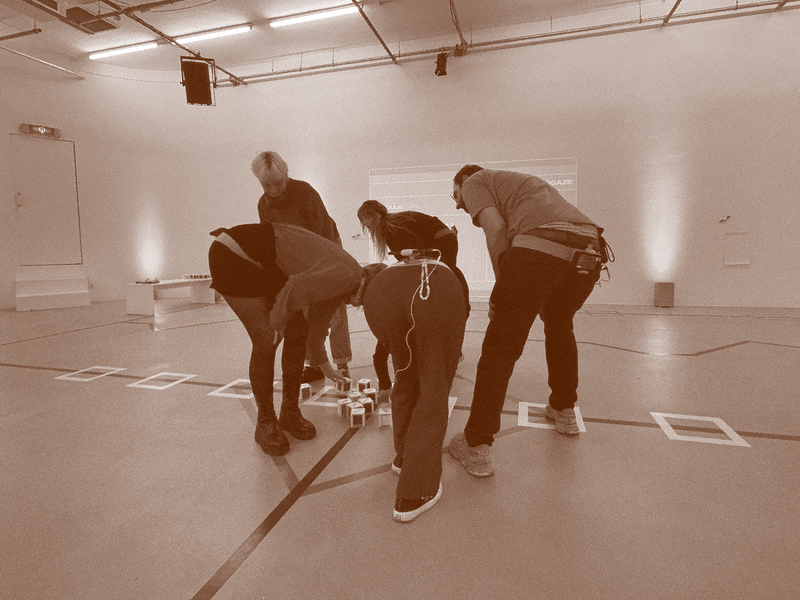
Project Stargaze camera placement.
09:11 There is a picture of it. With this, we created a very difficult task for ourselves, by giving all the participants some sort of obstacle. It was a game where the offline participants, spacewho were present at IMPAKT, and the online participants had to work together. They have to do all of these kinds of challenges. But there is this big obstacle, which is that they can’t see each other, but they can talk with each other through headphones. So they have different kinds of powers. The game is about becoming a true hybrid human being: both of you are working together to become the future human that is both online and offline at the same time. My attention from back there is selective, free: rather than being constrained to listening exclusively and constantly to the vertical speech of speakers, I choose where to navigate my attentional ship, in the horizontal seas of the world wide web. With these great powers comes great responsibilities… I need to avoid drifting my ship too much and to anchor a bit from time to time We thought that, by making objectthe offline participant have to carry this online vessel around, we would create a dynamic that is more equal. But we discovered so many problems with that. If you’re offline, you run around a lot. So videothe camera was shaking all the time and the online participants became very nauseous. the live participants are interacting with the digital layering of themeselves and their content on the screens, love that hopefully there isn’t an exam at the end I won’t be exhaustive We had to come up with challenges with a little less movement. It was really an experiment where we were trying to figure out how we make both of these participants move closer to each other so that there’s a nice collaboration going on between the two.
11:02 This interests me because hybridity is, of course, mixing different times, spaces, and stuff like that, but it’s also mixing different media types. you shoud come and sit in the first row then c: Moving into new times with digitization, it’s about mixing new media and remediation, in some sense. What you described with the early hybrid events is often staged as television. There’s an event and videowe can watch it from a distance, while you explore the medium of gaming… I would be interested in hearing which aspects of gaming are then tied into this issue of activation or interaction with the audience. What can we learn from games that help us develop great hybrid events?
11:50 What also led me to invite you, Roos, was spacethe escape room you made. That’s an earlier work. It also made me think a bit about what Benjamin Pompe made, which was very different. Roos and Derk’s piece was a game for a selected (few) amount of people where everyone had performancesimilar kind of roles. Benjamin’s piece was set in a game engine and played with what games usually are about: you’re on an island, you need to find something, you’re confronted with an object, you don’t understand the object, it has a secret meaning… All these kinds of forms that we already know and that allow people to step into a certain context easily and engage with it. I think Roos did something similar. What I liked a lot about Roos’s work is that spacethe room we had was a nice gallery, like a white cube, but it was made into a gymnastic room with all the lines on the floor. I think that the background is an escape room. Escape living room The game reminded people a bit of Pictionary or Twister… this is a lifelong tradition I cannot break it like that by coming to the front row, I would loose my identity :(( So they were on familiar ground, but still engaged by a new set of rules, a new kind of gaming. I think that’s what we can take from game concepts in general… To activate people and to have them engage with each other in an easy way. ADHD friendly event Roos’s escape room project is called ‘I want to delete it all, but not now’. but tbh I do like this format … there is definitely some interesting and organic layering with having a small live audience who is also partially commenting on the streamed conversation, simultaneously having whispering giggling conversation
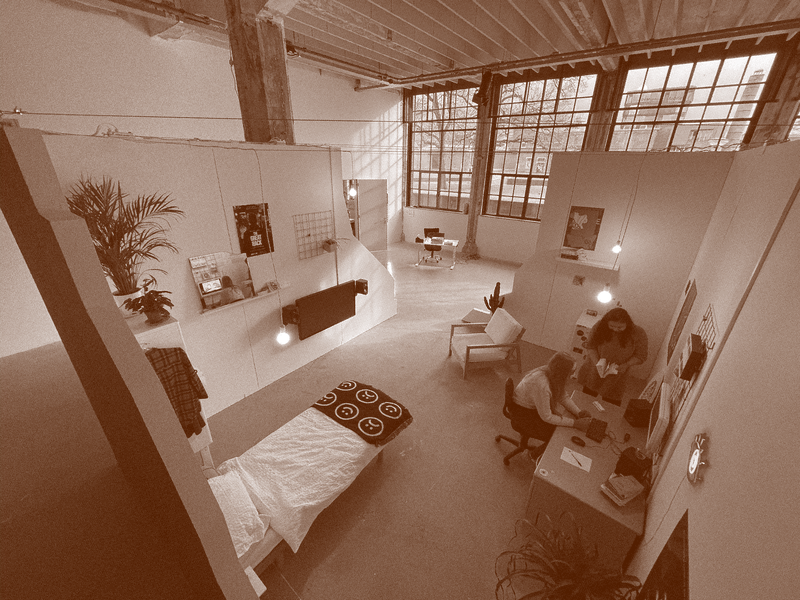
Roos Groothuizen’s ‘I want to delete it all, but not now’ unsolvable escape room.
13:06 For me, in my artistic practice, I always choose games as my medium of choice. What I think is so interesting about game elements in and of themselves is that your audience, or the audience of the art piece, becomes an active participant. They are forced to take on a role within the theme you’re addressing. about the commentary and what is going on onstage As a player, you can of course choose what to do with that, but you are forced to take a position. I think that creates really interesting interactions with the piece, but it also creates interesting conversations with the audience afterward. so sweet This makes me very happy. “ADHD friendly event” impossible? That’s why I think that with hybridity, experimenting with these types of game elements, like in Project Stargaze, also creates interesting conversations. How far can we take this with, for example, placing a camera somewhere? It is a playful way of figuring out what to do with the things you have.
Archives, Narratives, and Physicality
14:25 Yeah, I think playfulness is something that is very common in gaming. It’s something you mentioned, when you step into a game you know what is expected of you, or you know your way around because of the concepts or storylines or whatever. so sad we cannot report also that :/ Turning towards archives… Archives are institutions in which a lot of people don’t know their way around or can’t figure out how to access or add to them. Could you tell us a bit about how you worked on archives to make them more interactive? Because audioyou used testimonies and other forms to let people add to archives and make them more interactive, or activate their audiences. also what?
15:12 Yes. This was a project that we did together with MU, Varia, Willem de Kooning, and Hackers & Designers… I’m trying to remember all of the partners. The project was linked with the MU archive and it was thinking about how you remember, and spacehow you create a living and a dying archive of an exhibition space. We built this platform where audiopeople could leave their memories or even ‘false’ memories of MU. that :/ We created different paths that people could follow on the platform. During the Living Archives group’s expert session for the In-Between Media Conference, the emphasis on oral testimonies, audio and video recordings as a mediums to challange hierarcies within archives was brought to the table. To read the event report of this day, check out: https://networkcultures.org/goinghybrid/2023/03/31/expert-session-a-living-archive-is-also-a-dying-archive-conference-report-day-2 If they’ve never been there before, they could just leave a memory of what they imagined the space to be like. You didn’t need the experience of being there physically. It disrupts this idea of the institution controlling the narrative of what the archive looks like and tries to play with that. anything is possible, kendal And there’s also the fact that we always misremember and that our memories are fluid, changing things. i hope so We really tried to take that into account in a playful way by having this space where people can think back or even speculate about what kinds of things might happen within this exhibition space. 🙏 hope is the only way 🙏 To leave a real of fictioned memory of Mu Hybrid Art House, visit the Living Archive’s MUmories website: https://mumories.hackersanddesigners.nl/Welcome.
16:43 Allow me to get philosophical a little bit: If you look at the fluidity of memories and of speculating about them that also changes the way we look at the truth perhaps. Is that something you have considered in your practice? the live whispering and giggling, but maybe it’s fine also that some things will just get lost in translation hopecore
17:00 Yes. Angelique, who is the director of MU, was also open to this idea of having things that were not true… hell yeah So speculations, or ideas, or just things that were not necessarily tethered to a specific lived reality. We played with this idea of the space for imagination in that kind of environment of the archive.
17:31 I love that! Is this a moment to check in if there are questions in the chat online? I like board games and cards but this sounds interesting Ill download a game app Ok lowkey getting back to the convo on stage; I think this is the first time I feel part of an organic archive building
[00:18:04] Yes. I’m going to repeat your question through the mic. So we started out with thinking about a 50/50 balance between the agency of different audiences offline and online. Should we challenge that thought? Or challenge thinking of it in this way, and look more towards the specifics of a medium, or platform, or ways to engage? Happy to hear that you know what an app is, Madame Bertha
Agency for All Audiences
18:32 The question made me think of what Benjamin Pompe did in his game. He gave the online audience extra agency. The in-house audience was supposed to answer certain questions but they weren’t able to see the consequences, because only the online audience could attach consequences to certain decisions. performanceSo the online audience was disrupting the in-house audience. A similar experiment was conducted by XPUB 1 students in a radio broadcast titled ‘The Hitchhiker’s Guide to an Active Archive’. It was a choose-your-own-adventure story which depended on the interaction of the audience to function. For further mention of this, see ‘Chapter 4: Forms of Hybridity’. Of course, we come from a past where being present online is considered like a second level. memoryzing is always speculating, with a touch of fantazy much often I mean, that’s only what you do when you can’t travel there or whatever. Being in the physical space is thought of as the best thing you can do. To balance that, he played around with giving the online audience more agency and power over the in-house audience. And I think when the default situation is online, like in gaming, then maybe off-site people have more agency. It depends on where you’re coming from and how you’re spacemaking this environment into a hybrid environment. If it’s an websiteonline gaming environment, then the hybrid situation will perhaps put the in-house audience at a disadvantage. Because it’s not the natural habitat for a game. So to answer the question, it depends very much on what the original format is and how you want to bend it into a hybrid format. To find out more about Benjamin Pompe’s work ‘The Great Idle’ check out: https://benjaminpompe.com/project/the-great-idle
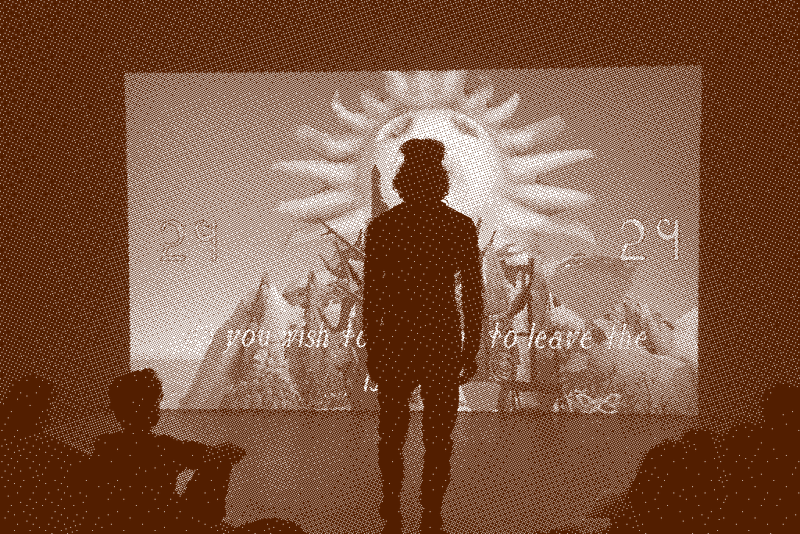
‘The Great Idle’. Hybrid performer awaits the audience’s votes. Photo credit: Impakt.
19:58 This also makes me think of narratives… If we see this as storytelling or developing stories through events or archives, we have to ask: who is telling the story or has the power to tell the story? Who has influence or power over the narrative? It also makes me think of interdependencies between different audiences… Is there something from the archives group that ties into that?
20:32 My thought is that when it comes to a 50/50 balance, it doesn’t mean that both parties have the same level of agency. There are different things at play when it comes to treating both parties equally. Derk and I defined a good hybrid experience as both parties being engaged on the same level. So not being engaged in the same way, but having the same amount of engagement. I think that thought can be contested for sure, but for us, it was a good way of figuring out what we’re trying to reach. Based on that definition, we made that experience. During an early brainstorming meeting at IMPAKT, one of us mentioned the hostage factor, which is when an offline audience always feels more engaged because they are ‘being taken hostage’. takes up a lot of space though, we need to be mindful about what we want to keep in storage spaceYou're all sitting here and feeling that ‘I’m not going to call my friend right now, or stand up and get a sandwich somewhere else’ because you have this feeling of respect towards what you’re seeing. When you’re online, sitting at home, you don’t have this limitation at all. We kept that in mind and made a game where the online party is absolutely needed. Otherwise, if they’re not participating, the game can’t work and they won’t win the challenge. So we implemented the ‘hostage factor’ for our online participants to figure out this engagement question.
22:26 I’ll just respond to the 50/50 question. I don’t know how it links to archives but a lot of the work I do with The Hmm is also about hybrid events. /camera: 45 I was just going to say that I think spacewe have to be careful about prioritizing the physical space. FREE THE HOSTAGES!!! Being physically present in an event is not always the default case for everybody or the best experience for them. /camera: 45 breaking the fourth wall right now, the reporters are on the spotlight /camera:180 And for me, that was maybe the most disappointing thing I’ve seen: cultural institutions completely dropping forms of hybridity (after COVID). websiteBuilding live streams, then dropping them and not continuing with hybridity. Because it actually created a lot of access for people, which was mentioned in the last talk. in this chat we are not really hostages actually :) /camera: 180 See ‘Chapter 2: Thresholds of Access’. That’s also tied into this idea that we really prioritize physically gathering together. I am a hostage :( But I think we have to shift away from that idea, and consciously come back to what these hybrid events brought us because they brought a lot. /camera:20 That’s why I really like the question about whether we can move away from the 50/50. A lot of assumptions are held about who the audience is and what they prioritize. Maybe that’s an element we value, but that’s not necessarily the case for everyone. The more we continue with these practices, the more people will know that there are accessible spaces that they can enter, and that we don’t always just prioritize physically gathering together. /camera:45
24:10 I think it’s really interesting what you said about hybridity bringing us a lot more than we maybe even expected to begin with. I have a question for Roos and Margarita, maybe a speculative one. Roos, you told us that the conversations you’ve had after the game were just as important maybe as the game itself. And I was wondering what were the unexpected things that you talked about afterwards. Additionally, how could you archive the things you learned in a hybrid way that makes sense? (To make a bridge between the two of you with this question…) camera:30
24:47 This is a very difficult question. A lot of people ask me about the question of archiving. What do you do with this information? textDo you write it down? Do you document it? I’m like: ‘No, that’s not what it’s about’. I do use it as a tool for the next projects and it’s also a learning experience. Arjon mentioned the Escape Room project, which I did in 2021 in the middle of the pandemic. spaceI created an escape room that you couldn't really escape out of. It was a commentary on us trying to escape from the big data platforms like Google, Facebook, and Instagram, but constantly returning back to them. And that this feels like an endless quest. In the escape room, you could play it in the traditional way: go with your friends and figure it out. But because it was during the pandemic, I also had an online experience in which the host of the escape room would videowalk around with a body cam. The host would connect with a group of friends that would websitecall in via Microsoft Teams. So the group would see through the eyes of the host and tell them: ‘Oh, open this door, please.’, ‘Please look at that.’, ‘Enter this code’. It was interesting since it was a truly hybrid experience and it worked in different ways. In the online experience, people played the puzzles in a different way. The underlying factor of the game was about being dependent on parties you don’t trust. The host played a very important role in the escape room. At some point, you would discover you can’t trust the host or what they’ve said, but you’re literally tethered to the host with a cam. In the offline and the online experience, the level of dependency was completely different, but it still worked out. The conversations that I had with the players afterward were really about these uncanny valley moments of dependency. And I thought it was interesting because it wasn’t really the first reason why I made the project. https://roos.gr/I-want-to-delete-it-all-but-not-now You find out these surprising things and how people experience something you’ve made afterward, but via different eyes. And the players have all been given the same level of agency. Would it be useful to think about archiving (or the future lives) of this kind of experimental cultural programs in a bigger way than within one organisations? Would it help to have a shared infrastructure between cultural institutions and workers? But what players do or how they engage with your project is not always aligned with your intentions. And I find how people engage from different perspectives really interesting.
27:43 Is that experience then temporal or is this something that you would want to archive? Or is it as you’ve said: ‘No, I’m not gonna do that. That’s not what this is.’ Which is also an interesting answer.
27:55 I’ve never really been interested in documenting things. So I guess this is a personal preference.
28:03 We should ask the archive perspective… The issue of dependency and agency seems to return into this conversation often. And this is something important, we are all dependent on the people who make our archives to tell our histories. Is this different in hybrid times? Can we change this in hybrid times?
28:31 That’s a good question. I don’t know if I could answer the larger question of whether we can change this in hybrid times. I’m not an archive scholar, but I think what you’re saying is that some things just don’t get archived. We were working on another research project with The Hmm in which we were mapping hybrid events and also looking at different case studies. Red threads: dependency and agency. Spot on We were looking at it as ‘Is it something that lives forever (forever being a really relative term)?’ /camera:20 and ‘Is it something that you have to be there to experience and then it’s just gone?’. And I think all those things fit on this spectrum of hybridity. /camera:40 Probably not everything has to be preserved. Also because we work inside of these funding structures, textwe always have to document and prove we did things in order for them to be valid. /camera:60 This point was also brought up in the Hybrid Publication’s group: ‘It seems that most cultural institutions are so busy organizing events, that their archives become an institutional obligation to justify received funding.’ This quote was taken from the ‘Introducting the EtherPort’ blog post, to read it fully, visit: https://networkcultures.org/goinghybrid/2023/11/16/introducing-the-etherport . With the Hmm, we would document through our livestream and websitethe livestream would automatically go online. /camera:80 And recently we did a data center tour in which we took a bus and spacemoved around the periphery of the data center. /camera:90 We thought it would be really boring for people to have to watch this back. So instead we created an audio tour. People were audiorecording each other's experiences and the sounds of the data center. I think archiving doesn’t have to be this 1:1 digital twin version of what happened because that’s probably impossible. It’s interesting to rethink the archival format in ways that are different from what the experience was for people who were participating in it. Listen back to the Data Center Tour here: https://live.thehmm.nl/the-hmm-s-data-centre-tour
30:15 So, it doesn’t have to be 1:1 or 50/50. I think that’s a nice way to conclude this topic as we’re out of time. Thank you so much to our speakers for being here with us today!
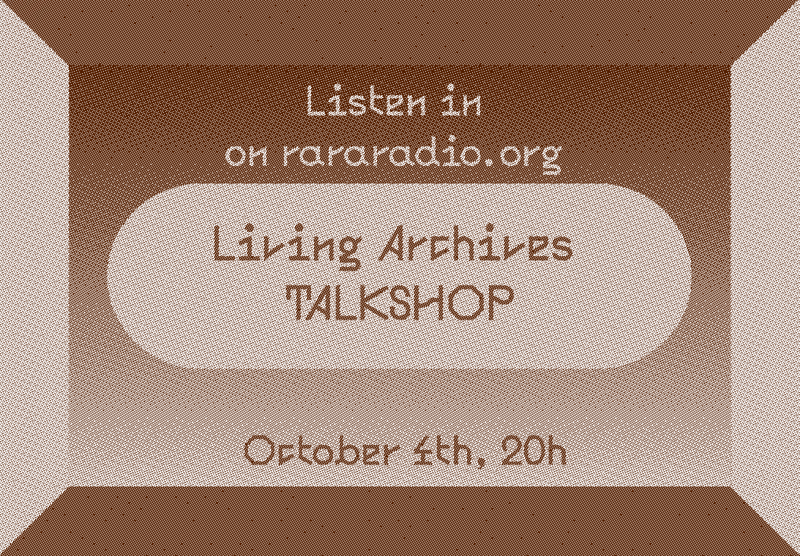
Announcement image for the Living Archives group’s radio broadcast ‘TalkShop’.
About this text
Chloë Arkenbout works as a researcher at the Institute of Network Cultures in Amsterdam. She has a background in both media studies and philosophy and is interested in the tactics marginalized people use to challenge oppressive discourses in the digital public sphere - from social media comment wars to memes.
Esther Hammelburg is a senior lecturer at the Amsterdam University of Applied Sciences and holds a PhD from the University of Amsterdam. She researched ‘liveness’: a historically evolving practice of establishing instances of ‘now here together’ through media practices which align physical and mediated environments.
Margarita Osipian is an independent curator, researcher, and cultural organizer based in Amsterdam. She works for The Hmm, Sonic Acts and W139. She was a member of the Living Archives group of Going Hybrid.
Arjon Dunnewind is the director of IMPAKT - Center for Media Culture in Utrecht, one of the institutional project partners of Going Hybrid.
Roos Groothuizen is a media artist fighting for digital human rights, researching human and non-human aspects of invisible algorithms, information filters, and unfair distribution. With IMPAKT and Derk Over, she developed ‘Project Stargaze’.
This chapter-conversation was originally recorded during the a live event Screentime Airtime Facetime, which you can watch back here: https://vimeo.com/908214312.
Introducing Etherport.org
On the Web 2.0 content is cheap, fast, abundant, and addictive. It’s increasingly difficult to keep even the most dedicated readers interested as they grow more impatient, quickly distracted, and disengaged. Some say that critical reflection online is a mere fable from the past. But we believe that critical reflection is a powerful tool that allows one to formulate questions, confront bias, point out contradictions, and look for new directions. ‘We’ is the Hybrid Pubs research group, consisting of Ania Molenda, Anna Maria Michael, Ashley Maum, Carolina Pinto, Ebissé Wakjira, Gijs de Heij, Maria van der Togt, Ray Dolitsay, Sepp Eckenhaussen, and Victor Chaix. Especially in a time when navigating online media becomes so complex and confusing, it is of critical importance to find ways in which we could re-discover critical reflection and tool up for it. Based on this belief, we took on the challenge of redefining the cultural event report.

The Problem with Event Reports
Event reports are frowned upon, and rightly so. They’re mostly written as an institutional obligation to justify received funding. On rare occasions, someone manages to break the format and create something momentarily interesting. For instance, in the context of Going Hybrid, Clara Balaguer created the audio-text hybrid report ‘Please Turn the Page’: https://networkcultures.org/goinghybrid/2023/03/15/please-turn-the-page. But in reality, the majority of these reports read like the leftovers of an all-you-can-eat banket dinner, a patchy and chewed-out reminiscence of something you probably missed for good reasons, to begin with.
Nevertheless, we take a stance in defense of the event report. These past years the cultural sector seems to be stuck in an overhaul. The quantity of events organized in and by cultural institutions is staggering. Openings, symposiums, workshops, artist talks, and conferences follow each other in rapid succession. Each one puts an even more important matter on the agenda than the previous one. More often than not these events position themselves as offering a start. But what happens when the event is over? Where do all the cultural content, knowledge, and insights go?
Often, they are reduced to videoa 12-hour-long recording of the live stream on YouTube, with no means to decimate any of the information. Sometimes the interested secondary audience is blessed with an textautomated transcription, allowing one to scrape through some of the content. It seems that most of the cultural institutions are so busy organizing events, that the movements they aim to set in motion become an afterthought.
Many of us being cultural workers ourselves, we know the struggle to stay relevant whilst running on next to no funds all too well. In most cases, it’s not the lack of motivation, but a lack of means that creates the barrier to continue. During the Covid pandemic, this issue became more urgent than ever before. The necessity to engage with hybrid spaces, publics, and classrooms during lockdown acted as a pressure cooker for the ongoing redefinition of cultural publishing processes and reading experiences in the digital era. Some momentum appeared to redefine the event report, and we decided to ride the wave.
Expanding the Event Report - Best Practices
Our main objective was to to find new cultural and digital strategies that expand the room for reflection and collectivity, with the use of alternative ways of online publishing. In this process, we were keen to experiment with making event reports can more open-ended, multi-voiced, and non-linear. Instead of creating FOMO-inducing descriptions, or bureaucratic documents, we wanted to create a structure for event reporting that would give readers an interesting, explorative experience. We looked at textreal-time transcriptions and instant publishing, non-linear and modular formats, objecton-demand printing stations as part of spaceexhibitions, and audioaudio-texttext hybrids. We found inspiration in zines, websiteinteractive digital longforms, wikis, annotated maps, hybrid indexes, chat-to-print tools, objectbook printing machines, and performanceinterventions in spacepublic space. There are so many alternatives to the boring and bureaucratic event report! Among the interesting practices we found, five deserve a special mention:

Screenshot of an Are.na channel. Print Are.na scrapes the content of an Are.na channel and combines it into a printable file.
Print Are.na allows to make a objectbook from a websitepublic Are.na channel. Print Are.na was created by Mindy Seu, Charles Broskoski and Ekene Ijeoma. print.are.na uses bindery.js, an open-source library for creating books using HTML and CSS, created by Evan Brooks. The first version print.are.na was created by Callil Capuozzo for the 2017 Cybernetics Conference. Explore Print Are.na here: https://print.are.na. Are.na is a popular tool among creatives for public-private archiving which supposedly helps you to ‘organize your internet and expand your brain’. It allows to create simple collections by posting and reposting in a blog- or feed-like structure. Print Are.na scrapes a public Are.na channel, structures and paginates the content, and creates a printable .pdf. It can be used to print at home or create a serious book through the print-on-demand service Lulu.
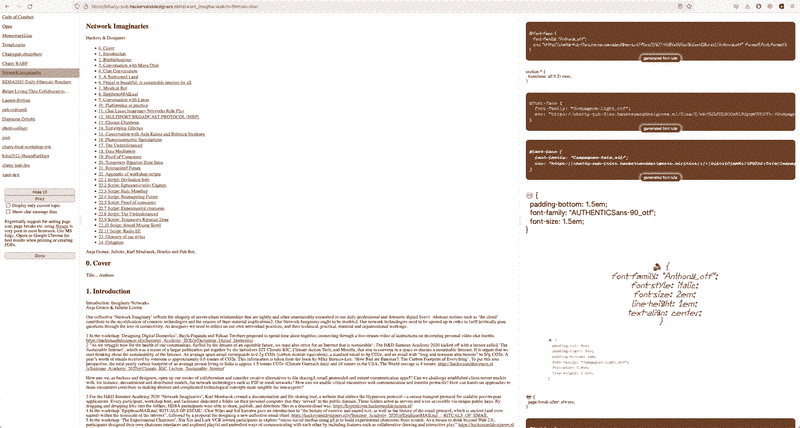
Screenshot of a ChattyPub publication on the website of Hackers & Designers.
ChattyPub is a design tool in the making developed by Hackers & Designers. Explore the ChattyPub archive here: https://chatty-pub.hackersanddesigners.nl. It leverages a chat interface to apply styles and formats to the content of a publication. ChattyPub is a collaborative publication/zine-making tool built on top of the chat platform Zulip. By sending messages, reacting with emoji and writing simple CSS style rules the publication can be collectively designed. Concretely, this means that every texttext sent in a chat is automatically added to the websitefront-end publication. The primary output of ChattyPub is a web publication, but objectautomated print versions of the files can be generated, turning the chats into hybrid publications. The use of ChattyPub requires chatters-authors to use basic coding, so it is not intuitively useable for anyone. However, with a little teaching, it’s a very low-threshold way of playfully publishing together with surprising outcomes. Some examples: https://chatty-pub.hackersanddesigners.nl/Open; https://chatty-pub.hackersanddesigners.nl/Lauren-Berlant; https://chatty-pub.hackersanddesigners.nl/photo-collage. With ChattyPub workshops, Hackers & Designers teach participants to use the tools and, ideally, create a publishing community in the process.
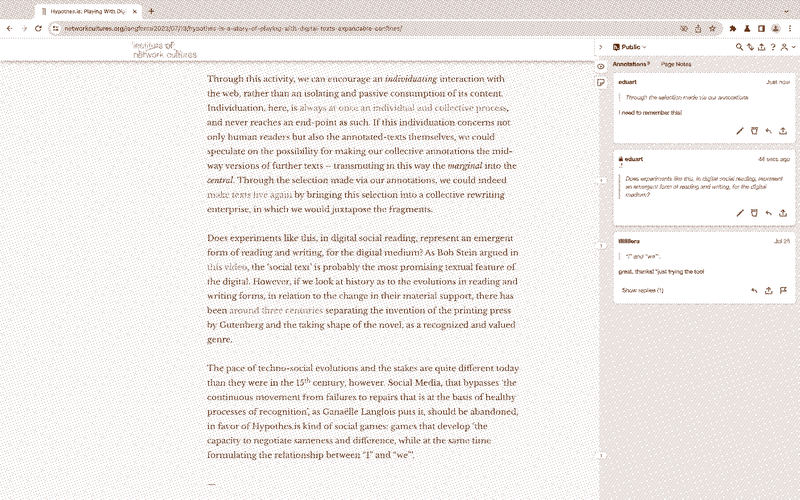
A screenshot of the Hypothes.is plug-in, overlaid on an article by Victor Chaix on the website of the Institute of Network Cultures.
Hypothes.is is a free Chrome extension that lets users websiteadd annotations to websites and have discussions on websites. Download and explore Hypothes.is here: https://web.hypothes.is. Opening this bookmarklet spaceprojects a transparent layer over any website, PDF or ePub, in which one can comment and annotate even when the original website does not provide that possibility. Moreover, other users opening that same text, will be able to see others’ annotations and react to them. Comments section on YouTube closed? Just open the Hypothes.is bookmarklet and comment away. It is obvious that Hypothes.is, as a unique and powerful tool against centralized power and censorship, is extremely promising for educators, journalists, researchers, publishers, and activists. However, it is evenly vulnerable to trolls and spam. Victor Chaix developed the idea of ‘digital social text’ using Hypothes.is. This idea is discussed in ‘Chapter 4: Forms of Hybridity’.
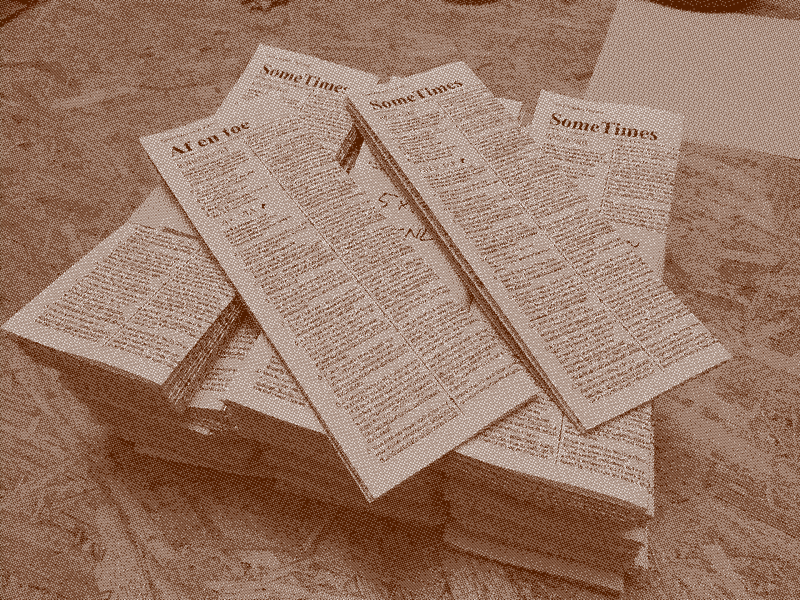
The print version of SomeTimes / Af en toe, the hybrid newsletter of Varia.
In 2022, Varia started publishing the hybrid, bilingual textnewsletter SomeTimes / Af en toe. Read SomeTimes here: https://varia.zone/en/sometimes-af-en-toe.html. The contents are created collectively by the members of Varia in OctoMode and published as text.pdfs and objectflyer-like prints. The format of these newsletters is a direct expression of the collective working process Varia uses. According to Simon Browne, contingent librarian and member of Varia, it cost some time to set up the template, but it’s pretty simple in its use. The .pdf newsletter is a seamless extension of the websiteVaria website, spreading news on events and projects to the collective’s (international) network of cultural workers, geeks, and organizers. The print version, which feels like a crossover of a flyer and a local newspaper, allows for a bigger spacepresence in the Rotterdam neighborhood. This reflects a tendency within Varia during the lockdowns, to not go online, but to focus on the hyperlocal and provide a community space. Urgent, hybrid publication in the arts doesn’t always equal digitization, but rather an adaptive workflow and method that allows for the right hybrid format according to needs.
To question and circumvent paywalls that enclose knowledge that should be public, Maria van der Togt has created the artwork Hard Copy Soft Copy—Impermeable Domains (2021). Read more about the work here: https://sandberg.nl/alumni/maria-van-der-togt/work/hard-copy-soft-copy–impermeable-domains. The work consists of websitea virtual platform with an open-source collection of textdigital publications, run on a objectraspberry pi, and a spacespatial printing and binding set-up. Members of the public use the objecton-site computer to select any of the documents and performanceprint and bind it on the spot. In rescuing material from the clutches of corporatization, the work upholds the true definition of ‘public’ through the simple gesture of providing resources without any expectation of return.
The Threshold of Experimental Publishing
However exciting these examples, we also ran into a paradox between the need of urgently building forms of publishing resistance and the general slowness with which many online users embrace the tech. Introducing new tools or methods will always require curiosity and most likely will push audiences outside of their comfort zone. Yet the experimental side of tech in its geekiness tends to create a literacy barrier that scares away many older and younger folks relying on the frictionlessness of contemporary corporate UIs. As a result, experimental publications are often inaccessible and unfit to create more critical mass for resistance in online media. The precarious state of critical online reflection is discussed at more length by Ania Molenda in ‘Online Critical Reflection, a Fable from the Past?’
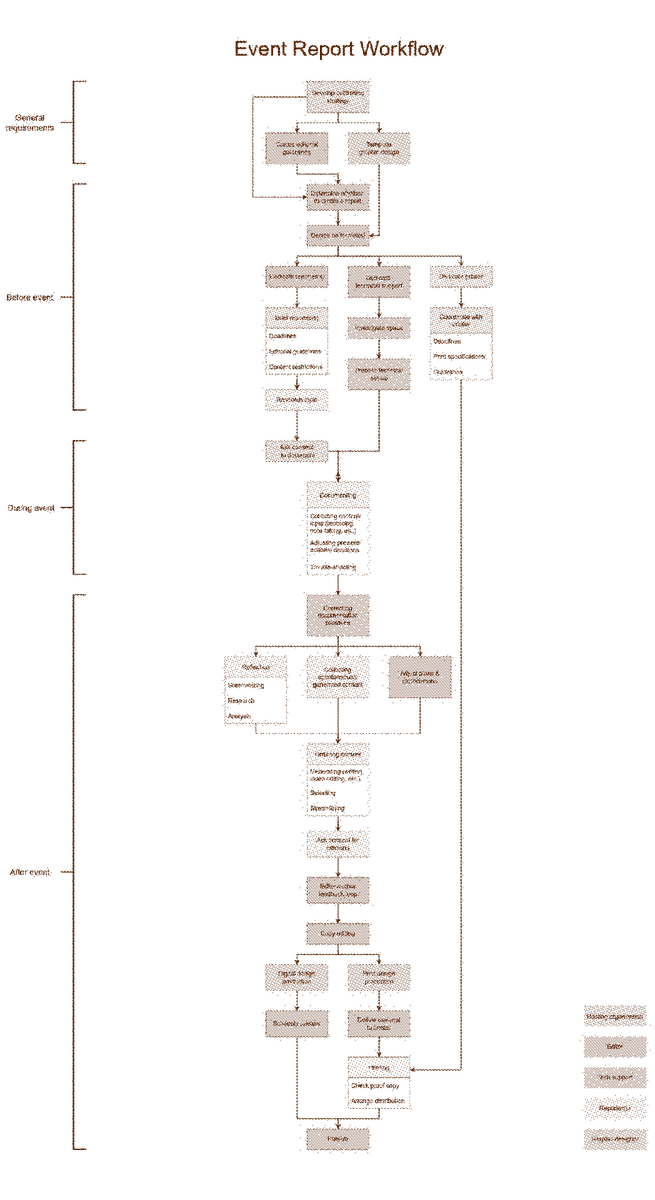
A mapping of the hybrid event reporting workflow created by the Hybrid Pubs research group. You can download the PDF and read more about the workflow on the Going Hybrid research blog: https://networkcultures.org/goinghybrid/2022/10/12/workflow-improvements-for-hybrid-event-reports.
We do not have the perfect solution for this dilemma. But we did find an approach to do meaningful work. Rather than focusing on ‘tech solutions’, we focused on content and working methods. Our methodology was, as Coko calls it, ‘workflow-first design’: https://coko.foundation/blog/understanding-workflow-first-design.html. We mapped the event report creation workflow and discussed possible experiments to see where interventions and hybridizations would be possible, without creating too many barriers or extra worlkload. Read about this process here: https://networkcultures.org/goinghybrid/2022/10/12/workflow-improvements-for-hybrid-event-reports.
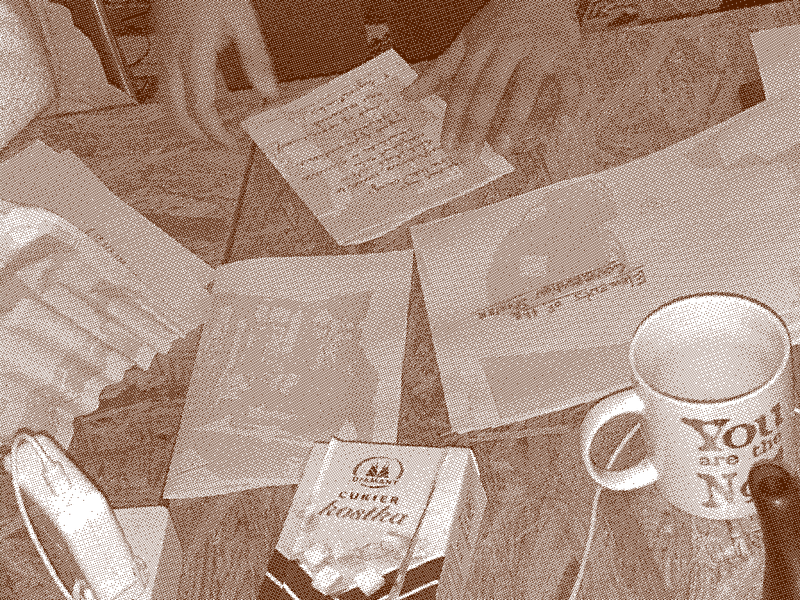
An action shot of the Hybrid Pubs sprint day at Varia in Rotterdam.
Also, we focused on content, having long discussions about what content makes event reports worth reading, what the role of the editor is, how to create space for the author as a craftsperson, and other editorial matters. These conversations led to a taxonomy of elements that make event reports worth reading, which were collected in the Minizine: Elements of a Conversation Starter. Read the Minizine here: https://networkcultures.org/goinghybrid/2022/11/14/minizine-elements-of-the-conversation-starter
A Look at Etherport
Only after the focus on content, we turned to tech, and created a proposal to continue experiments: Etherport. Visit and try Etherport here: https://etherport.org/publications/.
Etherport is a tool for cultural organisations to make more experimental, multi-voiced, and non-linear event reports. The tool helps to standardize the event reporting workflow, reducing production workload and clarifying the role division between authors and editors. It was built by the research group using the hybrid publishing tool Ethertoff, developed by Open Source Publishing collective in Brussels. Ethertoff is a simple collaborative web platform, much resembling a wiki but featuring real-time editing thanks to Etherpad. Its output is constructed with equal love for print and web. Learn more about Ethertoff and Open Source Publishing here: Ethertoff is a simple collaborative web platform, much resembling a wiki but featuring real-time editing thanks to Etherpad. Its output is constructed with equal love for print and web. Let us show you…
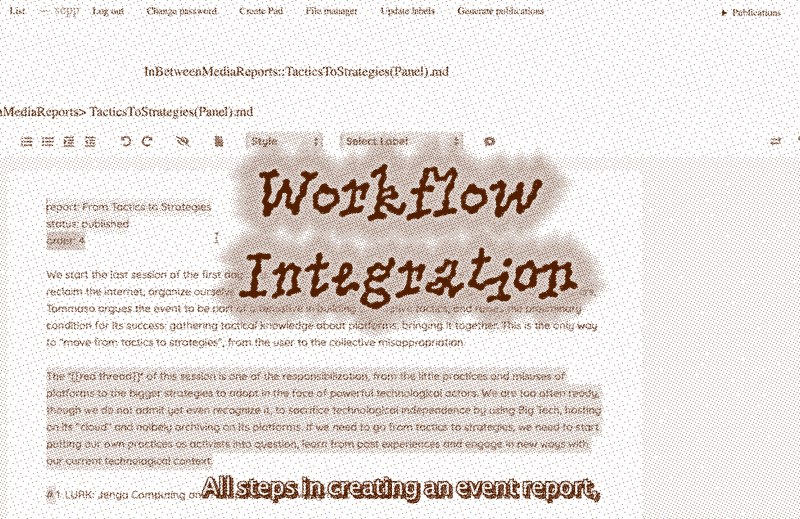
All steps in the creation of an event report, from (real-time collaborative) writing to editing and publishing, are integrated in Etherport.
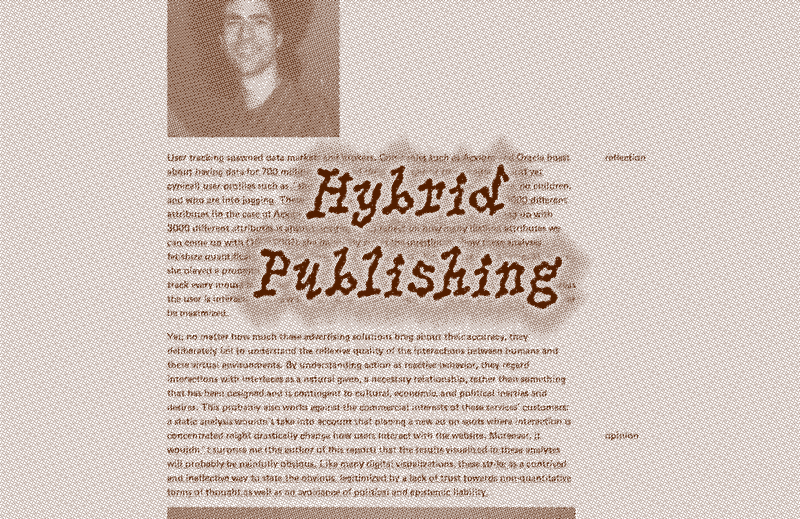
Publisihing an event reports on Etherport generates two versions simultaneously: a websiteweb version, and a objectprintable .pdf.
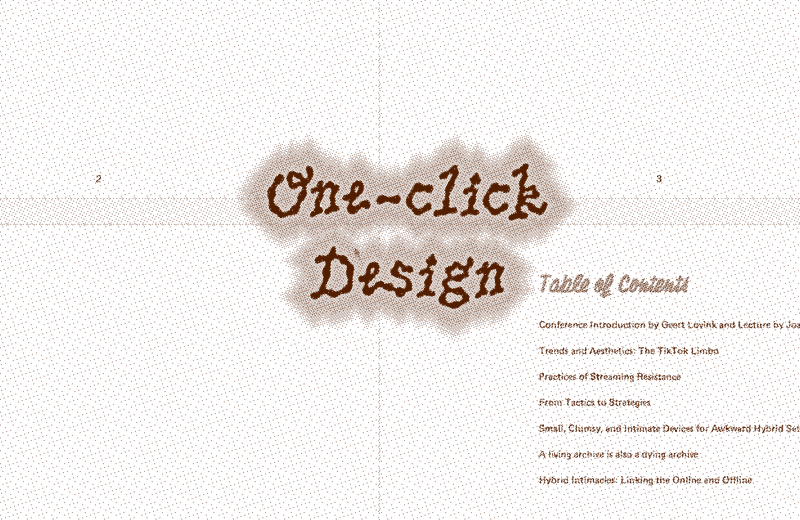
Both the web version and .pdf of your publication are automatically designed using a template. (It is possible to create your own template, to match the visual identity of your organisation, in CSS.)
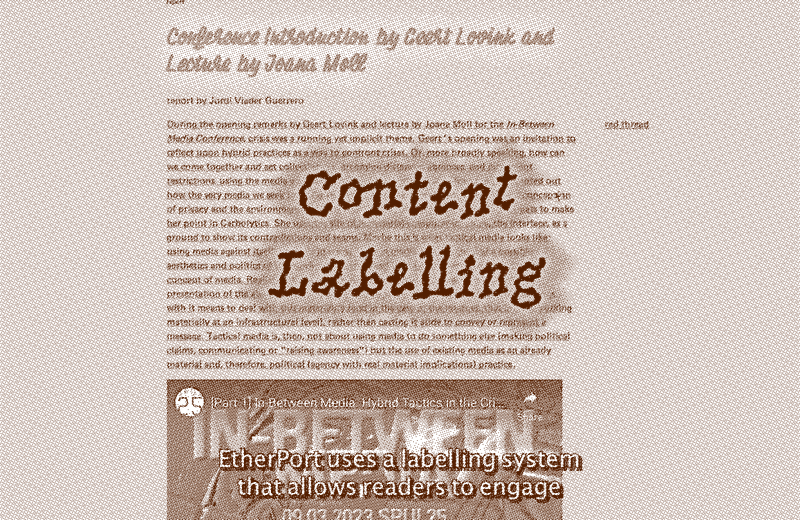
Etherport uses a labeling system that allows readers to engage with the event report in a non-linear way based on theme or type of content. This same feature creates links between reports of different events, which makes it easier to nagivate and activate the event report archive.
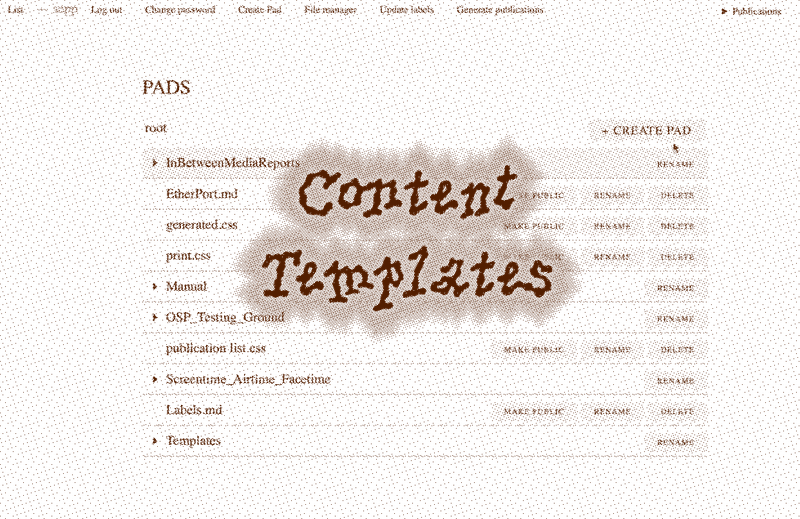
To accomodate custom serialization, it is possible to create pad templates for different types of reports/publications.
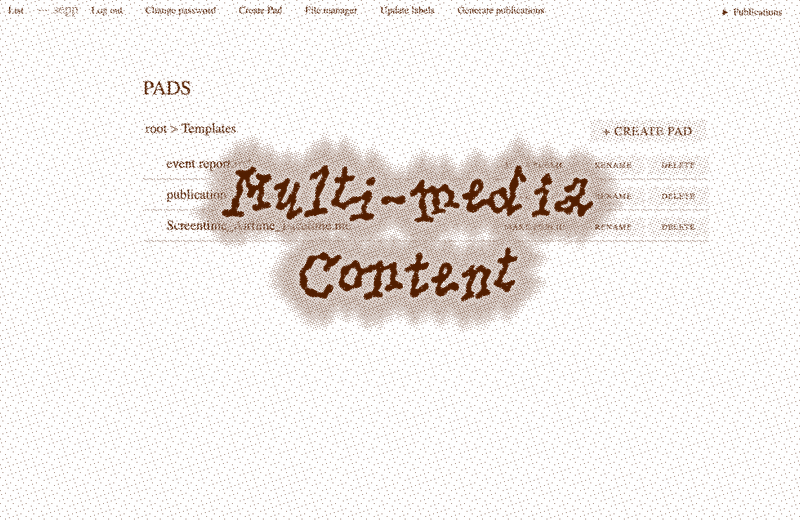
Etherport supports texttext, still imageimages, videovideos, and timestamps.
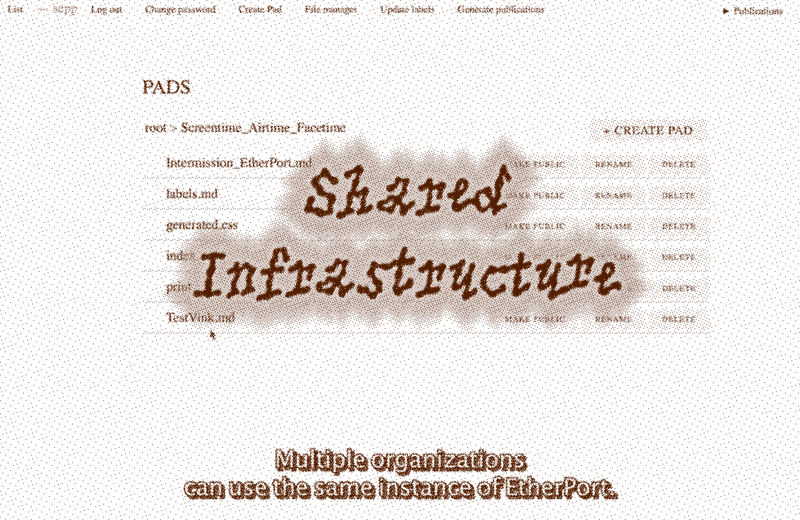
Multiple organisations can use the same instance of Etherport. This shared infrastructure can grow into a shared archive of event reports, in which relations between events from different organisations become visible and navigable.
The Future of Etherport
At the time of the publication of Screentime Airtime Facetime, Etherport is a working prototype. To get a feel of the output of the tool, you can have a look at the conference report of In-between Media that was created with Etherport. You can find the conference report here: https://generated.going-hybrid.gutenberg.club/InBetweenMediaReports
During the first six months of 2024, the Etherport will be developed from a prototype into a fully functional tool by Open Source Publishing and the Institute of Network culture, in collaboration with a group of core users. The outcomes will include a stable, freely usable web tool, and a manual for aspiring users.

Are you interested to learn more about Etherport, or to try it out for yourself in the early stages? Please send an email to sepp@networkcultures.org.
About this Text
This intermission was originally part of the Screentime Airtime Facetime livestream as a pre-recorded video. The text draws on blog-posts by Ania Molenda, Ashley Maum, Ebissé Wakjira, Gijs de Heij, Maria van der Togt, and Sepp Eckenhaussen. The video was edited by Ray Dolitsay, with voice-over by Carolina Valente Pinto and Sepp Eckenhaussen. You can the video through this link: https://networkcultures.org/goinghybrid/2023/11/16/introducing-the-etherport/
Forms of Hybridity
00:04 And we’re back for the final chapter, which is about forms of hybridity. Again, we had a change of hosts. I’m Senka and I’m hosting this chapter together with Jordi. We’re joined by Michael Murtaugh, who is the course leader of the Experimental Publishing MA program (XPUB) at the Piet Zwart Institute. Read more about the XPUB program here: https://xpub.nl As a practitioner, he designs and researches websitecommunity databases, videointeractive documentaries, and tools for textnew forms of reading and writing online. Besides Michael, we are also joined by Sepp Eckenhaussen, who is a researcher at the Institute of Network Cultures (INC) and has been the leader of the Hybrid Publications group of Going Hybrid. Other members of this group were Ashley Maum and Ebissé Wakjira on behalf of Framer Framed, Ania Molenda, Anna Maria Michael, Carolina Pinto, Gijs de Heij, Maria van der Togt, Ray Dolitsay, Tommaso Campagna, and Victor Chaix. Welcome!

Jordi Viader Guerrero, Michael Murtaugh, mushy, Senka Milutinović, and Sepp Eckenhaussen discuss forms of hybridity in cultural programs.
01:07 What is the red thread in this conversation? There are many points of connection. Both Michael’s and Sepp’s groups work with the ‘afterlife of liveness’. Thinking about how the public engages with (post-)live content of, for instance, performancecultural events and audioradio programs, both groups have asked: How to create an afterlife of liveness that also engages with collective practices of sense-making? In their experiments, both groups engaged with different forms and mediums within hybridity, seeking out different narrative structures and forms of non-linearity. Moreover, they’ve experimented with the form of databases, repositories, and protocols. For this work, both groups try to make use of existing open-source tools, such as etherpads and wikis. They also think about hybridity as a way to create publics through the use of different interactions it enables. So hybridity is a way of making things public, but also a way of creating publics. These many points of connection lead me to my first question.
Old and New Forms of Hybridity
02:01 To both of you, Michael and Sepp: What do you think or what do you find to be that tested and tried, old ways of hybridity in contrast to the newer, and more groundbreaking ones? This question was inspired by Andrej Kapor, ‘IHWAT 2022 The Event: Wine Flows and Other Things’, Institute of Network Cultures, 20 June 2023, https://networkcultures.org/goinghybrid/2023/06/20/ihwat-2022-the-event-wine-flows-and-other-things. In this blogpost, Andrej refers to hybrid connections as a combination of groundbreakibly new and traditional and tested ways. 🪦
[00:02:23] Thanks. Nice question. Big one, too. I’ll just take it from the angle of our research group, which has been focusing on hybrid publications. In the case of hybrid culture, of course, that very easily becomes the hybrid event report. So what is indeed the afterlife of the hybrid cultural event in a hybrid setting?
02:43 The idea of a ‘hybrid publication’ has been around for a long time. It usually is taken to mean a textbook that's available in both print and in websitedigital format. To explain that a bit better, I’ve brought a book. I don’t know if people can actually see it because it’s green, but it’s called From Print to E-books. From Print to E-books: A Hybrid Publishing Toolkit for the Arts (Amsterdam: Institute of Network Cultures, 2015), https://networkcultures.org/wp-content/uploads/2014/12/0419-HVA_DPT_from_print_to_ebooks_OS_RGB_aanp_lr_totaal.pdf. This book is the result of a previous INC research project, about ten years ago, in which Michael was also involved. The research blog of this research project, called Digital Publishing Toolkit, is available on the website of the INC: https://networkcultures.org/wp-content/uploads/2014/12/0419-HVA_DPT_from_print_to_ebooks_OS_RGB_aanp_lr_totaal.pdf. It’s a workflow for making a print book that’s also available in two digital versions, ePub and PDF. I would say this is the old and tested and also proven form of hybridity in publication making. Since 2015, the Institute of Network Cultures has published over 50 books using this workflow, most notably the Theory on Demand series: https://networkcultures.org/publications/#tod. It is now adopted by the mainstream publishing industry as well.
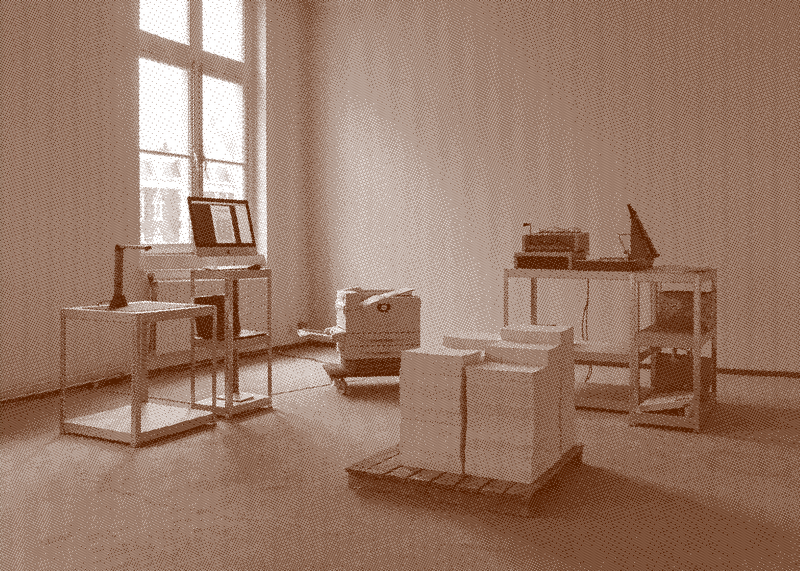
Maria van der Togt, Hard Copy Soft Copy. Installation view from 2021.
03:40 Now, within the context of Going Hybrid, we’ve been looking at expanding or exploding the old methods of hybrid publishing into different media, into audioaudio, into spaceonsite interventions. green book gets keyed We had multiple people in our group that were doing experiments like this. For instance, Maria van der Togt created the work Hard Copy, Soft Copy: a websitelittle local server hosting a ton of pirated textbooks, combined with an objectonsite book printing station. Read more about Hard Copy Soft Copy here: https://sandberg.nl/alumni/maria-van-der-togt/work/hard-copy-soft-copy–impermeable-domains. Another example is Victor Chaix, who developed the concept of digital social text. Victor Chaix, ‘Hypothes.is: Playing with Digital Texts’ Expandable Confines’, Institute of Network Cultures, 2023, https://networkcultures.org/longform/2023/07/13/hypothes-is-a-story-of-playing-with-digital-texts-expandable-confines. He’s looking at the afterlives of online text and how people can create social relationships and meaningful conversations with each other using tools like the websitebrowser plug-in Hypothes.is. Hypothes.is is a browser plug-in that allows the user to (collaboratively) annotate any website. Read more: https://web.hypothes.is. These are different forms of hybridity that we try to explore in different directions from this point. Read more about the Hybrid Publishing group and the backgrounds of the members here: https://networkcultures.org/goinghybrid/2022/07/06/the-crowbar-of-cultural-publishing-introducing-the-hybrid-publications-research-group.
04:47 If you’ll permit, I’m going to respond with an anecdote. Last Wednesday, while I was preparing for this conversation, I heard a audiobeeping noise. It was one of these notification that you don’t know where it comes from. So I ignored it, but it and kept beeping. Finally, I switched back to my computer’s Terminal, which I had open and I was logged in to a server at the school and I saw on my screen:
Broadcast message from zerozeta@chopchop (pts/1) (Wed Nov 8 11:02:27 2023): XPUB is a two year masters program. XPUB focuses on the acts of making things public and creating publics in the age of post-digital networks. XPUB is a good idea, until now. XPUB education is a good idea, but was it enough?
Broadcast message from vitrinekast@chopchop (pts/2) (Wed Nov 8 11:03:49 2023): XPUB is a master program dedicated towards the research of new and old technologies, and their social impact and how we relate to these changes. When the apocalypse happend, many of the larger institutions shut down, and people were left to fend for themselves, in the physical and virtual realm. So, indeed, and XPUB education is a good idea, but was it enough?
Broadcast message from aleevadh@chopchop (pts/3) (Wed Nov 8 11:06:22 2023): It is a safe zone, a bubble, a place for starved, lost, creative minds. XPUB is experimentation! It is being confused but still going. It may be a crash course on how to survive the apocalypse that will soon hit us, but I will learn more about that later.
06:25 I like reading this message out loud now, because it creates a bridge with videoAymeric and Clara's contribution to this publication, which considers this idea of XPUB as a doomsday prepper program. For Screentime Airtime Facetime, Clara Balaguer and Aymeric Mansoux co-authored ‘Intermission 1: Can You Hear Me?’ (For the Record). I think they’re right, in the sense that XPUB really challenges students to think about this question of old versus new. We especially question the idea that equates newer to better. Instead, we try to capture new, different values by working with older technologies.
07:05 This is a bit farfetched, but these beeping sounds were actually the result of a command called ‘wall’ that allows people who share a server to send textmessages to other people who are logged in to the same server. wall, which stands for ‘write to all’, is a Linux command-line utility that displays a message on the terminals of all logged-in users It comes from the 1960s when computing was something very scarce and extremely expensive. As a result of that reality, you needed to create an operating system to make it shareable. It had a sociality embedded in it. By looking at these older forms, we open up new questions around the values embedded in the technology. What kind of choices can we still make?
Linearity, Non-linearity, Multi-linearity
08:03 Besides focusing on the dichotomy of old versus new, to ask a direct question to Sepp: since you’ve worked a lot on this event reporting tool, you’ve closely looked at the structure that event reporting can take. I want to ask you about the forms of linearity or non-linearity you encountered. How can they assist cultural institutions as narrative forms?
08:46 This question has two major dimensions. On the one hand, it’s a bigger question of reading cultures, practices, and values. On the other hand, we can make the question very practical. Let’s face it: most cultural event reports are just really boring. They usually go like: this happened and then that happened and then that happened. No one wants to read that. In the end, this practical question is one of access. How to open up different pathways that are more interesting for people to engage with content in a more meaningful way? Based on the combination of these questions, we started to rethink the cultural event report in a nonlinear or multi-linear way.

A spread from the minizine Elements of the Conversation Starter.
09:31 Our initial approach was more editorial than tech-oriented. On one of the first days we worked together, we made a little objectminizine called text'Elements of the Conversation Starter'. We did that during one day together at Varia in Rotterdam and then risoprinted it on the spot - it was really fun! You can download or read the minizine here: https://networkcultures.org/goinghybrid/2022/11/14/minizine-elements-of-the-conversation-starter. In this minizine, we map out what we find to be meaningful types of take-aways from cultural events. One element is mood or atmosphere. For instance, if spaceit's snowing outside during an event, a reporter might not think about including that in the report, but it’s actually interesting to read because it sets the stage, and sketches a mood. Then, there are also more traditional elements, like interesting quotes, and the red thread of an event. Having defined these types of main take-aways that can make event reports interesting, we started mapping or tagging this kind of content to see what kind of different pathways start emerging from a text.
10:29 Non-linear storytelling has a very long and rich history, especially in game design. For a good overview, see Marc de Bruijn, ‘Non-linear Publication Tools’, Institute of Network Cultures, 2018, https://networkcultures.org/makingpublic/2018/12/13/non-linear-publication-tools. So, once the work became more technical, we could work with many existing tools. You can find an overview of the tools and practices that inspired us on the research blog: https://networkcultures.org/goinghybrid/2022/10/03/relevant-tools-practices-in-hybrid-publishing. We tried working with Twine, which we found very interesting. A previous research program headed by the INC had already explored the possibilities of non-linear stand-alone publishing. The resulting manual Inside Out Upside Down: Discover the Hidden Structures of Your (Digital) Content suggested Twine as an interesting tool. See: https://networkcultures.org/makingpublic/wp-content/uploads/sites/45/2020/03/Upside-Down-Inside-Out-Manual.pdf. In Twine, you can create different types of blocks of texttext that can then link to each other in different ways to create a weblike structure. But after a while, we found that the backend of Twine turned out to be more interesting than what we could make with it on the front end. In the end, we ended up working with a simple tagging system, and integrated this in the final prototype of Etherport. Etherport and its functionalities are introduced in ‘Intermission 3: Introducing Etherport’.

The backend view of a non-linear cultural event report in Twine, created by Ashley Maum in the Hybrid Pubs group.
11:15 To come back to the larger question of reading culture, the promise behind Etherport is not just one of a shared infrastructure between different cultural institutions. What Victor Chaix tries to define with this concept of text'digital social text' is a new reading culture. A culture in which the reader has more agency, and can start interacting with and ideally adding to the text while engaging in conversation with other readers. As a consequence, this ideal type of new event report is more of a ‘conversation starter’ that couldn’t be contained linearly even if you wanted to. check out the minizine here: https://networkcultures.org/goinghybrid/2022/11/14/minizine-elements-of-the-conversation-starter
11:52 Thank you!
Experimenting with Protocols
11:56 Sepp is talking about our new reading culture. I think it’s a very interesting concept, which implies new protocols too: a structured way to read, share, and understand each other. thanks for the link runs! But there might also be a tension between experiments and protocolization. Michael, do you have reflections or thought about that tension? Looking at all of the work you’ve done with XPUB masters program, how can we understand the protocol beyond a firm set of rules that constrains us?
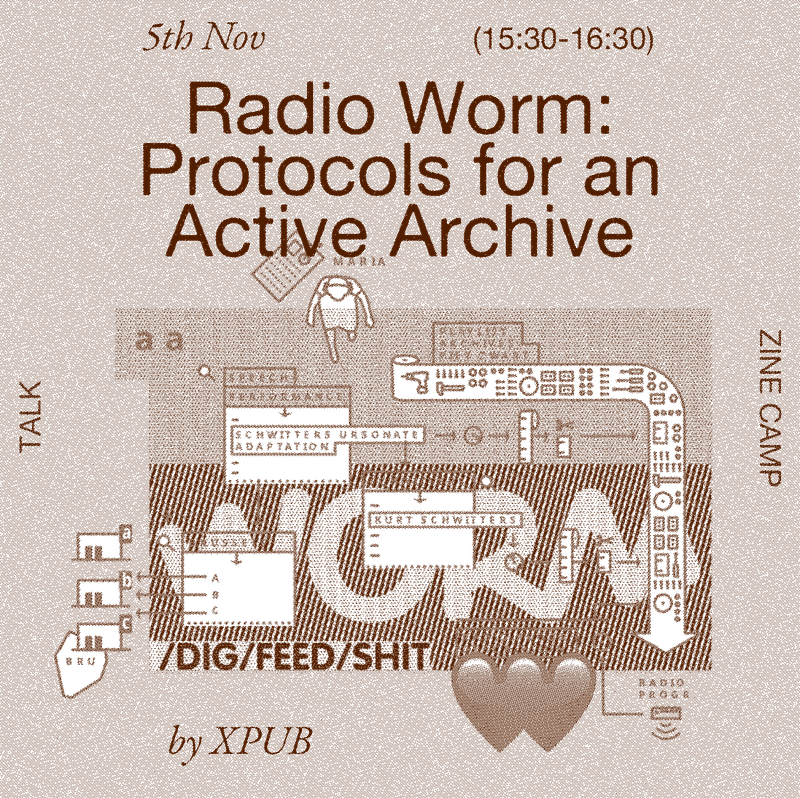
Announcement of the XPUB radio show at the Zinecamp 2023 in Worm, Rotterdam.
12:42 I’ll start by giving some context. Since September 2023, XPUB has taken part in Going Hybrid, so we came a bit late into the process. Going Hybrid started in January 2022. Since then, we have been running audioa weekly radio program at Radio Worm, which is an online radio stream. Each week, Tuesdays from 10 to 12, we’re producing a radio program ‘Protocols for an Active Archive’. A texttranscribed excerpt of that program is included in this book as one of the intermissions. In that snippet, Leslie, our course coordinator, describes pushing back on protocols. performanceIt's a very personal story of a friend who resists the conformity imposed by an outdated dress code.
13:40 Protocols define conformity. But in social situations without a protocol, something emerges that Jo Freeman has famously called ‘the tyranny of structurelessness’. https://radio.worm.org Jo Freedman, ‘The Tyranny of Structurelessness’, 1970, https://www.jofreeman.com/joreen/tyranny.htm. The problem is that without a protocol in social situations, you often fall back into established, implicit power relations. So having explicit protocols is quite important. more info on this kind of new reading culture here: https://networkcultures.org/longform/2023/07/13/hypothes-is-a-story-of-playing-with-digital-texts-expandable-confines
14:08 An important text that we read in the XPUB program is textSimon Yuill's 'All Problems of Notation Will Be Solved by the Masses'. Simon Yuill, ‘All Problems of Notation Will Be Solved by the Masses’, Mute, 23 May 2008, https://www.metamute.org/editorial/articles/all-problems-notation-will-be-solved-masses. In it, Yuill described how musicians in the sixties and seventies devised various forms of protocols, as well as different systems of textnotation, to break out of the esthetic and social conventions. Think of examples like audioCornelius Cardew and the Scratch Orchestra. student-at-the-back is brought to the front without anticipation I feel disturbed in my distanced identity For example: https://www.youtube.com/watch?v=AnN5bAkd6jw&ab_channel=INVIGORATION. These protocols would often have the form of games that played around with leadership roles. The point is that, just like a children’s game of tag, you’re playing out different possibilities and it’s disrupting the established order. There is not some informal, implicit leader, but by defining a protocol together, these people speak about who’s the leader now, and how and why to give the leadership over to someone else. /camera:75 performanceAfter this conversation, performers are more 'awake' and responsive to each other. I think it’s really exciting. /camera:70
15:36 From this text, we draw links to educational coding projects like Logo; or contemporary coding practices like free software, hackerspaces, and live coding. Yuill writes:
16:14 This is the context in which we’ve worked with Radio Worm. Worm is a Rotterdam-based alternative community radio broadcast station. See and listen here: https://radio.worm.org. It’s been a privilege, because whether it’s an old form or a new form (probably both), radio gives an incredible amount of freedom. Ash Kilmartin, who works at Radio Worm and is a prolific radio maker, gave an interesting example of protocols for radio. She has developed what she calls the ‘back-to-back’ protocol for the radio program ‘Ever Widening Circles’ which she makes with a partner. Listen back to Ever Widening Circles on Mixcloud: https://www.mixcloud.com/EverWideningCircles/stream. It involves preparing a base of music, but then coming together and sitting and engaging in a game of playing things from the prepared playlist in an unannaounced order. Then, the other person, on the fly, tries to respond with what they play in return. It’s a really nice example of how to embrace the excitement of liveness in a playful protocol. The listener hears directly what is being done by the producers. /camera:75
18:04 It’s interesting. I think a lesson is that protocols can be empowering as well. good to be challenged student in the front They can create possibilities for people to act in a way that they couldn’t without having protocols. Protocols can empower a new type of culture. By that, I don’t mean that protocols replace new culture. The idea that protocols can replace culture or meaningful interactions between people is a common misunderstanding encountered, for instance, in the discourse around blockchain. This is nonsense. On the contrary, we can use the protocol as a basis to start inventing new types of relationships. I feel like that’s what is happening in the experiments described by Michael.
18:51 In the Hybrid Publications group, we worked with the definition of hybrid as a new combination of existing formats. This implies new protocols insofar as hybrid cultures combine existing forms, tools, and formats into new workflows, that in turn create new approaches to cultural production. We found it important that these new protocols don’t dictate practice too much, but instead create space for the good old and tested craftspersonship of, for instance, the event reporter. The method used by the Hybrid Pubs group was workflow-first design. They mapped out the entire workflow of event reporting. Sepp Eckenhaussen, ‘Workflow Improvements for Hybrid Event Reports’, Institute of Network Cultures, 12 October 2022, https://networkcultures.org/goinghybrid/2022/10/12/workflow-improvements-for-hybrid-event-reports.
19:28 This very live-publication is a good example. There is a websitechat room in the live stream, where live annotating takes place as we speak. The livestream platform of The Hmm, which was used for this live-publication event, often hosts a lively chat. The texttext from this chat will literally be the annotation of the book that will be produced after this event. I can share the protocol that was developed for this purpose. A group of five people are dedicated reporters in that chat, and they’ve all assumed different roles. !!! They are doing a roleplay together that enables them to comment on this event in their specific way. It creates a new, alternative linearity within the publication. The chat conversation can take different turns and then come back to what we were talking about now. For instance, about half an hour ago, the people in the conversation-chapter were talking about game design while the chat was going on about #hopecore. This freedom to diverge and later converge again is the result of the reporting protocol that we’ve created together. #craftpersonship
20:34 I would like to follow up on this idea of the hybrid as a new combination of existing formats. XPUB students have been working with the very old medium of radio. But I know that they’ve also been thinking about new ways to activate the public, to make radio less of a one-directional medium. 🫂 Michael, can you comment on that and give insight into what they were experimenting with? 🦄 shoutout to the chat
21:03 We were working with a lot of older media, like cassette radio players, and detourning them. We also explored how technology, especially new, so-called ‘cutting-edge’ technology, tends to be extremely prescriptive, which limits its use. The term ‘prescriptive technology’ was coined by Ursula Franklin in The Real World of Technology (1992), https://archive.org/details/the-real-world-of-technology. Prescriptive technologies organize work as a series of steps that require the supervision of a boss or manager, and are opposite from holistic technoloqies, which allow the worker to have oversight over the entire production process. The effort to circumvent this prescriptive, one-directional technology can, again, be explained in terms of social protocols.
21:27 Each Tuesday, we would have an interview. textWe had an Etherpad, where we would write some possible as we started to think, and in the process, we would allow our focus to shift. Etherpad is an open-source web tool for collaborative writing. I think this resonates with the earlier discussion about the archive. Michael refers to Chapter 1 Radio Worm’s archive shouldn’t be just about collecting all the audioMP3s and dumping them somewhere, as, by the way, they’re already doing on websiteMixcloud. Maybe we should focus more on the community, on how this radio is made, and who the makers are. And so we’ve shifted to interviewing the makers. Tuesday morning we started for the first time at the studio with no set ‘caretakers’, as we call them (in the past we had prearranged a caretaker role). ‘Caretakers’ are the students in the radio studio during the broadcast, who take care of that weeks radio show plan. We started by playing a recording of something we presented on Sunday at the spaceZine Camp in Worm. To find more about Zine Camp 2023 check: https://zinecamp2023.hotglue.me/?home. While that was happening, the class was voting on questions to ask the makers. Then, performancewe had a rotating shift, of different question askers and engineers to do the mixing. unfortunately we need to keep a low volume here :( Ash, Lucas Simonis, and Lieuwe Zelle, the main makers of Radio Worm, got asked these questions. It was in the space of 48 hours, so much had been happening. We were textconnected on the pad but also spacevisible through the studio window. I think that was an amazing experience.
23:02 I’d like to bring up another experiment that XPUB students have done. In the choose-your-own-adventure game audioradio broadcast, the audience could textwrite in an Etherpad and guide the people who are audioon the radio where they’re going next, and which part of a narrative they’re performancepresenting. This game was based on David Maroto’s research into the ‘Choose Your Own Adventure’ gamebook, which was very popular in the 1990s, just before the advent of the internet. See: https://www.davidmaroto.info/The-Wheel-of-Fortune. Radio was no longer one-directional, but the audience had agency and even guided the people who were supposed to be the presenters. They were changing the medium and allowing it to be more than what it was conceived to be. The choose-your-own-adventure radio broadcast was called ‘The Hitchhiker’s Guide to an Active Archive’
23:46 Absolutely! That was a great experiment.
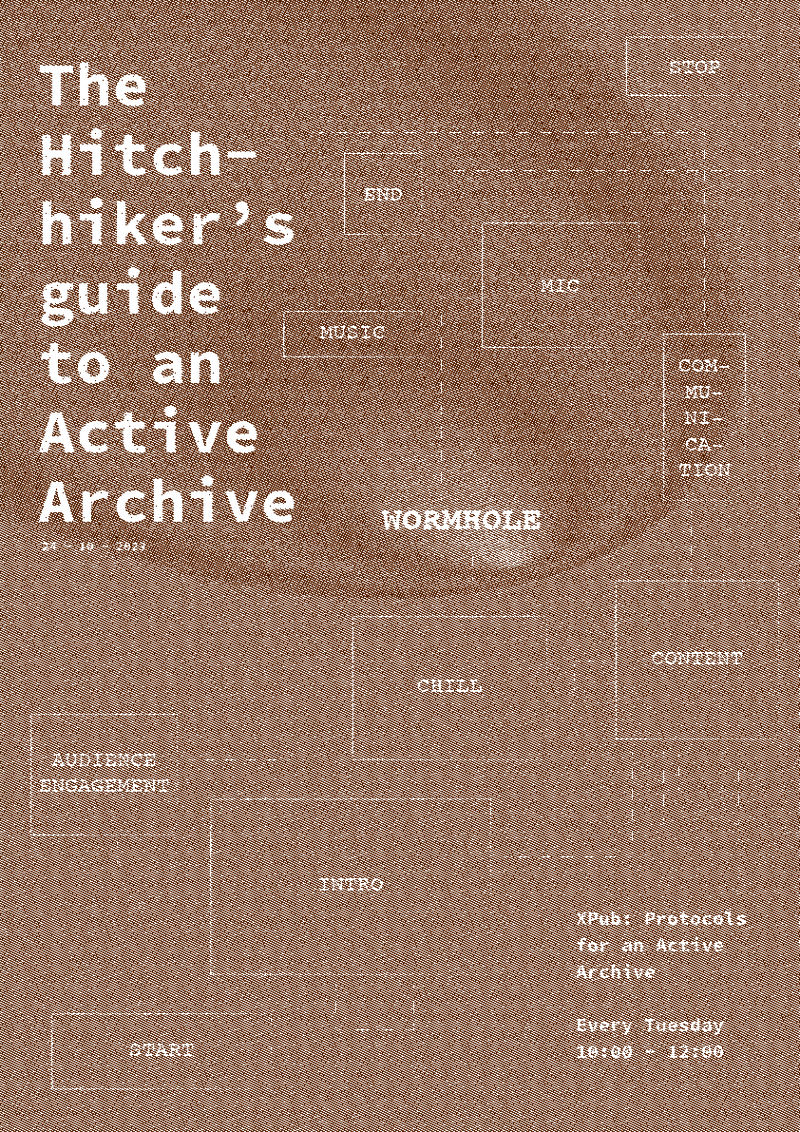
Announcement image for the choose-your-own-adventure broadcast ‘The Hitchhiker’s Guide to an Active Archive’, organized by XPUB students.
The Fediverse
23:52 I would like to go back to the ideas of the afterlife, the apocalypse, and the prepper mentality that Michael mentioned earlier, and connect them to our relationship with institutions. These doomy concepts are attractive at least partly because of a lack of trust in institutions. People don’t want to be dependent on certain institutions. Is the afterlife or catastrophe an attitude towards protocols?
24:43 For me, this evil institution is not the museum around the corner. The institutions we should fight are Meta and all the other Silicon Valley monopolists. whisper (?) to the chat? They create platform homogeneity and dependency. They exhausting both planet Earth and our collective mental energy just to of maximize their profits. This is the material reality in which we have to position our social protocols. In that regard, I think we need a Fediverse: a cultural publishing infrastructure that we build with and share among our allies. we have to These may include cultural institutions, workers, and collectives. A great example such a decentralized infrastructure is in the cultural field is Biblio-Graph, a decentralised archiving tool developed by Archival Consciousness. This tool can pool data from different organisations and provide really interesting non-linear explorative experiences to the people that use it. In project The New Social, which was aligned to Going Hybrid, Archival Consciousness developed a publishing tool for catalogues on top of Biblio Graph. Visit Biblio-Graph here: https://biblio-graph.org/public. I think would be valuable to explore this further in the future. c: How can we, as counter-hegemonic cultural actors, not sit on our own island and develop our own little tools Yess seppi (which is super exciting and usually based on the same kind of base framework of open source software), but band together and exchange our practices according to the social protocols that we define? what is this fettiverse Seppi mentioned?
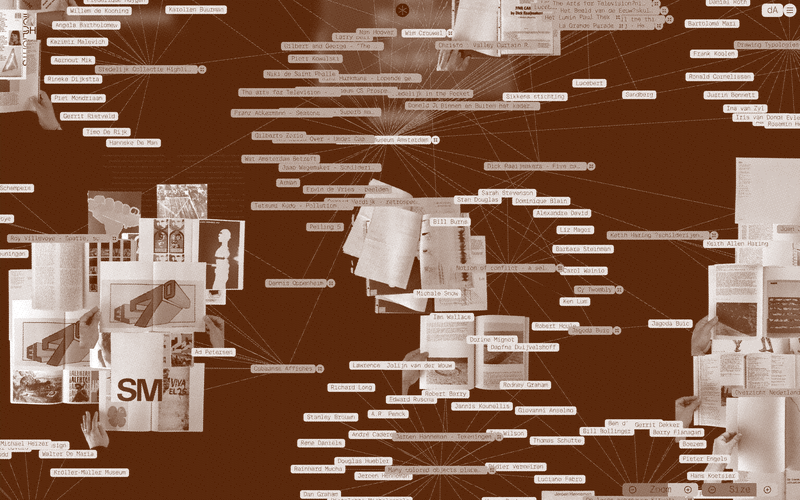
Screenshot of the Biblio-Graph networked archive.
26:04 I would also like to connect back to Clara’s intermission. does anyone have questions for the live hosts? feettiverse ? 👀 Clara mentioned how people in the Philippines were ready for catastrophe implicitly, because they those institutions or industries haven’t traditionally been there for them. As a result, the Philippines is a society that’s much more prepared to work locally and to care about the community. Another inspiration is, again, audioRadio Worm. They don't broadcast on FM, because they don’t need to have a huge audience. They work much more in a tradition of audioavant-garde music, where people were working in small-scale, connected alternative scenes. My point is: we’re not trying to recreate Meta. It’s about creating counterpoints by cultivating spacenonstandard spaces that can function differently. The Fediverse can bring mass to these counterpoints, so that networked initiatives can nourish each other, rather than then having to always fend for themselves and eventually disappearing.
27:19 Keywords in this are ‘platform alternative’ and ‘counter-tradition’, right?
27:30 We should connect these to past experiences. It’s not the first time someone has tried this. These alternatives have existed for ages in different forms.
27:50 Are there any audience questions from the chat that we can address?
28:02 There’s one question: what is this Fediverse?
28:13 It’s the idea that we have a federated digital infrastructure. This is, by the way, not something so radical or new. In fact, email is federated. But big up to these words, I feel like this section really grounds the purpose of this whole hybrid event … which is developing social and network protocols and non standard medium combinations and spaces that battle the platform homogenization (the mid) There’s no technical need for a centralized company like Google to provide you with email services. Instead, we have a shared resource, an inter-network of networks. Everyone can have their own inbox, with different providers, but still connect to each other. spaceIn the Fediverse, this kind of federated software is cultivated. For instance, Mastodon is an alternative to Twitter. There is not one centralized Mastodon server, but anyone with the required skills, time, and resources can run a Mastodon server. It looks like Twitter and it functions almost the same as Twitter, but it can be managed at a community level. How to arrange moderation? Which other instances do you as an institution want to follow or not follow? This is a subtle shift away from individual settings and responsibilities, to allowing more local institutions to be able to make decisions and take care of infrastructure together. But it works globally over the Internet as a protocol.
29:46 Great. Thank you, Michael and Sepp. federation ≠ centralization ≠ decentralization
About this Text
Senka Milutinović is a researcher, writer, and multimedia designer. They are a research tutor at Willem de Kooning Academy and are a co-editor of Screentime Airtime Facetime.
Jordi Viader Guerrero (MX/ES) is a practice-based researcher in philosophy of technology and media, currently doing a PhD at TU Delft on the reimagining of algorithmic practices for democratic engagement. His research and practice are chiefly focused on using design and theory to articulate digital technologies within wider cultural, political, and epistemic logics.
Michael Murtaugh is the course leader of the Experimental Publishing MA program (XPUB) at the Piet Zwart Institute.
Sepp Eckenhaussen is a researcher at the Institute of Network Cultures (INC). He was the leader of the Hybrid Publications group of Going Hybrid, and co-edited Screentime Airtime Facetime.
This chapter-conversation was originally recorded during the a live event Screentime Airtime Facetime, which you can watch back here: https://vimeo.com/908215511.
XPUB Special Issue: Protocols
The text below is a snippet of a conversation between Leslie, Maria, Alessia, Senka, Michel and Zuzu, students of the Experimental Publishing program of the Piet Zwart Institute, taken from their show on Radio Worm.
Harmful Protocols
00:00 Since listening to your radio broadcast last week, I was overwhelmed with this old, very old protocol, that luckily… well, I won’t say anything. And so, I started wearing, for the rest of the week the same plaid pants and striped shirt in honor of an old student that I went to school with who was… maybe a little bit like me, an outsider. But he always wore either plaid pants and a striped shirt and or vice versa. And he was picked out in the group as being…well…it just wasn’t done. can we say it is a semi-decentralized network semi-centralized on communities? That was the protocol at the time. You just didn’t wear plaids and stripes, there were certain lengths of your skirt and it couldn’t be higher, and you were sent home if your skirt was too high. Anyway, thankfully, all has changed. But why I thought about him is, because everyone laughed at him. Thanks to wiki He became kind of like a joker. And I don’t know, I don’t think he was always a joker. But I think it was kind of like his niche that the peer pressure paved out for him. He started inhaling PAM, which is a kind of anti-stick aerosol. And one day, it was the end of his life. So after hearing this word protocol, and audiohearing all the stories last Tuesday, I just had to wear this. here’s a small description of what you are listening to: 0:00-3:30: Leslie describing (the fatal consequences of) a cruel bygone protocol. 4:36-8:10: Maria sharing her ambivalent feelings towards protocols; annotation. 8:10 - end: relaxed talk between that week’s radio makers over protocols. You coming in here now is just really weird, because otherwise I would have just carried it… Here. No one else would know. I wouldn’t even tell my partner because it would sound so silly.
[00:02:19] No, it’s not silly!
02:21 So now I’m telling you and you’re going to broadcast it. It’s really weird, but it’s okay.
02:28 How do you think protocols changed from that time until now?
02:33 Well, luckily, these types of protocols don’t exist anymore, and no one would ever even imagine it. And so I hope that the protocols that we are busy with today will also disappear.
02:48 Do you think there’s a way to escape this curse of protocols in our whole life? And do you think that protocols are actually useful in a way? Or not?
03:00 I think they’re useful because they bring about change. But protocols that are just restrictive and aren’t open to change… That’s a different thing.
Relationships to Protocols
03:23 Morning! audioYou are listening to a bunch of Experimental Publishing students desperately trying to figure out what archives are, what protocols are, and what all of that means in relationship to Radio Worm.
04:25 I just wanted to say that protocols… I think they’re both, in general, unfortunately, a necessity and a torture. XPUB’s ‘Protocols for an Active Archive’ can be heard every Tuesday on Radio Worm between 10.00 - 12.00 here: https://radio.worm.org This is my personal take on protocols. I prefer to live my life without them and to practice my art, or my professional tasks, without really thinking about the protocols. They do evolve on their own eventually and then I like documenting them. But I also like breaking them because I really don’t like routine. I think it makes us stiff as people. It can be productive to have a routine, but it can also smother you. So this is my personal relationship with protocols and I think that it’s important not to follow them. Thank you.
06:02 Do you think there should be a kind of exemption that allows people to abandon a protocol completely, at any point, if it does not fit them anymore? And this is a question to Maria, but also to anyone else who might want to answer.
06:39 Unfortunately, a lot of things are sometimes of vital importance. So, as I said with my protocol, I wish that I didn’t have it and that I could live without it. But it makes my daily life doable – I can function through the protocol. I don’t think that there are exceptions to how problematic protocols are, but I think there are also no exceptions to how useful they can be. I think it’s all a matter of keeping the right balance, because, in the end, if you have too many of those you develop obsessive behaviors or something. It’s very good to have them in order to live your life through them but I prefer to leave the manual behind, so to speak.
Understanding Protocols
[00:08:03] I feel like protocols are everywhere…
08:05 Protocol, protocol, protocol…
08:07 Last night when I was sleeping, I also was thinking about protocols in a nightmare.
08:12 I am really looking forward to the moment when we are not going to talk about protocols anymore.
08:23 Today, when I had the CSS lesson there was textsome command that made me think ‘Is this so complicated because human beings are too complicated?’ Because we are so complicated, the thing we produce needs a specific rule to help other human beings understand. So, we need the protocols to easily be in communication with each other or with a computer or something.
09:01 Yes, that’s probably it.
09:05 The strange thing is that I’m a human being but it’s so difficult for me to understand these protocols, that have the original intention of making me understand easily.
09:23 It causes more confusion for you…
09:26 Yes.
09:27 Because you need to actually textunderstand the language first. It’s like a code that you need to absorb and afterwards, you can understand the protocol. But without that base, you can’t go anywhere.
09:42 It’s more difficult for me… First, I need to understand the English language, and then I need to understand the computer language… Oh my god.
About this Text
Leslie, Maria, Alessia, Senka, Michel and Zuzu, students of the Experimental Publishing program of the Piet Zwart Institute, originally recorded this conversation on Radio Worm. A snippet was played as an audio intermission during the livestream of Screentime Airtime Facetime livestream. You can listen back through this link: https://live.thehmm.nl/screentimeairtimefacetime. This text will be included in the forthcoming book XPUB Special Issue #22: Protocols.
Participatory Livecasting
What can participatory livecasting look like? Is there a playfulness in its future, and a true on- and offline collaboration between the physical world and the virtual one?
At the moment, as an online visitor of a hybrid event, you can just performanceask a question to the speaker, which may or may not be seen by the moderator. Of course, you can also textchat with each other, but there are relatively very few other ways to show what you think. Or what knowledge you have to share. That return channel from the online audience to the event and to the on-site has not yet been developed at all. That is still very simple.
This is a quote from Monique van Dusseldorp (programmer, moderator, and researcher on the future of events) during an interview The Hmm, affect lab and MU did for their research on hybrid events for the development of the Toolkit for the Inbetween. The toolkit can be found here: https://toolkitfortheinbetween.com. This research and The Hmm’s and H&D’s own experience from organizing and experimenting with online and hybrid events revealed that it’s important for an online audience to ‘feel seen’ and have a sort of agency during hybrid events. Online audiences are often treated as a nice addition, but they are never important for an event to continue. In a way, they are more like spectators. What if the event is influenced by the presence of an online audience? How can we give online visitors more agency? These were the core questions of the Participatory Livecasting research group of Going Hybrid.
Participation Equals Online Agency
During one of the first meetings we had, we agreed that a better hybrid live experience is not necessarily more immersive. We’ve experienced that more connection between audiences (on-site, online, and among each other) can also be achieved in a performancelow-barrier collaborative spreadsheet drawing session, for example. On websiteThe Hmm’s live stream website, developed by Karl Moubarak and designed by Toni Brell, online visitors are visualized by still imagea simple dot at the top of the page. Visit The Hmm’s livestream website here: https://live.thehmm.nl. When people performancesend an emote, the dot of that person for a moment changes into the emote of their choice. This is a very subtle way to let the online audience feel seen and acquire some agency: they literally claim a bit of space on the live stream page and can operate somewhat autonomously by changing the contents of this space45px * 45px area. But this agency remains tied to the online environment. We decided that, in this project, we wanted to research how the online audience’s agency can extend beyond this 45px*45px area and into the physical space of the event, and how to make a more direct connection between online and on-site audiences. We wanted to develop mechanisms and prototypes that enable the translation of input from the websiteonline audience to outputs in the spacephysical space and vice versa. This, for us, is the essence of ‘particpatory livecasting’.
Thinking Through Doing
During the project, we focused on the development of the tool Emoji Proxis & Ghost Messengers, which translates changes in the online environments (like textchat inputs, a new online performancevisitor entering the space, or a still imagereceived emote) into something that happens in the spacephysical space (like a light goes on, a smoke machine turns a vote is cast, or the program shifts). This tool is a kind of open-source plug-in we developed for The Hmm’s livestream website.
Working on this concrete prototype, it became easier to scentthink experimentally. You start to see the different ways it can be used, for different purposes. Testing, development, and participation naturally merge. During a workshop we organize in November of 2022 in Page Not Found, The Hague, we invited the audience to help us join us in building a system encompassing several different hybrid networking experiments. We explained to both audiences (online and on-site) that Emoji Proxis & Ghost Messengers runs on objecta little ESP32 module, and we taught the on-site audience to develop their own prompt. These performanceprompts would trigger small, mechanic on-site events: lights going on and off, a scentscent dispenser going off, and a objectblower turning on. During this fun experiment, we exchanged knowledge about assembling systems like these and thought together about how to situate them in the context of hybrid events.
The - for now - most advanced experiment with the tool took place during the event Screentime Airtime Facetime. By typing a simple command in the livestream chat, online audience members could change the angle of an on-site camera. In the margins of this publication, you can find the traces of this experiment: the chat commands are included as part of the chat annotation in the margins.
About this Text
Lilian Stolk is the director of The Hmm, a platform for internet culture. She was a participant of the Participatory Livecasting group of Going Hybrid.
A previous version of this chapter was published on the Going Hybrid research blog. You can read the original here: https://networkcultures.org/goinghybrid/2022/11/17/participatory-livecasting/
Online Critical Reflection, a Fable from the Past?
Digital publishing is an inseparable part of our everyday lives. At the same time, it has become a weapon in the battle for attention, clicks, and political influence. Information overload and obscure mix-ups between commerce, content, and political manipulation give a headache to readers, content producers, and publishers. In times when most content is cheap and abundant, especially independent publishers, who focus on high-quality cultural content and do not rely on endless funds from advertising have a hard time surviving the competition with large media corporations, and tech giants–now dominating not only social media but also AI. The intensifying pressure on countering fake news, keeping up with developments in tech, and protecting the democratic character of media calls for new forms of resistance for cultural critical publishing that will be able to respond to both contemporary media culture and changing reading habits.
The current situation of maneuvering between corporate and political powers puts independent publishers in a position that is counterproductive for the role and relevance they ought to play in the social and cultural realm. Creating independent critical content requires plenty of time and effort, and it is not meant to be consumed within seconds. While on the Web 2.0 content is cheap, fast, abundant, and addictive it is increasingly difficult to keep even the most dedicated readers interested as they grow more impatient, quickly distracted, and disengaged.
Is critical reflection online a mere fable from the past or does it still have a space and readership today? Could ways in which content is created and published allow the readers to gain more agency in the way they behave online? What technologies can assist them with that? Could we imagine that the same digital technologies, which are currently used for economic exploitation become a support system to stimulate reflection in the online sphere? What cultural and digital strategies could be used to create alternative ways of online publishing, that expand the room for reflection and possibly reconstitute a form of collectivity online?
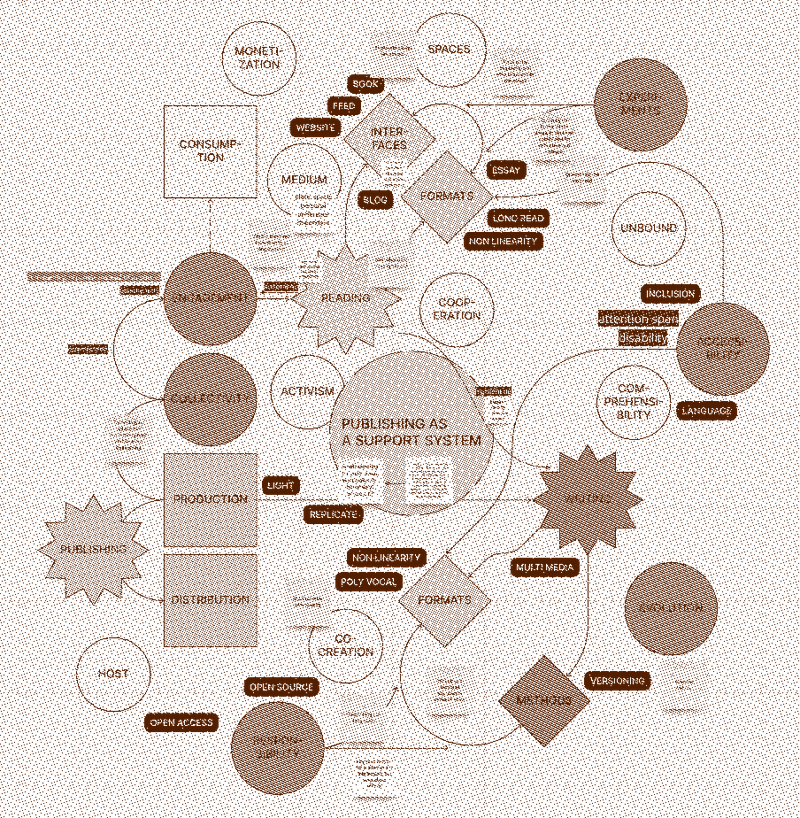
Beyond the Essay – a mindmap of the research process, created by Ania Molenda and Andrea Prins.
In the search for answers to these questions, across the past two and a half years Andrea Prins and I have been developing a research project titled Beyond the Essay: New Ways of Critical Reflection and have led a corresponding workshop series New Ways of Reading: Between Experiment and Accessibility realized in collaboration with Framer Framed in the fall of 2022. The three workshops took place in September and October of 2022. See: https://framerframed.nl/en/projecten/new-ways-of-reading. Beyond the Essay is an ongoing project and an evolving process where we start to identify some of the building elements of new spaces for critical reflection online. In our research, we are looking for possibilities to encourage reflection, engagement, collectivity, and polyvocality that would offer writers, readers, and publishers the opportunity to make critical writing more relevant for contemporary audiences. A part of our research methodology developed into conducting hands-on workshop experiments where we attempt to re-imagine critical reading, writing, and publishing through slower, more reflective ways of creating and engaging with content.
Critical reflection is a powerful tool that allows one to formulate questions, confront bias, point out contradictions, and look for new directions. Especially in a time when navigating online media becomes so complex and confusing, it is of critical importance to find ways in which we could re-discover critical reflection and tool up for it. Let’s be honest, it is not a fight, we will be able to win without technological assistance, and how we create and use computational tools also needs to be considered.
In a series of work sessions with Varia we explored three methods developed with or by Varia members. The first one focused on exploring a collective annotation system by using a textspellbook of __MAGICWORDS__; the second played around with the idea of inversing indexing formats into unexpected relational forms of reading, which they call x-dexing; and the third one unfolding an understanding of how algorithms such as word2vec could help us embrace textcomplex relations within texts instead of simplifying and quantifying them (word2complex).
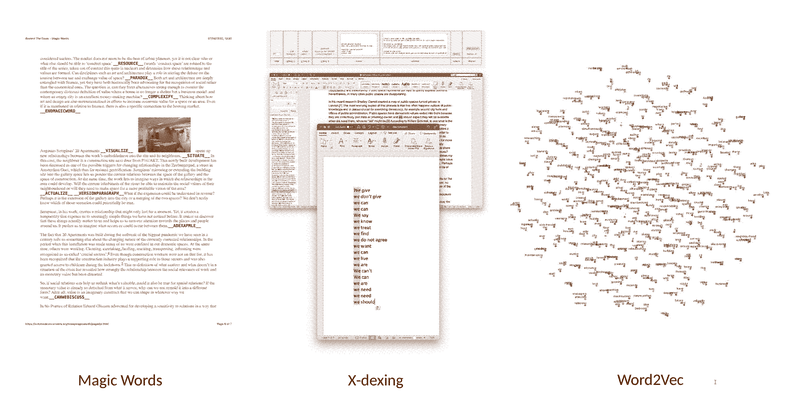
Experiments conducted at the workshop in Varia.
These exercises, with what Varia provisionally calls more-than-computational practices, were collaborative and speculative acts of questioning and discovering unobvious forms of using existing digital tools for new ways of reading existing content. What emerged out of these highly engaging experiments was, as Manetta Berends and Cristina Cochoir described it in their report from our collaboration, ‘a formation of a social environment in and around the texttext'. Manetta Berends and Cristina Cochoir, ‘More-than-computational Reflections (in the Form of a Report)’, Varia, 19 December 2022, https://varia.zone/en/more-than-computational-reflections.html. These relational approaches between readers, writers, computational tools, use protocols and their entanglements allowed us to explore spacethe spatial and collective dimension of how readers, writers, and publishers can textengage with each other through text.

Mapping dimensions of critical reflection and related practices during the workshop at Varia.
Exploring that tension further and looking for more low-threshold ways to look for potential future ways of embracing critical reflection we dove deeper into more basic ways of approaching the technology and the audience. Through different forms of experiments with assisted close reading and deep reading using at times less ethically pure technologies we aimed to engage users, who are not engaged with the critique of digital culture in their day-to-day practice. Yet, who do have a vested interest in finding new ways to engage with texttext online.
We started our event series from the premise that the quest for finding new ways of imagining critical reflection online ought to start by reclaiming agency by readers themselves. In the first workshop organized as a part of the New Ways of Reading series titled Owning Readership, textembracing text collectively through an array of deep and close reading exercises turned out to not only be joyful but also allowed to create a degree of focus and attention for reading, which the participants had not been able to experience in a long time. One of the key takeaways was the role of the interface in activating a reflective mindset by not asking too much of the user. The more complex the possibilities within the interface and the familiarity required to navigate it the more distracting and dysfunctional the reading environment has been perceived.
The second event Imagining Accessibility took up the act of writing to explore the relationship between the textmutability of the text (both in terms of its polyvocality and evolution in time) and the results this could have for increasing accessibility for various users. Here different ways of engaging with text as well as peer readers or other writers were explored through three exercises: collective writing, building up non-linearity, and summarizing with AI. Seeing the texttext as a playground of versions offered critical perspectives not only stimulating the creativity of writing but also forming a contrast with static institutional forms of text.
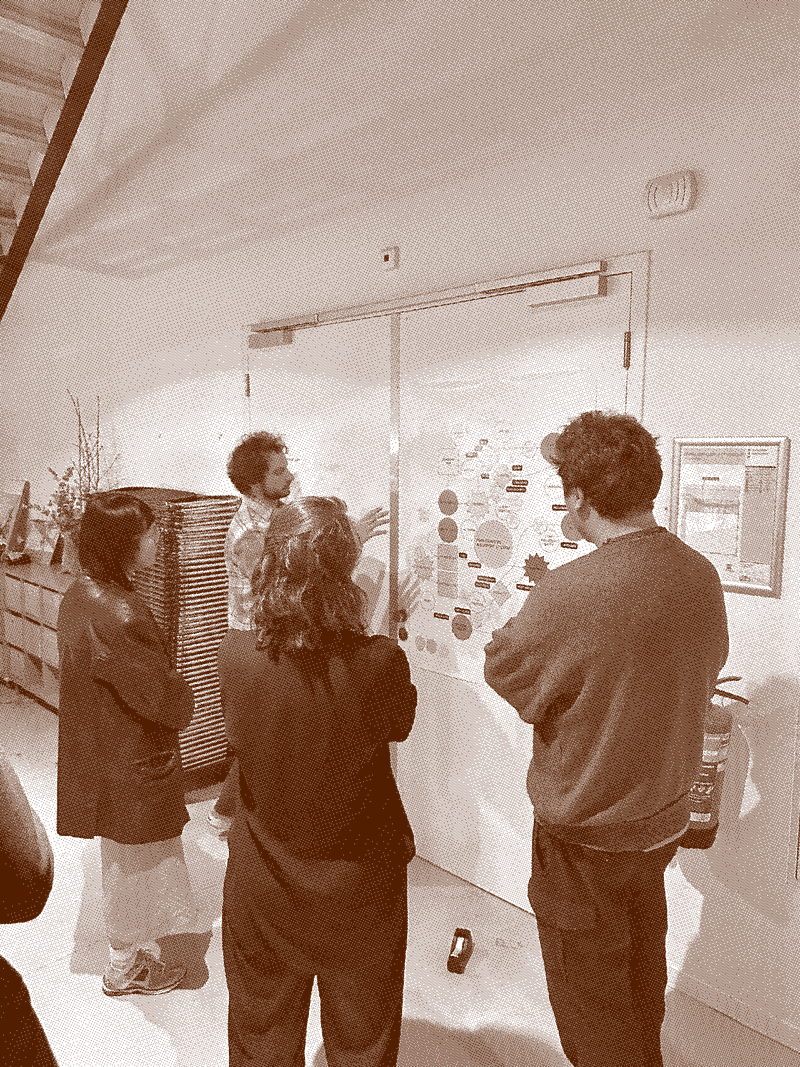
Workshop ‘New Ways of Reading: Imagining Accessibility’ at Framer Framed.
In Publishing Experiments for All, which combined a presentation and a workshop, we aimed to bring the experiences from the first two sessions together with the publisher’s perspective on the possibilities of introducing such new forms of reading and writing to the industry. The views about the future of digital publishing shared by the participants ranged from exploring the possibilities of radical change and breaking the current patterns, through imagining inter-media hybrids or cross-connections, to concerns regarding sustainability of experiments and ensuring broad spectrum of participation. New experimental forms of publishing envisioned in that session included inviting critical reflection through engaging with still imagevisual argument maps; introducing formats that would allow the readers to add their own ‘audiovoice’ or to read through the eyes of another person; and the use of good old modular publishing. At the same time, a general conclusion emerging from this and other discussions we had throughout the project seems to be that the publishing sector is and will be rather unwilling to change.
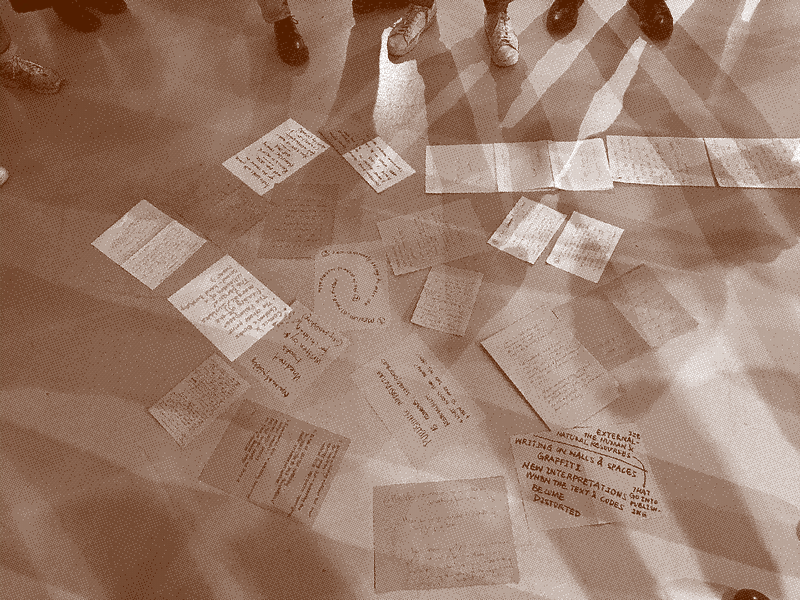
Workshop ‘New Ways of Reading: Imagining Accessibility’ at Framer Framed.
There seems to be a certain paradox between the need of urgently building forms of resistance and the general slowness with which many online users embrace the tech. Introducing new tools or methods will always require curiosity and most likely will push audiences outside of their comfort zone. Yet the experimental side of tech in its geekiness tends to create a literacy barrier that scares away many older and younger folks relying on the frictionlessness of contemporary corporate UI’s. Is critique of the digital culture bound to always be inaccessible? Is that a productive course of action? Can we create websitecritical interfaces that would also allow to build spacesafe spaces for critical reflection and at the same time create more critical mass for resistance in online media?
About this Text
Ania Molenda is an independent researcher, curator, writer, and educator on the cross-section between spatial practices, technology, ecology, and their socio-cultural impact. She was a member of the Hybrid Publications group.
A previous version of this chapter was published on the Going Hybrid research blog. You can read the original here: https://networkcultures.org/goinghybrid/2023/08/20/online-critical-reflection-a-fable-from-the-past/.
A Living Archive Is also a Dying Archive
In early April of 2022, a sub-group of the researchers involved in the Going Hybrid project came together for a first knowledge session, which was also the first physical gathering since the project’s kickoff in January. The session was dedicated to making sense of the term ‘living archives’, a task supported by generous input from both researcher Annet Dekker and artist Clara Bahlsen. A secondary goal for the session was to hear more about each team member’s interest in the project, and what the group wishes to get out of this collective research. Our team members at the time included Karl Moubarak from Hackers and Designers, Margarita Osipian from The Hmm, Angelique Spaninks and Fenna Wenselaar from MU, freelancer Hay Kranen, Laurence Scherz from the Institute of Network Cultures, and Sofia Boschat-Thorez from Varia and the Willem de Kooning Academy. Later, Carolina Pinto joined the group as a co-facilitator. Ahead of this session, members had been sharing thoughts with each using an textEtherpad. It turned out that we were interested in archives and their workflow, design, and user engagement, as well as property, licensing, care, and maintenance.
Our first expert to join the discussion was Annet Dekker. Annet is an Assistant Professor of Archival Science at the University of Amsterdam, and Visiting Lecturer at London South Bank University. In 2014, she completed her Ph.D. in the conservation of net art at Goldsmiths University of London. For the knowledge session, her contribution took the shape of a conversation through which she provided us with several pointers. For starters, she observed that most ways of archiving today still remain extremely conventional, and noted that more interesting and less normative approaches seem to originate from artists who have developed archiving as an artistic practice, or who seek strategies to preserve artworks highly susceptible to the passing of time. These proposals, however, are rarely sustainable. She also expressed skepticism towards the usefulness of the term ‘living archives’, as even the most boring archive can be regarded as ‘alive’, as long as it can be accessed, and its content can be of use.
This led the conversation more towards questions of navigation and how to think about archives from a user’s perspective. What do we want to give our audience? And since the question of user engagement was also discussed, what would the incentive be for the audience to want to contribute? Who has both time and interest in the topic? If participation is desired, then the emphasis should be on creating ideal circumstances for a conversation to happen, on an equal level. Also, related to questions of use, orientation, and agency, we spoke about organization and classification and agreed that most institutional archives follow a very standardized approach. The most notable examples of practices currently seeking to step away from these conventions come from initiatives led by North American indigenous communities. See: https://localcontexts.org. A last interesting point that came out of the conversation was the opacity surrounding selection criteria, seeing as institutions usually don’t make these explicit. This is a shame, for transparency would help to understand the motivations and subjectivities giving shape to various existing collections.
Shortly after, Clara Bahlsen introduced her project you say potato I say fuck you, a collection of still imagepictures of anthropomorphic objects started in 2006. See: https://yousaypotatoisayfuckyou.com. Clara is an artist with a background in design, visual communication, and photography.
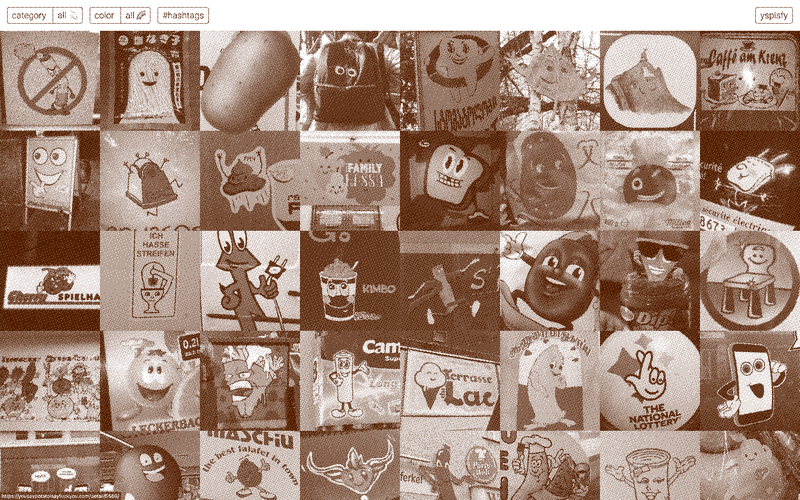
Screenshot of Clara Bahlsen’s web project you say potato I say fuck you.
As Clara explained, the collection grew with external contributions from the community she gathered around it, mostly via social networks. She maintains an interest in the collection via an websiteInstagram account, where she regularly publishes excerpts from the archive. The project has evolved very intuitively so far, and so has the organization of the images submitted, which is structured with the support of websitethe website, via a textlist of tags she attributes to each item at the time of their inclusion. These tags also assist users’ navigation. Clara further mentioned that her approach to this work is determined by her capacity to assume the workload in her free time, as the project has never received any funding, and was developed completely outside the spheres of traditional archiving. So far the only task she has managed to externalize was the design of the website, and, of course, curation, since the images are submitted to her and she chooses which ones to include. It was very interesting to our team to see how this project complemented the previous conversation we had, as the method stated by Annet is very closely linked to the specific habits and intuitions of Clara, rather than reflective of current conventions in the field of archiving.
After exchanging ideas with Annet and Clara, we had further discussions which, rather than being preoccupied with coming up with a final definition for the term ‘living archives’, revolved around the characteristics of what, in our opinion, would constitute an ideal archive. Within this post, some points from this discussion are extracted and organized under a few umbrella themes; however, these are not exhaustive. Firstly, some of our ideas were concerned with content, from its curation to its distribution, but also with its relation to documentation. Then we spoke about structure, with some interest in classification, navigation, relations, and contextualization. The last topic discussed at length was infrastructure, which includes resources, design, care, and maintenance. The common thread and central preoccupation linking all of these ideas was the question of audience involvement, and how users are to interact with the archival system and the collection.
Structure and Classification
As underlined by Annet Dekker, for users to find their way around an archive they need to be able to comprehend and make sense of the organizational logic binding the archive items together. This is why classification is a crucial aspect. According to Susan Leigh Star and Geoffrey C. Bowker, ‘a classification is a spatial, temporal or spatio-temporal segmentation of the world.’ Susan Leigh Star and Geoffrey C. Bowker, Sorting Things Out: Classification and Its Consequences (Cambridge, MA: MIT Press, 2000). In theory, a classification system should be consistent, composed of mutually exclusive categories, and complete. As both thinkers noted, however, a system has yet to demonstrate the capacity to contain these three simple criteria.
As aforementioned, together with Annet, we hardly managed to find an example of a classification system exempt from dominating institutional standards, apart from the ones developed by indigenous communities in North America. While standard (structuring) and classification are closely related, they do not designate exactly the same thing. According to Leigh Star and Bowker, ‘standard spans more than one community of practice (or site of activity). It has temporal reach as well in that it persists over time.’ As beautifully put by Jens-Erik Mai, the trouble with normativity in this domain is the maintenance of the illusion that ‘the universe of knowledge exists independently of human perception and specific cultures, and that it is accessible to humans.’ Jens-Erik Mai, ‘Ethics, Values, and Morality in Library Classifications’, Knowlegde Organization 40(3), pp. 242-253, https://jenserikmai.info/papers/2013_ethics.pdf.
There doesn’t seem to be a system that is devoid of its creator’s specific relation to the world, and the type of collection they want to classify. This is also precisely why we were interested in Clara’s approach to classifying her own content, which, contrary to what would happen in a traditional archival setting, isn’t trying to fight or dissimulate inconsistencies and gaps, and is pursued intuitively, depending on her reception of the content at the moment she describes (and thus classifies) it.
Because the classification system forces relations, differences, and meanings, it has already been a place of intervention by some practitioners. Such approaches find a beautiful embodiment in the work, achieved for example by MayDay Rooms and 0x2620 Berlin with leftove.rs, a project that seeks to create a shared online archive of radical, anti-oppressive, and working-class movements, and the material traces they leave behind. See: https://leftove.rs.
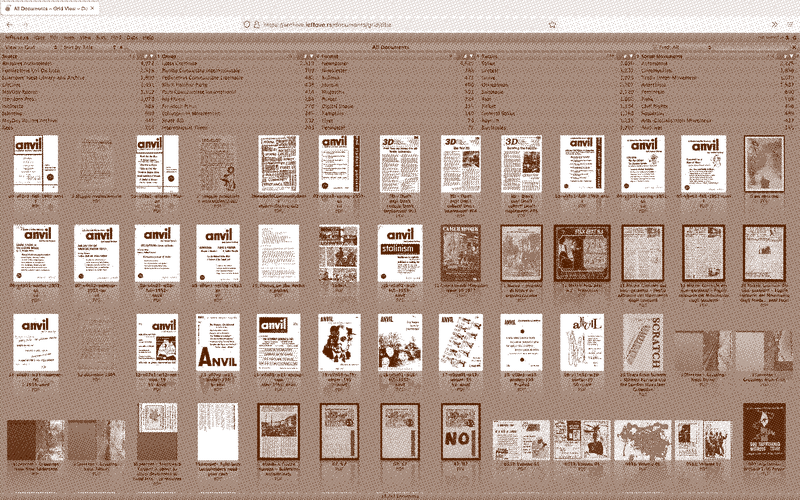
Screenshot of the Leftove.rs archive by MayDay Rooms and 0x2620 Berlin.
The collection, currently containing around 18,000 scans of historical materials like textmagazines and still imageposters, has been almost entirely OCR’ed, meaning that the content of in the archive is searchable. As noted by Rosemary Grennan ‘this might sound a minor technical point but actually is highly significant in opening up digital archives and using the actual document’s content as the basis of classification.’ ‘Somewhere between Automation and the Handmade: Interview with Rosemary Grennan’, VLTK, 9 December 2021, https://vltk.vvvvvvaria.org/w/Somewhere_between_automation_and_the_handmade. This system thus allows viewers to search for a textword or a phrase within the system, and access every document that includes the search term.
In some of our earlier collective exchanges, Hay Kranen mentioned that though it is unfeasible to provide context to every single object, it helps to make a ‘core collection’ of the most interesting objects in an archive and to create stories or articles around them. This suggestion seems to have found a potential answer in a commission work by one member of our group, which shows that subtly providing context to items can be also achieved via design. When Karl Moubarak was commissioned by Pia Chakraverti-Wuerthwein to build websitea website that archives her work, he decided to explore the concept of relationality, by ensuring that each item’s relations are highlighted when the user hovers over each one. See: https://piacw.com. This was made possible by having the textlist of all the content visible on the first page, meaning that it is also enabled by the scale of this archive. The system allows for some transparency in how the navigation works but also ties the material together with the project by emphasizing its partners.
Care and Maintenance
In our initial notes, Laurence Scherz mentioned the desire for an approach to design that would emphasize simplicity and minimalism over an accumulation of technologies and effects. Also desirable is a system that is open for others to contribute to, but also to develop further.
Angelique Spaninks raised the question of how to facilitate collaboration from outside the walls of the institution. This calls the question of openness and licensing. In How deep is your source, Aymeric Mansoux argues that free and open licenses can be very a very powerful tool to support the reuse and preservation of digital art and that institutions and archives should look closer at different models of sharing which would allow content preservation to be globally scaled. This would prevent ‘building a business model around zombified works, exploiting their every possible permutation, and thus replicating at a different scale the exploitative cultural dead-end found in the relationship between media industries and copyright.’ See, for instance, Aymeric Mansoux, ‘How Deep Is your Source?’, Bleu255, 2013, https://archive.bleu255.com/bleu255.com-texts/how-deep-is-your-source. The question of licensing here is of interest to us as it poses the question of content liveliness through a contract with the public that may allow scavenging and harvesting of content which can be collected or modified, but acquire a life of its own beyond the archive which doesn’t need to become a dead end.

How deep is your source? Illustration by Aymeric Mansoux.
Another important aspect is how to support the transmission of a system in place. When a technician leaves behind an archive or is not available, how can someone else take become a custodian? Where do we put the guidelines to steer it? Margarita Osipian remarked upon how traditionally, archives have always been embedded within museums and government institutions, but with some digital archives, there is a certain level of ‘democratization’ of archiving and acts of preservation. But then, how do we retribute the labor it takes, or what are the financial implications of this? What responsibilities do we have towards this kind of digital heritage?
The last aspect discussed by the group was the possibility to have a system decentralized through the use of a federated format. For instance, Michelle Teran brought up the example of Memory of the World, a distributed infrastructure for amateur librarians to collect still imagescans of textbooks in a shadow library. Within Memory of the World, searches can be operated via title, author names, and tags (as entered by each librarian). The project was developed by Marcell Mars and Tomislav Medak. For more info, see: https://www.memoryoftheworld.org/blog/2015/05/27/repertorium_public_library.
Curation and Content
Other—very important—topics that we discussed were curation, content, distribution, and the usage and relevance of said content. Margarita Osipian first asked the question of the type of document to be added and how selection should be operated. Central to archiving is indeed the question of who decides what gets discarded. In The Power of the Archive and Its Limits, Achille Mbembé makes the observation that the archive isn’t a piece of data but a status, a product of judgment, as an authority decides what documents are worthy of archiving or not. Achille Mbembé, ‘The Power of the Archive and Its Limits’ in Refiguring the Archive, edited by Carolyn Hamilton a.o. (Dordrecht: Kluwer Academic Publishing, 2002), pp. 19-26. On this, Victor Buchli writes that ‘what in conventional western terms might be thought of as waste is actually a resource to be cared for and nurtured’. Victor Buchli, a.o. Estate: Fugitive Images (London: Myrdle Court Press, 2011).
Regarding distribution, Margarita Osipian mentioned the project Bibliotecha, a project developed by former Piet Zwart Institute students which allows for content to be dropped into the archive and distributed with ease over a local offline network. Bibliotecha is no longer running as a website. You can read more about it on the Post-Digital Publishing Archive: http://p-dpa.net/work/bibliotecha; or on the website of Hackers & Designers: https://hackersanddesigners.nl/p/Bibliotecha.
A fine example of an archive with user’s agency comes from Karl Moubarak’s Archive of Belonging which has a feature that essentially allows a visitor to combine resources and/or artworks that are relevant to them into a ‘collection’, which they can keep in their browser or print as a reader. What makes this interesting, is that the visitors of this archive have the ability to publish their own collections back onto the websitewebsite; thus making this page a resource for any other visitor that might chance upon it. There is, for example, a section on the page that presents these collections. See: https://archiveofbelonging.org/resources/al-hasaniya-moroccan-women-s-centre-1. In this sense, the archive and its features become a sort of ‘recommendation algorithm’ that is driven by other users.
All in all, it became clear that the definition of what an archive entails is complex and opens up the door for many possible experiments. It gave us a good starting point into a research trajectory towards a truly living archive that is organic, ever-growing, shapeshifting, and subsequently slowly decaying, or, as Annet puts it: every living archive is also a dying archive.
About this Text
Sofia Boschat-Thorez is a researcher, artist and educator whose work focuses on knowledge organisation systems and their orientations. She is a tutor and researcher at the Willem de Kooning Academy and was the co-leader of the Living Archives group of Going Hybrid.
A previous version of this chapter was published on the Going Hybrid research blog. You can read the original here: https://networkcultures.org/goinghybrid/2022/09/21/a-living-archive-is-also-a-dying-archive/.
Going Hybrid Events & Publications
In this section, you will find a chronological overview of all events that took place in the context of Going Hybrid, as well as a chronological overview of publications that were published in the context of Going Hybrid.
Events
28 April 2022: The Hmm @ 4 Locations was an experimental program that took place simultaneously in Waag (Amsterdam), Het Nieuwe Instituut (Rotterdam), MU (Eindhoven), and IMPAKT (Utrecht). The aim was to create an athmosphere of hybrid togetherness. Watch back: https://live.thehmm.nl/RoAmUtEi.
21 September 2022: International Art & Wine Tasting Event took place at IMPAKT (Utrecht) and six other locations around Europe. Read a report by Andrej Kapor on the INC blog: https://networkcultures.org/goinghybrid/2023/06/20/ihwat-2022-the-event-wine-flows-and-other-things.
13 September - 25 October 2022: the series of three workshops New Ways of Reading: Publishing Experiments for All, organized by Ania Molenda and Andrea Prins, took place at Varia (Rotterdam) and Framer Framed (Amsterdam). Chapter 6 of this publication is Ania’s report of New Ways of Reading.
26 November 2022: the workshop Emoji Proxis & Ghost Messengers was organised by The Hmm and Hackers & Designers at Page Not Found (The Hague). During this event, the prototype tool of the Interactive Livecasting research group was tested and developed. Read more: https://thehmm.nl/event/workshop-emoji-proxies-ghost-messengers.
23 February 2023: Across Access Autonomy was organised by Carolina Pinto at Het Nieuwe Instituut (Rotterdam). The program explored future pathways for hybrid culture, and included a workshop from the Hybrid Publications group of Going Hybrid. Read more: https://networkcultures.org/goinghybrid/events/across-access-autonomy-rethinking-hybrid-culture.
9-10 March 2023: In-Between Media: Hybrid Tactics in the Crisis Era was the mid-project conference of Going Hybrid, organized by the INC. A first day of lectures and roundtables took place at Spui25 (Amsterdam). On the second day, at Framer Framed (Amsterdam), we hosted expert sessions, workshops, and a closing plenary session. Watch back and read reports: https://networkcultures.org/goinghybrid/2023/04/11/in-between-media-conference-report-collection.
19 April 2023: The Hmm @ Tolhuistuin (Amsterdam) was a program on the topic of non-visual internet culture, exploring alt-text as poetry, radio gardens, generative podcasts, and more. Listen back: https://live.thehmm.nl/n0n-visu4l-1nt3rnet-cultur3.
5 May 2023: the exhibition Hybrid Tales for Hybrid Times opened to celebrate 25 years of MU Hybrid Art House (Eindhoven). As part of this exhibition, MUMORIES was presented: the living archive tool developed by the Living Archives research group of Going Hybrid. Read more: https://networkcultures.org/goinghybrid/2023/05/05/mumories-at-mu-hybrid-art-house.
21 may 2023: the hybrid, interactive game Project Stargaze by artists Roos Groothuizen and Derk Over took place at IMPAKT (Utrecht). Read Ray Dolitsay’s report on the INC blog: https://networkcultures.org/goinghybrid/2023/06/22/project-stargaze-report.
31 May 2023: The Great Idle, an interactive performance game by Benjamin Pompe, took place at IMPAKT (Utrecht). Read Carolian Pinto’s report on the INC blog: https://networkcultures.org/goinghybrid/2023/06/29/the-great-idle-at-impakt-report.
20-21 June 2023: INC participated in MozFest 2023 (Amsterdam). Read Carolina Pinto’s a report on the INC blog: https://networkcultures.org/goinghybrid/2023/07/11/mozfest-2023-report.]]
4 October 2023: the radio program Living Archives TALKSHOP was broadcast by RaRaRadio (Rotterdam). In this program, the Living Archives research group discussed their findings with each others and guests. Listen back: https://www.mixcloud.com/RARARADIO_EHV/talkshop-living-archives-04102023.
21-29 October 2023: during Dutch Design Week 2023 (Eindhoven), the results were presented of two aligned projects led by Going Hybrid partners. Framer Framed presented The New Social: Hybrid Strategies for Cultural Spaces (see: https://framerframed.nl/en/projecten/the-new-social) and The Hmm, Affect Lab and Mu presented the Toolkit for the In-Between (see: https://toolkitfortheinbetween.com).
10 November 2023: the live-publication Screentime Airtime Facetime took place at the Institute of Network Cultures (Amsterdam). You are currently reading the result, but you can also watch back the original livestream: https://networkcultures.org/goinghybrid/2023/10/25/airtime-screentime-facetime-a-live-publication.
Publications
From July to December 2021, The Hmm published six texts in The Hmm Dossier #8: Hybrid Events, including reports of experiments with digital livestreams, interviews with experts, and more. ‘The Hmm Dossier #8: Hybrid Events’, The Hmm, 2021, https://thehmm.nl/dossier/dossier-8-hybrid-events.
In March of 2022, Geert Lovink and Sepp Eckenhaussen were interviewed by Witte Rook about hybrid culture, NFTs, and basic income. Esther van Rosmalen and Roelina Aukema, ‘Entrepot: Institute of Network Cultures’, Witte Rook, 22 March 2022, https://witterook.nu/artikelen/entrepot-institute-of-network-cultures.
For the Going Hybrid blog, the artist duo Labor Neunzehn wrote Reframe the Network, outlining the philosophical and technical background that informs the architecture of our web-based project All Sources Are Broken. Labor Neunzehn, ‘Reframe the Network: Parallel Narratives and Media Obsolescence as Post-Digital Publishing Practice,’ Institute of Network Cultures, 12 October 2022, https://networkcultures.org/goinghybrid/2022/10/12/reframe-the-network-parallel-narratives-and-media-obsolescence-as-post-digital-publishing-practice.
During one of it’s design sprint days, the Hybrid Publications research group of Going Hybrid created the Minizine: Elements of the Conversation Starter, which maps out the types of content that make a cultural event report worthwile. Minizine: Elements of the Conversation Starter (Amsterdam: Institute of Network Cultures, 14 November 2022), https://networkcultures.org/goinghybrid/2022/11/14/minizine-elements-of-the-conversation-starter.
Reporting on the first activities of the Participatory Livecasting research group, Clara Balaguer created the audio-text hybrid publication Please Turn the Page - ‘an abridged and imperfect transcript of multiple meetings’. Clara Balaguer, ‘Please Turn the Page’, Institute of Network Cultures, 15 March 2023, https://networkcultures.org/goinghybrid/2023/03/15/please-turn-the-page.
During the Going Hybrid conference In-Between Media: Hybrid Tactics in the Crisis Era (9-10 March 2023), a team of reporters including Kate Babin, Victor Chaix, Senka Milutinović, Jordi Viader Guerrero, Ray Dolitsay, Jasmin Leech, Valeria Ferrari, and Dunja Nešović documented the program, resulting in a conference report. ‘In-Between Media Conference Report Collection (Videos and Text)’, Institute of Network Cultures, 11 April 2023, https://networkcultures.org/goinghybrid/2023/04/11/in-between-media-conference-report-collection.
Ashley Maum and Ebissé Wakjira, who participated in the Hybrid Publications group on behalf of Framer Framed, recorded the Framer Framed Podcast: A Deep Dive into Cultural Publishing. Ashley Maum and Ebissé Wakjira, ‘Framer Framed Podcast: A Deep Dive into Cultural Publishing’, Framer Framed & Institute of Network Cultures, 11 September 2023, https://networkcultures.org/goinghybrid/2023/09/11/framer-framed-podcast-a-deep-dive-into-cultural-publishing.
In October 2023, The Hmm, MU, and affect lab launched the Toolkit for the In-between, an online space full of experimental experiences, examples, and knowledge about hybrid events. This digital toolkit is the result of an aligned research project. Explore the toolkit: https://toolkitfortheinbetween.com/.
On the 4th of October 2023, the Living Archives research group discussed their findings with each others and guests during the live radio broadcast Living Archives TALKSHOP on RaRaRadio. Listen back: https://www.mixcloud.com/RARARADIO_EHV/talkshop-living-archives-04102023.
The UKRAiNATV Manifesto (also called Hopecore Manifesto, Green-Pink Manifesto, Stream Art Manifesto and Manifesto of Hyperactivities) was published on the 5th of October 2023. Read the UKRAiNATV Manifesto: https://networkcultures.org/tactical-media-room/2023/10/05/ukrainatv-manifesto.
In December 2023, the Institute of Network Cultures published the THE VOID (T.V.) Teletext, a manifesto that imagines new media infrastructures for political communication and hybrid togetherness, and sets stage for future expanded publishing reseach at INC. Read THE VOID (T.V.) Teletext: https://networkcultures.org/void.
In 2024, Aymeric Mansoux and Clara Balaguer will be publishing Can You Hear Me? (For the Record), a quasi-fictional but totally plausible train of conversation on infrastructures, paradigms, and subjective histories of hybridity. An excerpt-turned-video of the booklet was published in Screentime Airtime Facetime under the title ‘Hybrid Trains of Thought’. Download a gallery copy of Can You Hear Me? (For the Record): https://bit.ly/canYOUhearME.
Screentime Airtime Facetime, the publication you are interacting with right now, is the final published outcome of the Going Hybrid project.
Live-Book @ The Hmm
Screentime Airtime Facetime is a live-publication. It originated as an online event, which took place on the 10th of October 2023 on the livestream platform of The Hmm. If you like, you can watch back the full livestream via https://live.thehmm.nl/screentimeairtimefacetime, and use the timeline below to navigate between the chapters.
06:58 INTRODUCTION
13:30 CHAPTER 1: SOUND AND TEMPORALITY with Carolina Valente Pinto, Heerko van der Kooij, and Lilian Stolk. Hosted by Jordi Viader Guerrero and Esther Hammelburg. Keywords: generative, voice, live, interaction
43:01 INTERMISSION 1: CAN YOU HEAR ME? with Clara Balaguer and Aymeric Mansoux
53:14 CHAPTER 2: THRESHOLDS OF ACCESS with Ania Molenda, Karl Moubarak, and Lilian Stolk. Hosted by Senka Milutinović and Chloë Arkenbout. Keywords: tool, electronics, meaning-making, accessibility
1:23:34 INTERMISSION 2: CAN YOU HEAR ME? with Clara Balaguer and Aymeric Mansoux
1:32:38 CHAPTER 3: INTERACTION & ACTIVATION with Margarita Osipian, Arjon Dunnewind, and Roos Groothuizen. Hosted by Chloë Arkenbout and Esther Hammelburg. Keywords: listening, institutional memory, contextualizing, participatory
2:03:31 INTERMISSION 3: MUMORIES TALKSHOP & INTRODUCING ETHERPORT
2:14:49 CHAPTER 4: FORMS OF HYBRIDITY with Sepp Eckenhaussen and Michael Murtaugh. Hosted by Jordi Viader Guerrero and Senka Milutinović. Keywords: collaboration, (new) audiences, prototyping, post-digital
2:44:57 INTERMISSION 4: XPUB SPECIAL ISSUE - PROTOCOLS
2:54:57 OUTRO with Geert Lovink
Colophon
On behalf of the Institute of Network Cultures, we would like to thank everyone who participated in Going Hybrid and helped shape the tools, prototypes, experiments, and other research activities. A special thanks goes out to our consortium partners: The Hmm, Hackers & Designers, Varia members Simon Browne and Artemis Gryllaki, MU, IMPAKT, Framer Framed, Willem de Kooning Academy, Anna Maria Michael, Ania Molenda, and Maria van der Togt. We are very happy to have some of you here with us today. This colophon was first published as a spoken statement during the book-event, in which many of the consortium partners participated as author-participants.
Author-participants
Clara Balaguer, Sofia Boschat-Thorez, Arjon Dunnewind, Sepp Eckenhaussen, Roos Groothuizen, Heerko van der Kooij, Ren Loren Britton (MELT), Geert Lovink, Ania Molenda, Aymeric Mansoux, Karl Moubarak, Michael Murtaugh, Margarita Osipian, Carolina Valente Pinto, and Lilian Stolk.
Author-hosts
Chloë Arkenbout, Esther Hammelburg, Senka Milutinović, and Jordi Viader Guerrero.
Annotators and reporters
Victor Chaix, Klara Debeljak, Sepp Eckenhaussen, Runs Codol Gonzalez, Haris Latic, and Giulia Timis.
Publication concept and editorial coordination
Sepp Eckenhaussen, Senka Milutinović, Carolina Valente Pinto, and Miriam Rasch.
Event and livestream production
Tommaso Campagna, Erica Gargaglione, Karl Moubarak, Carolina Valente Pinto, Giulia Timis, and Marco Wessels.
Livestream background design
Giulia Timis.
Post-production and editing
Ray Dolitsay, Sepp Eckenhaussen, Senka Milutinović, and Carolina Valente Pinto.
Copy editing
Ying-Tzu Lin.
Development of publication tool Etherport
Gijs de Heij (Open Source Publishing).
Design
Paul Bille and Lukas Engelhardt.
Printing and binding
GPS Group, Slovenia.
Publisher
Published by the Institute of Network Cultures, Amsterdam, in 2024.
ISBN: 978-90-834125-0-4
Funders
This publication is supported by Regieorgaan SIA and the Amsterdam University of Applied Science.


